D Link DIR635B3 RANGEBOOSTER N 650 Router User Manual Manual
D Link Corporation RANGEBOOSTER N 650 Router Manual
D Link >
Manual
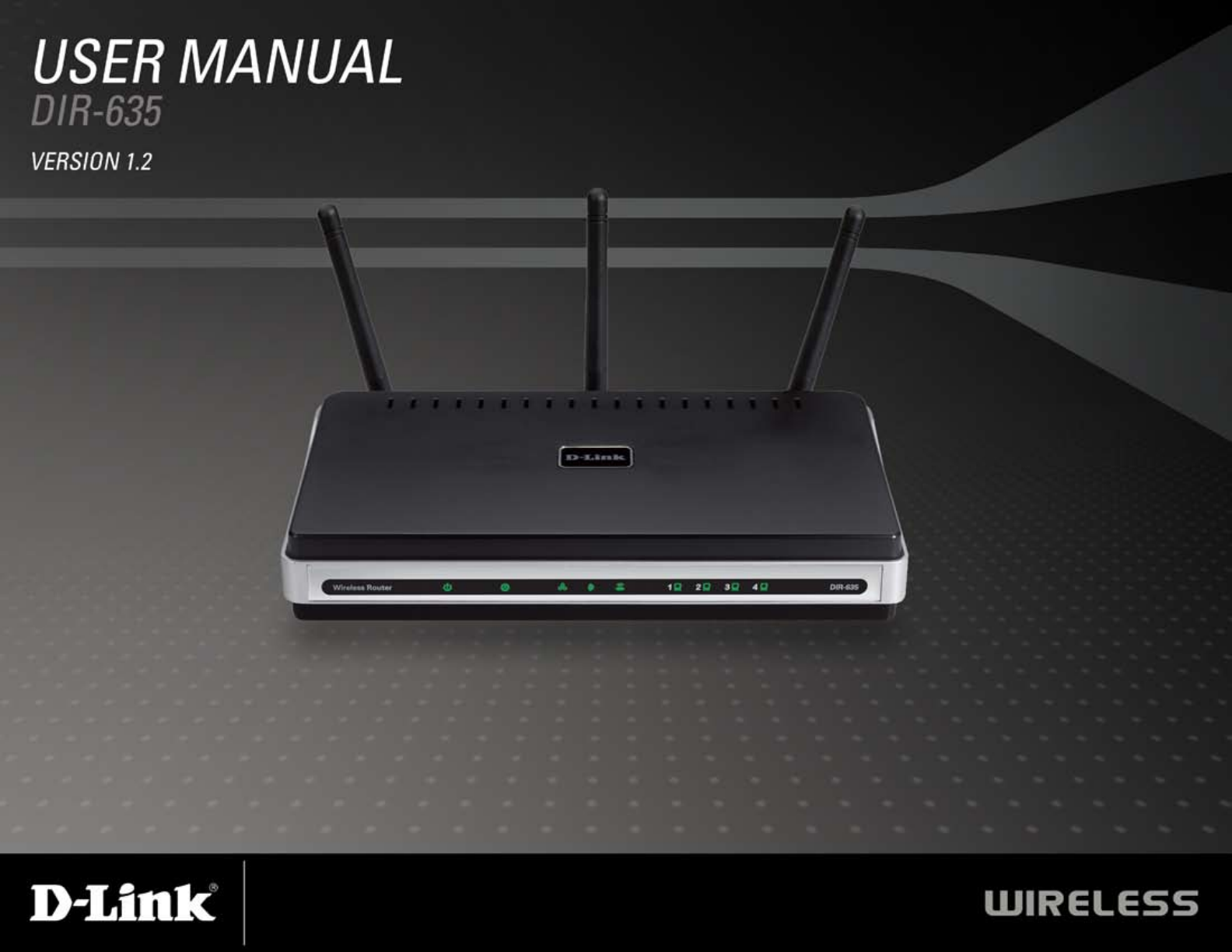

2D-Link DIR-635 User Manual
Table of Contents
Product Overview ........................................................ 4
Package Contents ...................................................4
System Requirements ............................................. 4
Introduction ..............................................................5
Features .................................................................. 6
Hardware Overview ................................................. 7
Connections .......................................................7
LEDs ..................................................................8
Installation .................................................................... 9
Before you Begin .....................................................9
Wireless Installation Considerations ...................... 10
Getting Started ......................................................11
Conguration ............................................................. 12
Web-based Conguration Utility ............................ 12
Setup Wizard ...................................................13
Manual Conguration .......................................17
Dynamic (Cable) ..........................................17
PPPoE (DSL) ............................................... 18
PPTP ............................................................19
L2TP .............................................................21
Static (assigned by ISP) ............................... 23
Big Pond .......................................................24
Wireless Settings .............................................25
Network Settings .............................................. 27
DHCP Server Settings .................................28
DHCP Reservation ....................................... 29
Virtual Server ...................................................30
Port Forwarding ............................................... 32
Application Rules .............................................33
QoS Engine ..................................................... 34
Network Filters ................................................. 36
Access Control ................................................. 37
Access Control Wizard ................................. 37
Website Filters .................................................40
Inbound Filters .................................................41
Firewall Settings ..............................................42
ALG Conguration ........................................... 43
VPN Passthrough ......................................... 43
RTSP ............................................................ 43
H.323 ............................................................43
SIP (VoIP) .................................................... 43
MMS ............................................................. 43
Router Settings ................................................44
Advanced Wireless Settings ............................45
Transmit Power ............................................ 45
802.11d Mode .............................................. 45
WISH Settings ................................................. 46
Wi-Fi Protected Setup ...................................... 48
Advanced Network Settings ............................. 50
UPnP ............................................................50
Internet Ping Block ....................................... 50
Internet Port Speed ......................................50
Multicast Streams ......................................... 50
Table of Contents

3D-Link DIR-635 User Manual
Table of Contents
Administrator Settings ...................................... 51
Change Password ........................................ 51
Remote Management ................................... 51
Time Settings ................................................... 52
SysLog ............................................................. 53
Email Settings .................................................. 54
System Settings ............................................... 55
Update Firmware ............................................. 56
DDNS ............................................................... 57
System Check .................................................. 58
Schedules ........................................................ 59
Device Information ........................................... 60
Logs ................................................................. 61
Statistics ..........................................................62
Internet Sessions ............................................. 62
Wireless ........................................................... 63
WISH Sessions ................................................ 63
Support ............................................................ 64
Wireless Security.......................................................65
What is WEP? .......................................................65
What is WPA? .......................................................66
Wireless Security Setup Wizard ............................ 67
Congure WEP ......................................................70
Congure WPA-Personal (PSK) ............................71
Congure WPA-Enterprise (RADIUS) ................... 72
Connect to a Wireless Network ................................ 74
Using Windows® XP ............................................... 74
Congure WEP ......................................................75
Congure WPA-PSK .............................................77
Troubleshooting ........................................................ 79
Wireless Basics ......................................................... 83
What is Wireless? ..................................................84
Tips ........................................................................ 86
Wireless Modes ..................................................... 87
Networking Basics .................................................... 88
Check your IP address ..........................................88
Statically Assign an IP address ............................. 89
Technical Specications........................................... 90
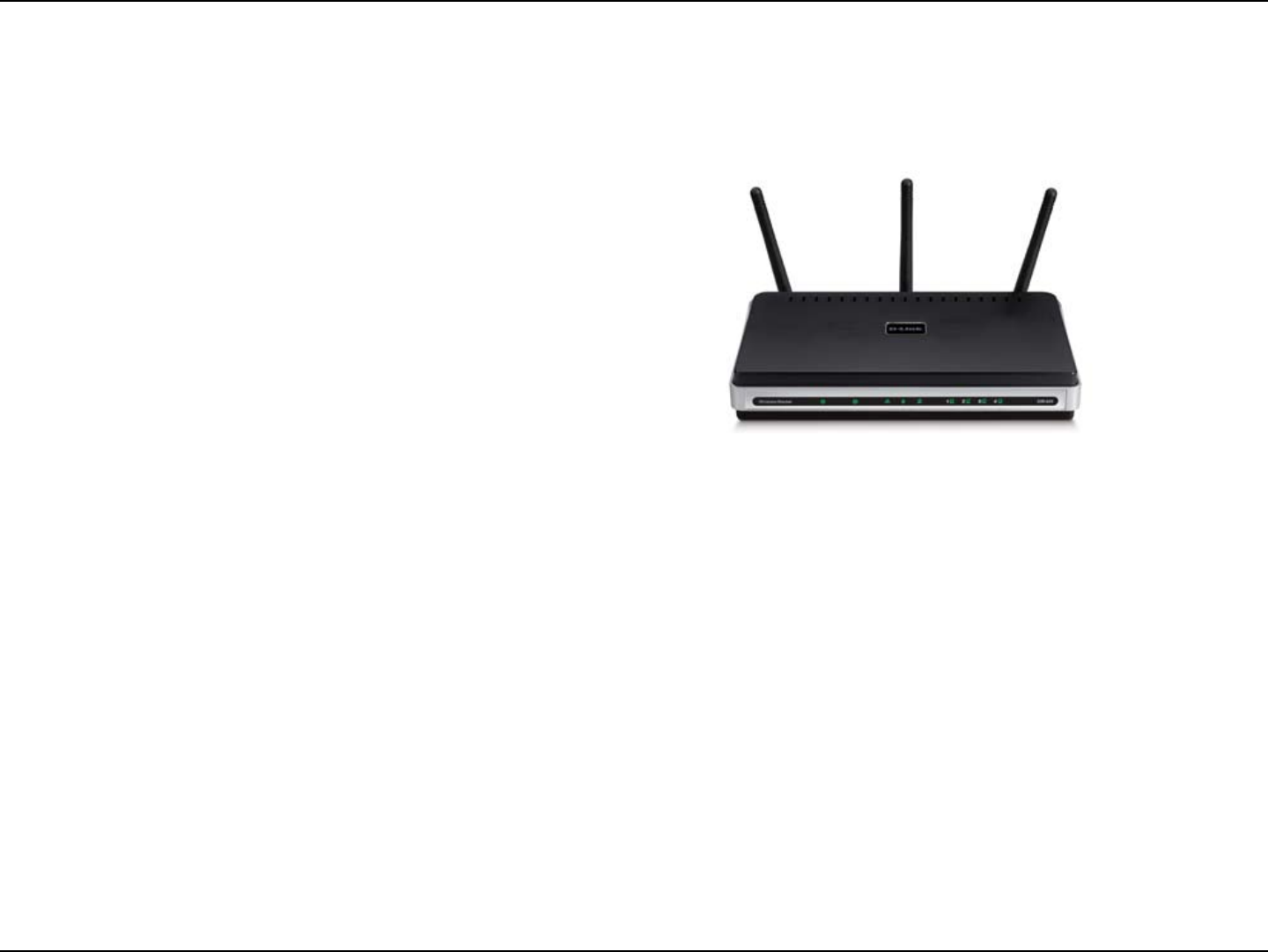
4D-Link DIR-635 User Manual
Section 1 - Product Overview
• D-Link DIR-635 RangeBooster N™ 650
• 3 Detachable Antennas
• Power Adapter
• CAT5 Ethernet Cable
• CD-ROM with Installation Wizard, User Manual,
and Special Offers
System Requirements
• Ethernet-based Cable or DSL Modem
• Computers with Windows®, Macintosh®, or Linux-based operating systems with an installed Ethernet
adapter
• Internet Explorer Version 6.0, Mozilla 1.7.12 (5.0), or Firefox 1.5 and above (for conguration)
• Installation Wizard requires Windows® XP with Service Pack 2
Package Contents
Note: Using a power supply with a different voltage rating than the one included
with the DIR-635 will cause damage and void the warranty for this product.

5D-Link DIR-635 User Manual
Section 1 - Product Overview
Introduction
TOTAL PERFORMANCE
Combines award winning router features and Draft 802.11n wireless technology to provide the best wireless performance
TOTAL SECURITY
The most complete set of security features including Active Firewall and WPA2 to protect your network against outside
intruders
TOTAL COVERAGE
Provides greater wireless signal rates even at farther distances for best-in-class Whole Home Coverage.
ULTIMATE PERFORMANCE
The D-Link RangeBooster N™ 650 (DIR-635) is a draft 802.11n compliant device that delivers real world performance of up to
14x faster than an 802.11g wireless connection (also faster than a 100Mbps wired Ethernet connection). Create a secure wireless
network to share photos, les, music, video, printers, and network storage throughout your home. Connect the RangeBooster
N™ 650 to a cable or DSL modem and share your high-speed Internet access with everyone on the network. In addition, this
Router includes a Quality of Service (QoS) engine that keeps digital phone calls (VoIP) and online gaming smooth and responsive,
providing a better Internet experience.
EXTENDED WHOLE HOME COVERAGE
Powered by RangeBooster N™ technology, this high performance router provides superior Whole Home Coverage while reducing
dead spots. The RangeBooster N™ 650 is designed for use in bigger homes and for users who demand higher performance
networking. Add a RangeBooster N™ 650 notebook or desktop adapter and stay connected to your network from virtually
anywhere in your home.
TOTAL NETWORK SECURITY
The RangeBooster N™ 650 supports all of the latest wireless security features to prevent unauthorized access, be it from over
the wireless network or from the Internet. Support for WPA and WEP standards ensure that you’ll be able to use the best possible
encryption method, regardless of your client devices. In addition, this RangeBooster N™ 650 utilizes dual active rewalls (SPI
and NAT) to prevent potential attacks from across the Internet.
* Maximum wireless signal rate derived from IEEE Standard 802.11g and Draft 802.11n specications. Actual data throughput will vary. Network conditions and
environmental factors, including volume of network trafc, building materials and construction, and network overhead, lower actual data throughput rate. Environmental
conditions will adversely affect wireless signal range.

6D-Link DIR-635 User Manual
Section 1 - Product Overview
• Faster Wireless Networking - The DIR-635 provides up to 300Mbps* wireless connection with other
802.11n wireless clients. This capability allows users to participate in real-time activities online, such as
video streaming, online gaming, and real-time audio. The performance of this 802.11n wireless router
gives you the freedom of wireless networking at speeds 14x faster than 802.11g.
• Compatible with 802.11b and 802.11g Devices - The DIR-635 is still fully compatible with the IEEE
802.11b standard, so it can connect with existing 802.11b PCI, USB and Cardbus adapters.
• LCD Display - The LCD display screen provides information regarding the router.
• Advanced Firewall Features - The Web-based user interface displays a number of advanced network
management features including:
• Content Filtering - Easily applied content ltering based on MAC Address, URL, and/or
Domain Name.
• Filter Scheduling - These lters can be scheduled to be active on certain days or for a
duration of hours or minutes.
• Secure Multiple/Concurrent Sessions - The DIR-635 can pass through VPN sessions. It
supports multiple and concurrent IPSec and PPTP sessions, so users behind the DIR-635
can securely access corporate networks.
• User-friendly Setup Wizard - Through its easy-to-use Web-based user interface, the DIR-635 lets you
control what information is accessible to those on the wireless network, whether from the Internet or from
your company’s server. Congure your router to your specic settings within minutes.
* Maximum wireless signal rate derived from IEEE Standard 802.11g and Draft 802.11n specications. Actual data throughput will vary. Network conditions and
environmental factors, including volume of network trafc, building materials and construction, and network overhead, lower actual data throughput rate. Environmental
conditions will adversely affect wireless signal range.
Features

7D-Link DIR-635 User Manual
Section 1 - Product Overview
USB
Connect a USB 1.1 or 2.0 ash
drive to congure the wireless
settings using WCN.
Reset
Pressing the Reset button restores
the router to its original factory default
settings.
LAN Ports (1-4)
Connect Ethernet devices such as
computers, switches, and hubs.
Internet Port
The auto MDI/MDIX Internet port is
the connection for the Ethernet cable
to the cable or DSL modem.
Power Receptor
Receptor for the supplied power
adapter.
Hardware Overview
Connections
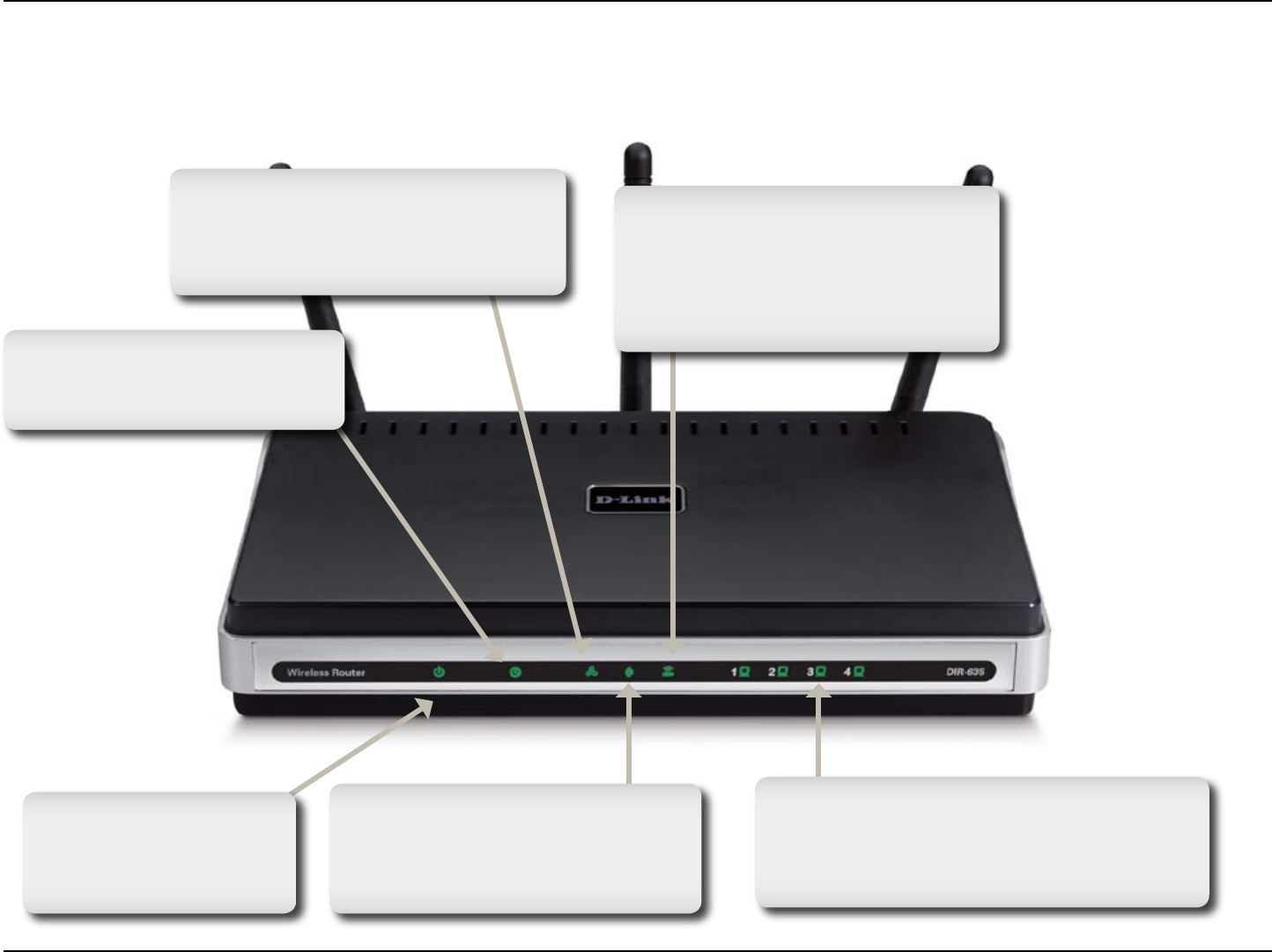
8D-Link DIR-635 User Manual
Section 1 - Product Overview
Hardware Overview
LEDs
WLAN LED
A solid light indicates that the wireless
segment is ready. This LED blinks
during wireless data transmission.
Status LED
A blinking light indicates that the
DIR-635 is ready.
Internet LED
A solid light indicates connection on the
Internet port. This LED blinks during
data transmission.
Power LED
A solid light indicates a
proper connection to the
power supply.
Local Network LEDs
A solid light indicates a connection to an
Ethernet-enabled computer on ports 1-4.
This LED blinks during data transmission.
WCN LED
Insert a USB ash drive with WCN
information. The LED will blink 3 times
if it successfully transfers the wireless
settings.

9D-Link DIR-635 User Manual
Section 2 - Installation
Before you Begin
Installation
This section will walk you through the installation process. Placement of the router is very important. Do not place the
router in an enclosed area such as a closet, cabinet, or in the attic or garage.
Please congure the router with the computer that was last connected directly to your modem. Also, you can only use
the Ethernet port on your modem. If you were using the USB connection before using the router, then you must turn off
your modem, disconnect the USB cable and connect an Ethernet cable to the Internet port on the router, and then turn
the modem back on. In some cases, you may need to call your ISP to change connection types (USB to Ethernet).
If you have DSL and are connecting via PPPoE, make sure you disable or uninstall any PPPoE software such as
WinPoet, Broadjump, or Enternet 300 from your computer or you will not be able to connect to the Internet.

10D-Link DIR-635 User Manual
Section 2 - Installation
Wireless Installation Considerations
The D-Link wireless router lets you access your network using a wireless connection from virtually anywhere within
the operating range of your wireless network. Keep in mind, however, that the number, thickness and location of
walls, ceilings, or other objects that the wireless signals must pass through, may limit the range. Typical ranges vary
depending on the types of materials and background RF (radio frequency) noise in your home or business. The key
to maximizing wireless range is to follow these basic guidelines:
1. Keep the number of walls and ceilings between the D-Link router and other network devices to a
minimum - each wall or ceiling can reduce your adapter’s range from 3-90 feet (1-30 meters.) Position
your devices so that the number of walls or ceilings is minimized.
2. Be aware of the direct line between network devices. A wall that is 1.5 feet thick (.5 meters), at a
45-degree angle appears to be almost 3 feet (1 meter) thick. At a 2-degree angle it looks over 42 feet
(14 meters) thick! Position devices so that the signal will travel straight through a wall or ceiling (instead
of at an angle) for better reception.
3. Building Materials make a difference. A solid metal door or aluminum studs may have a negative effect on
range. Try to position access points, wireless routers, and computers so that the signal passes through
drywall or open doorways. Materials and objects such as glass, steel, metal, walls with insulation, water
(sh tanks), mirrors, le cabinets, brick, and concrete will degrade your wireless signal.
4. Keep your product away (at least 3-6 feet or 1-2 meters) from electrical devices or appliances that
generate RF noise.
5. If you are using 2.4GHz cordless phones or X-10 (wireless products such as ceiling fans, lights, and
home security systems), your wireless connection may degrade dramatically or drop completely. Make
sure your 2.4GHz phone base is as far away from your wireless devices as possible. The base transmits
a signal even if the phone in not in use.
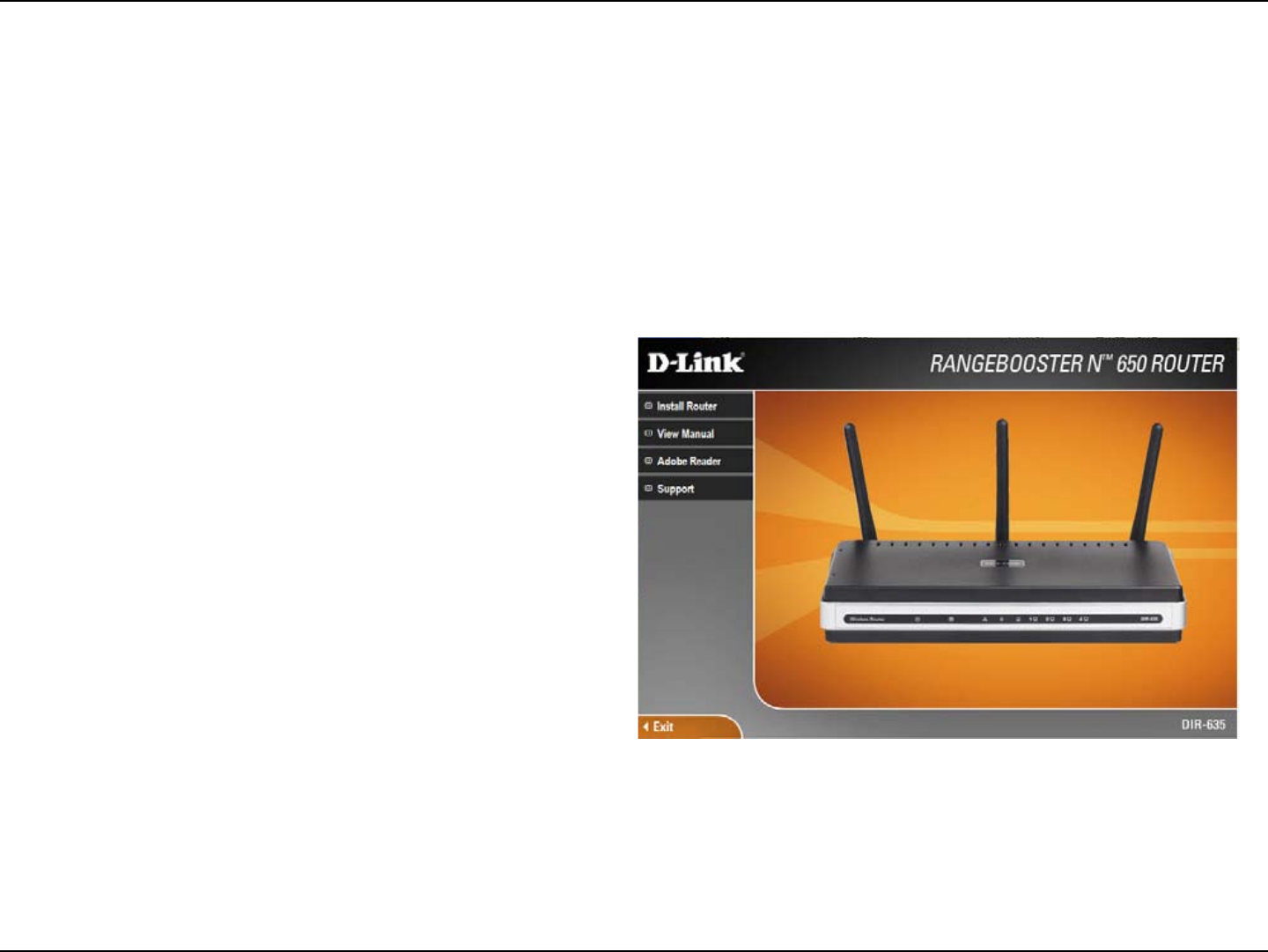
11D-Link DIR-635 User Manual
Section 2 - Installation
The DIR-635 includes a Quick Router Setup Wizard CD. Follow the simple steps below to run the Setup Wizard to
guide you quickly through the installation process.
Insert the Quick Router Setup Wizard CD in the CD-ROM drive. The step-by-step instructions that follow are shown
in Windows® XP. The steps and screens are similar for the other Windows operating systems.
If the CD Autorun function does not automatically start on your computer, go to Start > Run. In the run box type
“D:\Autorun.exe” (where D: represents the drive letter of your CD-ROM drive).
When the autorun screen appears, click the orange Install
Router button.
Getting Started
Note: It is reccomended to write down the SSID and Security Key, followed by the login password on the provided CD
holder.

12D-Link DIR-635 User Manual
Section 3 - Configuration
Configuration
This section will show you how to congure your new D-Link wireless router using the web-based conguration
utility.
Web-based Configuration Utility
To access the conguration utility, open a web-browser
such as Internet Explorer and enter the IP address of
the router (192.168.0.1).
Select Admin from the drop-down menu and then enter
your password. Leave the password blank by default.
If you get a Page Cannot be Displayed error, please
refer to the Troubleshooting section for assistance.
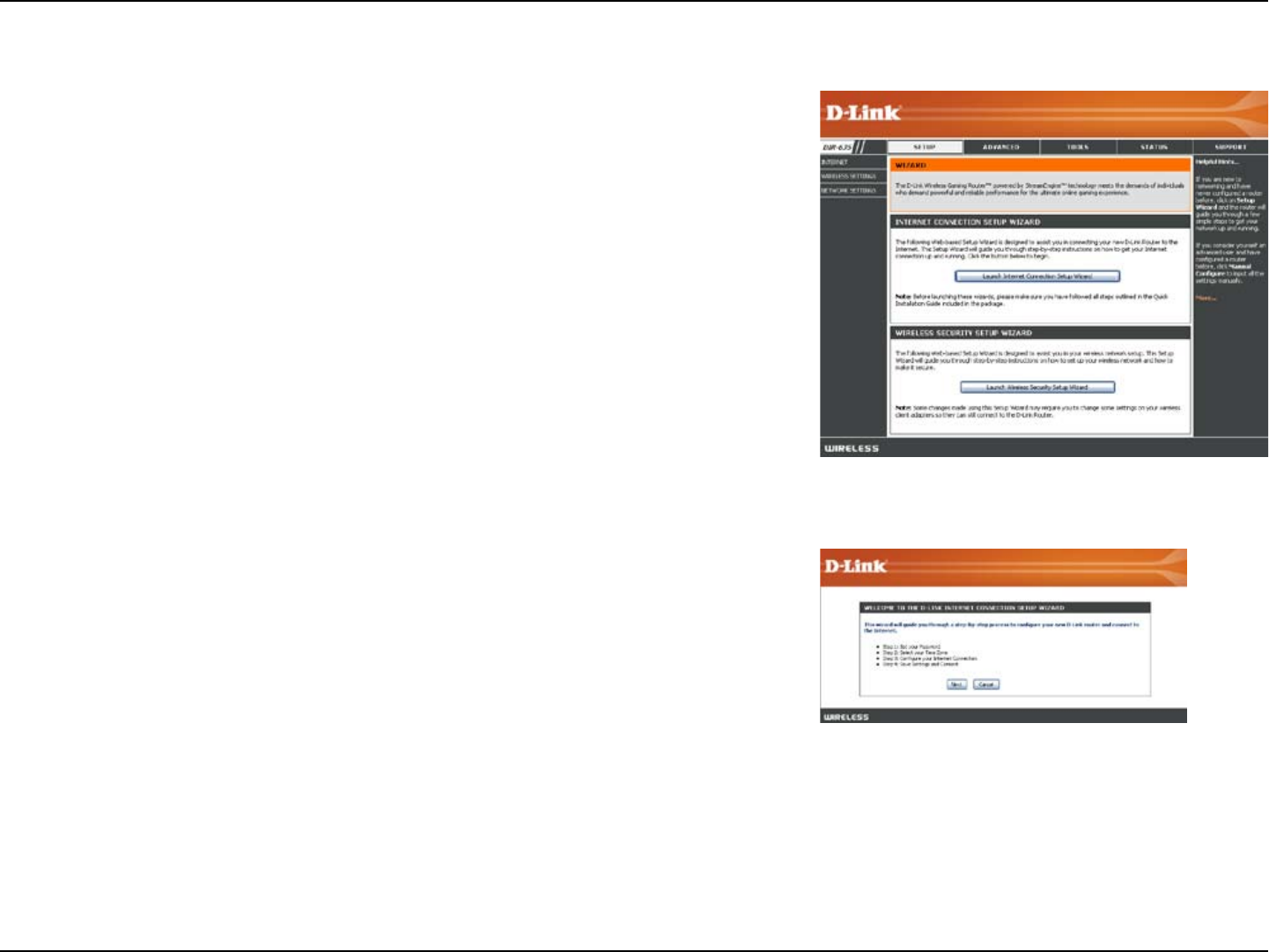
13D-Link DIR-635 User Manual
Section 3 - Configuration
Setup Wizard
You may click Setup Wizard to quickly congure your router.
If you want to enter your settings without running the wizard, click
Manual Conguration and skip to page 17.
Click Launch Internet Connection Setup Wizard to begin.
If you want to congure your wireless settings, click Launch Wireless
Security Setup Wizard and skip to page 65.
Click Next to continue.
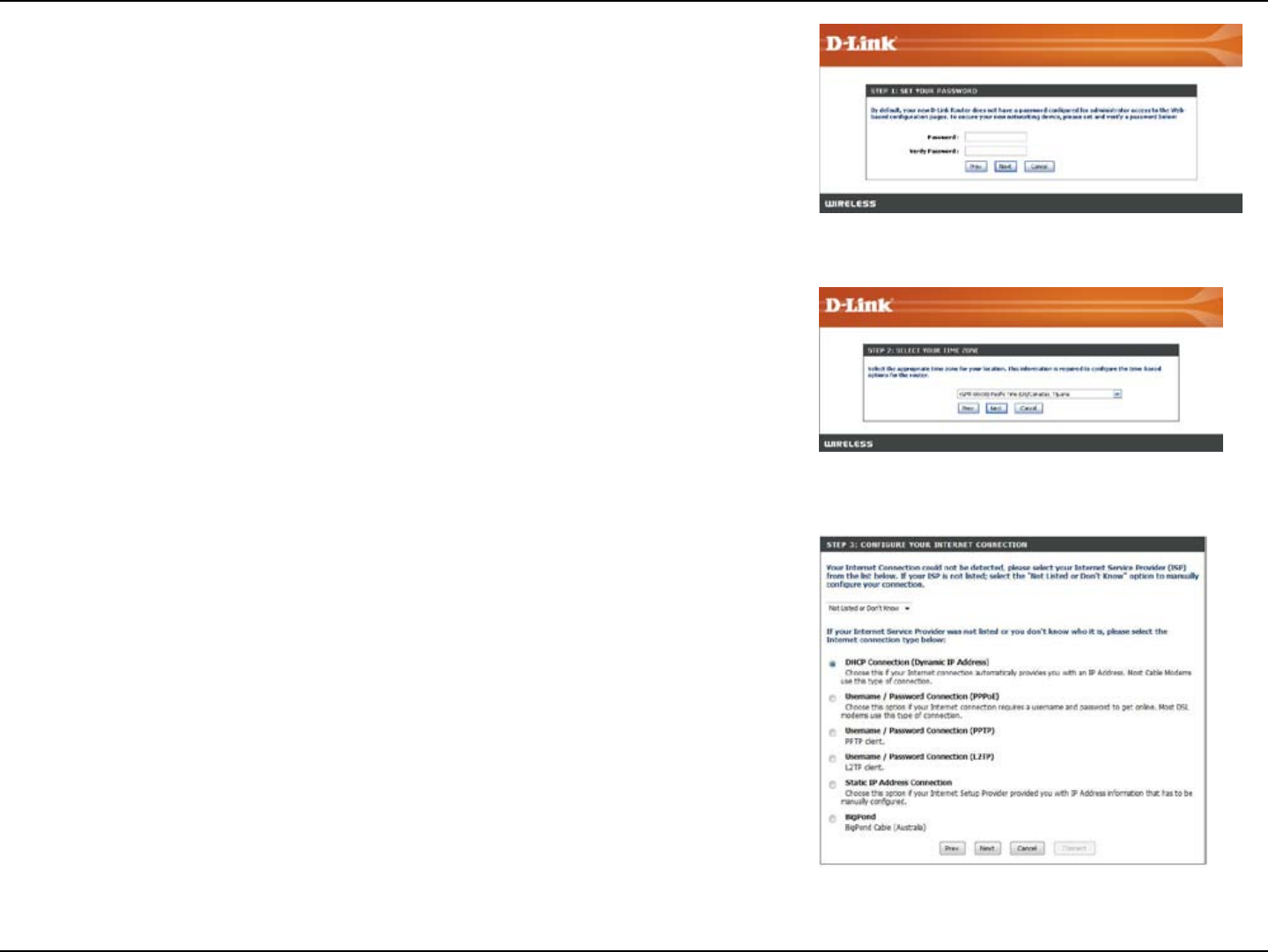
14D-Link DIR-635 User Manual
Section 3 - Configuration
Create a new password and then click Next to continue.
Select your time zone from the drop-down menu and then click Next
to continue.
Select the type of Internet connection you use and then click Next
to continue.
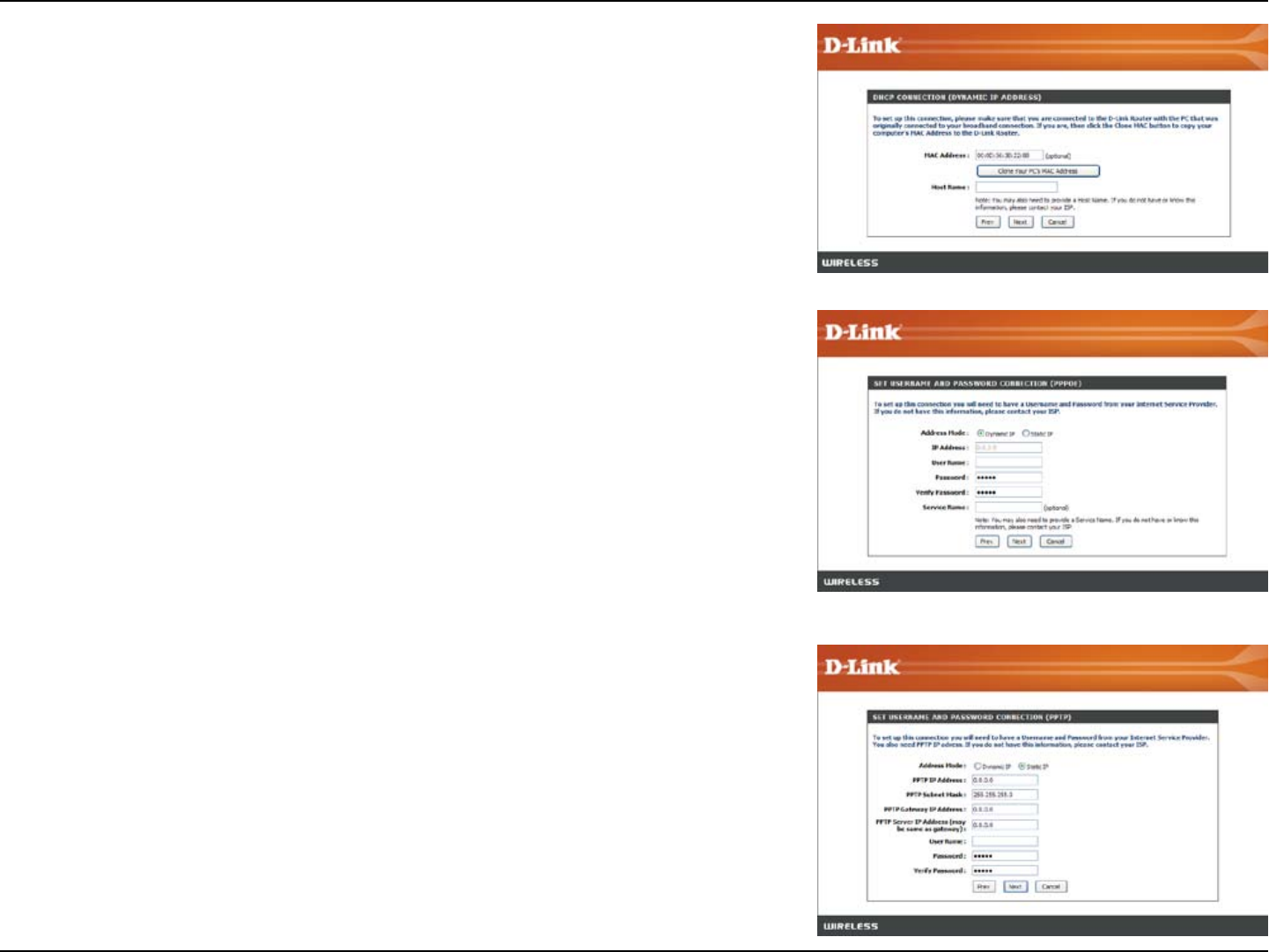
15D-Link DIR-635 User Manual
Section 3 - Configuration
If you selected Dynamic, you may need to enter the MAC address of the
computer that was last connected directly to your modem. If you are currently
using that computer, click Clone Your PC’s MAC Address and then click
Next to continue.
The Host Name is optional but may be required by some ISPs. The default
host name is the device name of the Router and may be changed.
If you selected PPPoE, enter your PPPoE username and password. Click
Next to continue.
Select Static if your ISP assigned you the IP address, subnet mask,
gateway, and DNS server addresses.
Note: Make sure to remove your PPPoE software from your computer. The
software is no longer needed and will not work through a router.
If you selected PPTP, enter your PPTP username and password. Click
Next to continue.

16D-Link DIR-635 User Manual
Section 3 - Configuration
If you selected L2TP, enter your L2TP username and password. Click Next
to continue.
If you selected Static, enter your network settings supplied by your Internet
provider. Click Next to continue.
Click Connect to save your settings. Once the router is nished rebooting,
click Continue. Please allow 1-2 minutes to connect.
Close your browser window and reopen it to test your Internet connection.
It may take a few tries to initially connect to the Internet.

17D-Link DIR-635 User Manual
Section 3 - Configuration
Select Dynamic IP (DHCP) to obtain IP Address
information automatically from your ISP. Select
this option if your ISP does not give you any IP
numbers to use. This option is commonly used
for Cable modem services.
The Host Name is optional but may be required
by some ISPs.
Check the box if you are having problems
obtaining an IP address from your ISP.
Enter the Primary DNS server IP address
assigned by your ISP.
Maximum Transmission Unit - you may need to
change the MTU for optimal performance with
your specic ISP. 1500 is the default MTU.
The default MAC Address is set to the Internet
port’s physical interface MAC address on the
Broadband Router. It is not recommended that
you change the default MAC address unless
required by your ISP. You can use the Clone
Your PC’s MAC Address button to replace
the Internet port’s MAC address with the MAC
address of your Ethernet card.
My Internet
Connection:
Host Name:
MAC Address:
Manual Configuration
Dynamic (Cable)
DNS Addresses:
MTU:
Use Unicasting:
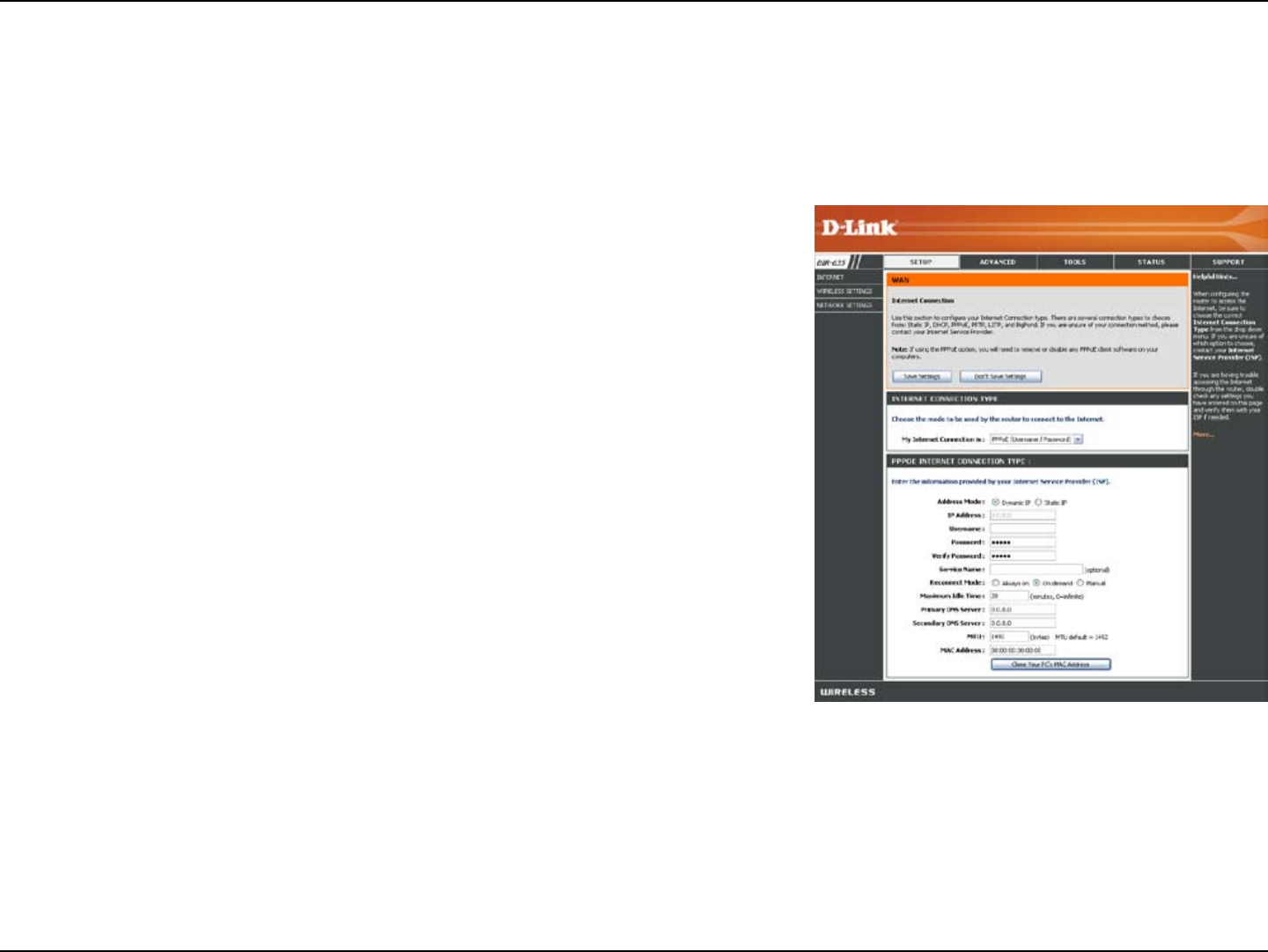
18D-Link DIR-635 User Manual
Section 3 - Configuration
Select PPPoE (Username/Password) from the drop-down menu.
Select Static if your ISP assigned you the IP address, subnet mask,
gateway, and DNS server addresses. In most cases, select Dynamic.
Enter the IP address (Static PPPoE only).
Enter your PPPoE user name.
Enter your PPPoE password and then retype the password in the next
box.
Enter the ISP Service Name (optional).
Select either Always-on, On-Demand, or Manual.
Enter the Primary and Secondary DNS Server Addresses (Static PPPoE
only).
Enter a maximum idle time during which the Internet connection is maintained during inactivity. To disable this feature,
enable Auto-reconnect.
Maximum Transmission Unit - you may need to change the MTU for optimal performance with your specic ISP. 1492 is
the default MTU.
The default MAC Address is set to the Internet port’s physical interface MAC address on the Broadband Router. It is not
recommended that you change the default MAC address unless required by your ISP. You can use the Clone Your PC’s
MAC Address button to replace the Internet port’s MAC address with the MAC address of your Ethernet card.
My Internet
Connection:
Address Mode:
IP Address:
User Name:
Password:
Service Name:
Reconnection Mode:
Maximum Idle Time:
DNS Addresses:
MTU:
MAC Address:
Internet Setup
PPPoE (DSL)
Choose PPPoE (Point to Point Protocol over Ethernet) if your ISP uses a PPPoE connection. Your ISP will provide
you with a username and password. This option is typically used for DSL services. Make sure to remove your PPPoE
software from your computer. The software is no longer needed and will not work through a router.
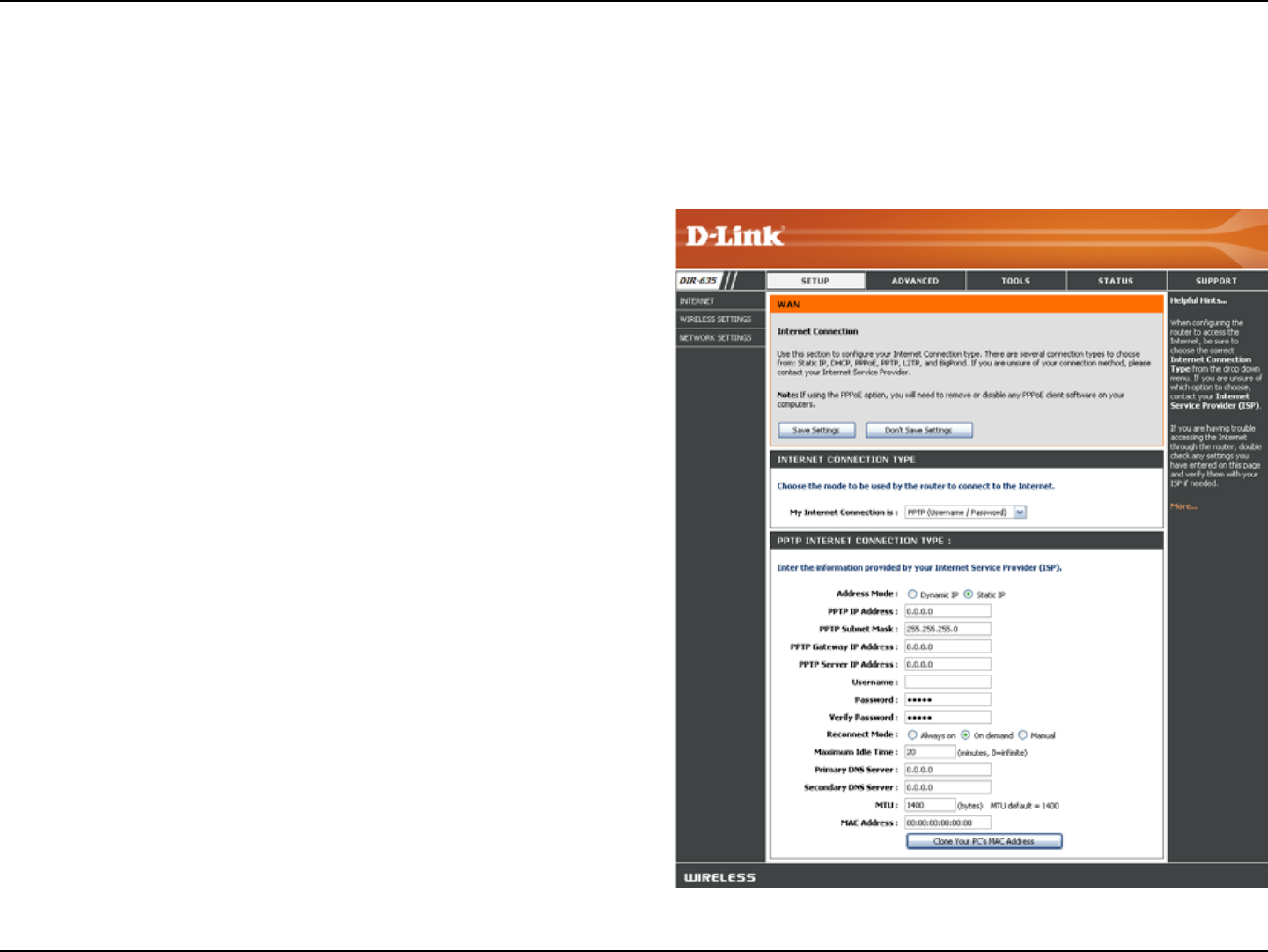
19D-Link DIR-635 User Manual
Section 3 - Configuration
Select Static if your ISP assigned you the IP address,
subnet mask, gateway, and DNS server addresses. In
most cases, select Dynamic.
Enter the IP address (Static PPTP only).
Enter the Primary and Secondary DNS Server Addresses
(Static PPTP only).
Enter the Gateway IP Address provided by your ISP.
Enter the Server IP provided by your ISP (optional).
Enter your PPTP username.
Enter your PPTP password and then retype the password
in the next box.
Select either Always-on, On-Demand, or Manual.
Enter a maximum idle time during which the Internet
connection is maintained during inactivity. To disable this
feature, enable Auto-reconnect.
The DNS server information will be supplied by your ISP
(Internet Service Provider.)
Address Mode:
PPTP IP Address:
PPTP Subnet
Mask:
PPTP Gateway:
PPTP Server IP:
Internet Setup
PPTP
Choose PPTP (Point-to-Point-Tunneling Protocol ) if your ISP uses a PPTP connection. Your ISP will provide you with
a username and password. This option is typically used for DSL services.
Username:
Password:
Reconnect Mode:
Maximum Idle
Time:
DNS Servers:

20D-Link DIR-635 User Manual
Section 3 - Configuration
Maximum Transmission Unit - you may need to change the MTU for optimal performance with your specic ISP. 1452
is the default MTU.
The default MAC Address is set to the Internet port’s physical interface MAC address on the Broadband Router. It is not
recommended that you change the default MAC address unless required by your ISP. You can use the Clone Your PC’s
MAC Address button to replace the Internet port’s MAC address with the MAC address of your Ethernet card.
MTU:
MAC Address:

21D-Link DIR-635 User Manual
Section 3 - Configuration
Select Static if your ISP assigned you the IP address,
subnet mask, gateway, and DNS server addresses. In
most cases, select Dynamic.
Enter the L2TP IP address supplied by your ISP (Static
only).
Enter the Subnet Mask supplied by your ISP (Static
only).
Enter the Gateway IP Address provided by your ISP.
Enter the Server IP provided by your ISP (optional).
Enter your L2TP username.
Enter your L2TP password and then retype the password
in the next box.
Select either Always-on, On-Demand, or Manual.
Enter a maximum idle time during which the Internet
connection is maintained during inactivity. To disable this
feature, enable Auto-reconnect.
Enter the Primary and Secondary DNS Server Addresses
(Static L2TP only).
Address Mode:
L2TP IP Address:
L2TP Subnet Mask:
L2TP Gateway:
L2TP Server IP:
Username:
Password:
Reconnect Mode:
Maximum Idle Time:
DNS Servers:
Internet Setup
L2TP
Choose L2TP (Layer 2 Tunneling Protocol) if your ISP uses a L2TP connection. Your ISP will provide you with a
username and password. This option is typically used for DSL services.

22D-Link DIR-635 User Manual
Section 3 - Configuration
MTU:
Clone MAC
Address:
Maximum Transmission Unit - you may need to change the MTU for optimal performance with your specic ISP. 1464 is
the default MTU.
The default MAC Address is set to the Internet port’s physical interface MAC address on the Broadband Router. It is not
recommended that you change the default MAC address unless required by your ISP. You can use the Clone Your PC’s
MAC Address button to replace the Internet port’s MAC address with the MAC address of your Ethernet card.

23D-Link DIR-635 User Manual
Section 3 - Configuration
Enter the IP address assigned by your ISP.
Enter the Subnet Mask assigned by your ISP.
Enter the Gateway assigned by your ISP.
The DNS server information will be supplied by your
ISP (Internet Service Provider.)
Maximum Transmission Unit - you may need to
change the MTU for optimal performance with your
specic ISP. 1500 is the default MTU.
The default MAC Address is set to the Internet port’s
physical interface MAC address on the Broadband
Router. It is not recommended that you change the
default MAC address unless required by your ISP.
You can use the Clone Your PC’s MAC Address
button to replace the Internet port’s MAC address
with the MAC address of your Ethernet card.
IP Address:
Subnet Mask:
Default Gateway:
DNS Servers:
MTU:
MAC Address:
Internet Setup
Static (assigned by ISP)
Select Static IP Address if all the Internet port’s IP information is provided to you by your ISP. You will need to enter in the IP address,
subnet mask, gateway address, and DNS address(es) provided to you by your ISP. Each IP address entered in the elds must be in the
appropriate IP form, which are four octets separated by a dot (x.x.x.x). The Router will not accept the IP address if it is not in this format.
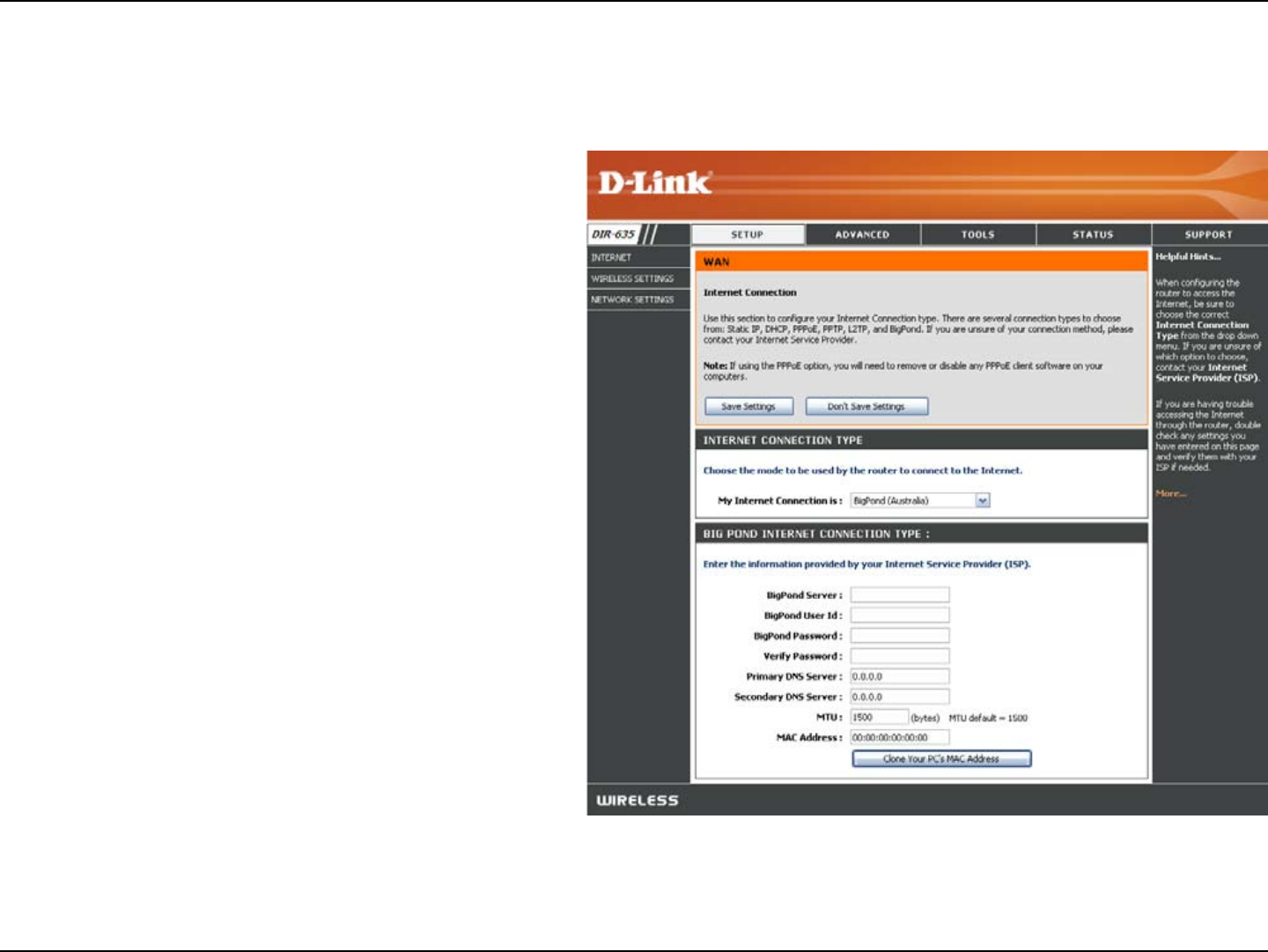
24D-Link DIR-635 User Manual
Section 3 - Configuration
Enter the IP address of the login server.
Enter your BigPond username.
Enter your BigPond password and then retype
the password in the next box.
The DNS server information will be supplied
by your ISP (Internet Service Provider.)
Maximum Transmission Unit - you may need
to change the MTU for optimal performance
with your specic ISP. 1500 is the default
MTU.
The default MAC Address is set to the
Internet’s physical interface MAC address on
the Broadband Router. It is not recommended
that you change the default MAC address
unless required by your ISP. You can use the
Clone Your PC’s MAC Address button to
replace the Internet port’s MAC address with
the MAC address of your Ethernet card.
BigPond Server:
BigPond Username:
BigPond Password:
DNS Servers:
MTU:
MAC Address:
Internet Setup
Big Pond
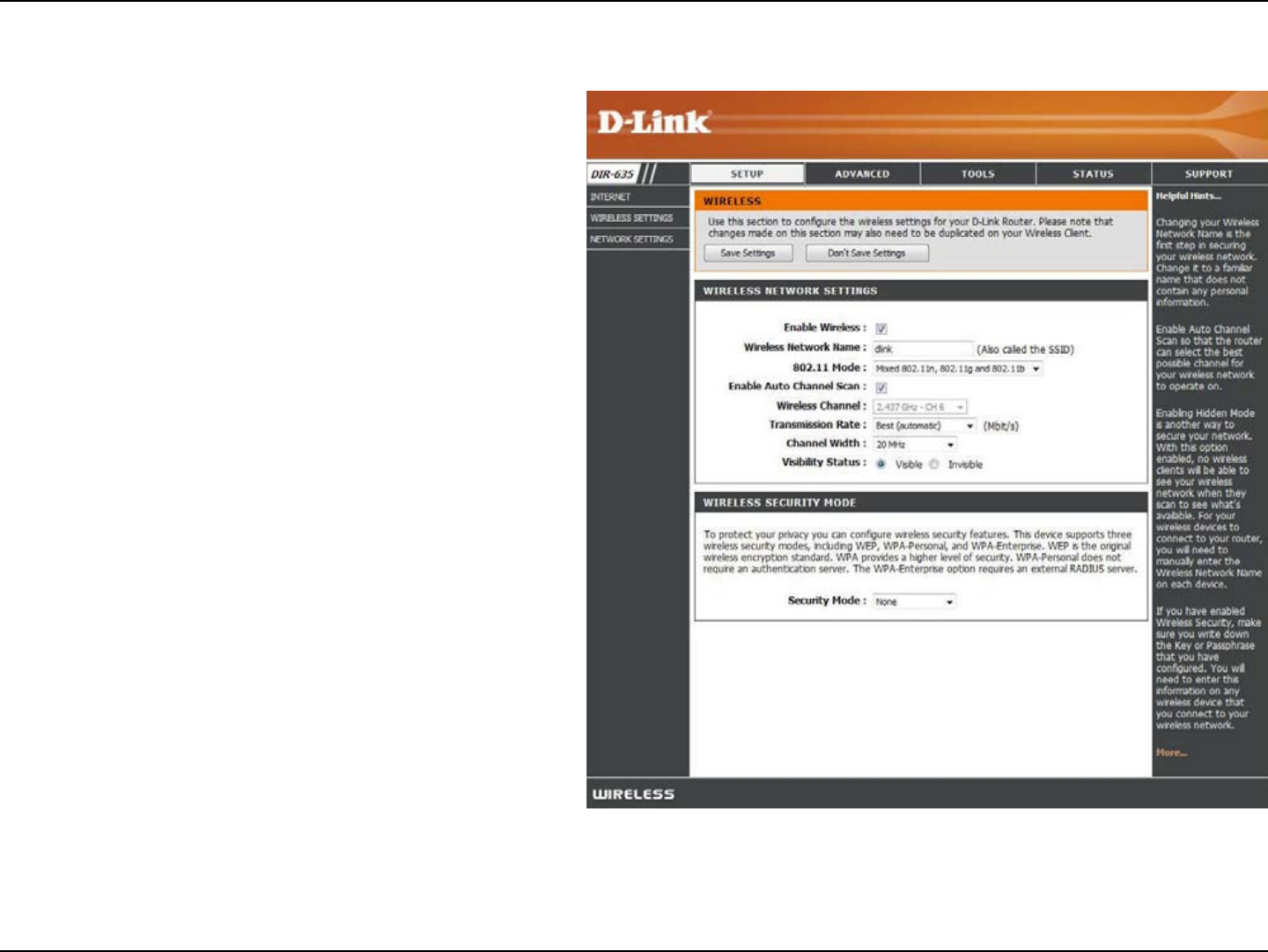
25D-Link DIR-635 User Manual
Section 3 - Configuration
Check the box to enable the wireless function.
If you do not want to use wireless, uncheck the
box to disable all the wireless functions.
Service Set Identier (SSID) is the name of your
wireless network. Create a name using up to 32
characters. The SSID is case-sensitive.
The Auto Channel Scan setting can be selected
to allow the DIR-635 to choose the channel with
the least amount of interference.
Indicates the channel setting for the DIR-635.
By default the channel is set to 6. The Channel
can be changed to t the channel setting for an
existing wireless network or to customize the
wireless network. If you enable Auto Channel
Scan, this option will be greyed out.
Select one of the following:
802.11g Only - Select if all of your wireless
clients are 802.11g.
Mixed 802.11g and 802.11b - Select if you
are using both 802.11b and 802.11g wireless
clients.
802.11b Only - Select if all of your wireless
clients are 802.11b.
802.11n Only - Select only if all of your wireless
clients are 802.11n.
Mixed 802.11n, 802.11b, and 802.11g - Select if you are using a mix of 802.11n, 11g, and 11b wireless clients.
Mixed 802.11n and 802.11g - Select if you are using a mix of 802.11n and 802.11g wireless clients.
Enable Wireless:
Enable Auto
Channel Scan:
Wireless Settings
Wireless Network
Name:
Wireless Channel:
802.11 Mode:

26D-Link DIR-635 User Manual
Section 3 - Configuration
Select the Channel Width:
Auto 20/40 - Select if you are using both 802.11n and non-802.11n wireless devices.
20MHz - This is the default setting. Select if you are not using any 802.11n wireless clients.
Select the transmit rate. It is strongly suggested to select Best (Auto) for best performance.
Select Invisible if you do not want the SSID of your wireless network to be broadcasted by the DIR-635. If Invisible is selected,
the SSID of the DIR-635 will not be seen by Site Survey utilities so your wireless clients will have to know the SSID of your
DIR-635 in order to connect to it.
Refer to page 65 for more information regarding wireless security.
Visibility Status:
Wireless Security:
Transmission Rate:
Channel Width:

27D-Link DIR-635 User Manual
Section 3 - Configuration
This section will allow you to change the local network settings of the router and to congure the DHCP settings.
Network Settings
Enter the IP address of the router. The default IP
address is 192.168.0.1.
If you change the IP address, once you click Apply,
you will need to enter the new IP address in your
browser to get back into the conguration utility.
Enter the Subnet Mask. The default subnet mask is
255.255.255.0.
Enter the Domain name (Optional).
Uncheck the box to transfer the DNS server
information from your ISP to your computers. If
checked, your computers will use the router for a
DNS server.
IP Address:
Subnet Mask:
Local Domain:
Enable DNS Relay:

28D-Link DIR-635 User Manual
Section 3 - Configuration
Check this box to enable the DHCP server on your router. Uncheck to
disable this function.
Enter the starting and ending IP addresses for the DHCP server’s IP
assignment.
Note: If you statically (manually) assign IP addresses to your computers
or devices, make sure the IP addresses are outside of this range or you
may have an IP conict.
The length of time for the IP address lease. Enter the Lease time in
minutes.
Enable this feature to broadcast your networks DHCP server to LAN/
WLAN clients.
NetBIOS allows LAN hosts to discover all other computers within the
network, enable this feature to allow the DHCP Server to offer NetBIOS
conguration settings.
Enable this feature to allow WINS information to be learned from the
WAN side, disable to allow manual conguration.
This feature allows the conguration of a NetBIOS ‘domain’ name under which network hosts operates. This setting has no
effect if the ‘Learn NetBIOS information from WAN’ is activatede.”
Select the different type oif NetBIOS node; Broadcast only, Point-to-Point, Mixed-mode and Hybrid.
Enter your WINS IP address
Enable DHCP
Server:
DHCP IP Address
Range:
DHCP Lease Time:
Always Broadcast:
NetBIOS
Announcement:
Learn NetBIOS
from WAN:
NetBIOS Scope:
NetBIOS Node:
WINS IP Address:
DHCP Server Settings
DHCP stands for Dynamic Host Control Protocol. The DIR-635 has a built-in DHCP server. The DHCP Server will automatically assign
an IP address to the computers on the LAN/private network. Be sure to set your computers to be DHCP clients by setting their TCP/IP
settings to “Obtain an IP Address Automatically.” When you turn your computers on, they will automatically load the proper TCP/IP settings
provided by the DIR-635. The DHCP Server will automatically allocate an unused IP address from the IP address pool to the requesting
computer. You must specify the starting and ending address of the IP address pool.

29D-Link DIR-635 User Manual
Section 3 - Configuration
DHCP Reservation
If you want a computer or device to always have the same IP address assigned, you can create a DHCP reservation.
The router will assign the IP address only to that computer or device.
Note: This IP address must be within the DHCP IP Address Range.
Check this box to enable the reservation.
Enter the computer name or select from the
drop-down menu and click <<.
Enter the IP address you want to assign to the
computer or device. This IP Address must be
within the DHCP IP Address Range.
Enter the MAC address of the computer or
device.
If you want to assign an IP address to the
computer you are currently on, click this button
to populate the elds.
Click Save to save your entry. You must click
Save Settings at the top to activate your
reservations.
Enable:
Computer Name:
IP Address:
MAC Address:
Copy Your PC’s
MAC Address:
Save:

30D-Link DIR-635 User Manual
Section 3 - Configuration
The DIR-635 can be congured as a virtual server so that remote users accessing Web or FTP services via the public
IP address can be automatically redirected to local servers in the LAN (Local Area Network).
The DIR-635 rewall feature lters out unrecognized packets to protect your LAN network so all computers networked
with the DIR-635 are invisible to the outside world. If you wish, you can make some of the LAN computers accessible
from the Internet by enabling Virtual Server. Depending on the requested service, the DIR-635 redirects the external
service request to the appropriate server within the LAN network.
The DIR-635 is also capable of port-redirection meaning incoming trafc to a particular port may be redirected to a
different port on the server computer.
Each virtual service that is created will be listed at the bottom of the screen in the Virtual Servers List. There are
pre-dened virtual services already in the table. You may use them by enabling them and assigning the server IP to
use that particular virtual service.
For a list of ports for common applications, please visit http://support.dlink.com/faq/view.asp?prod_id=1191.
Virtual Server
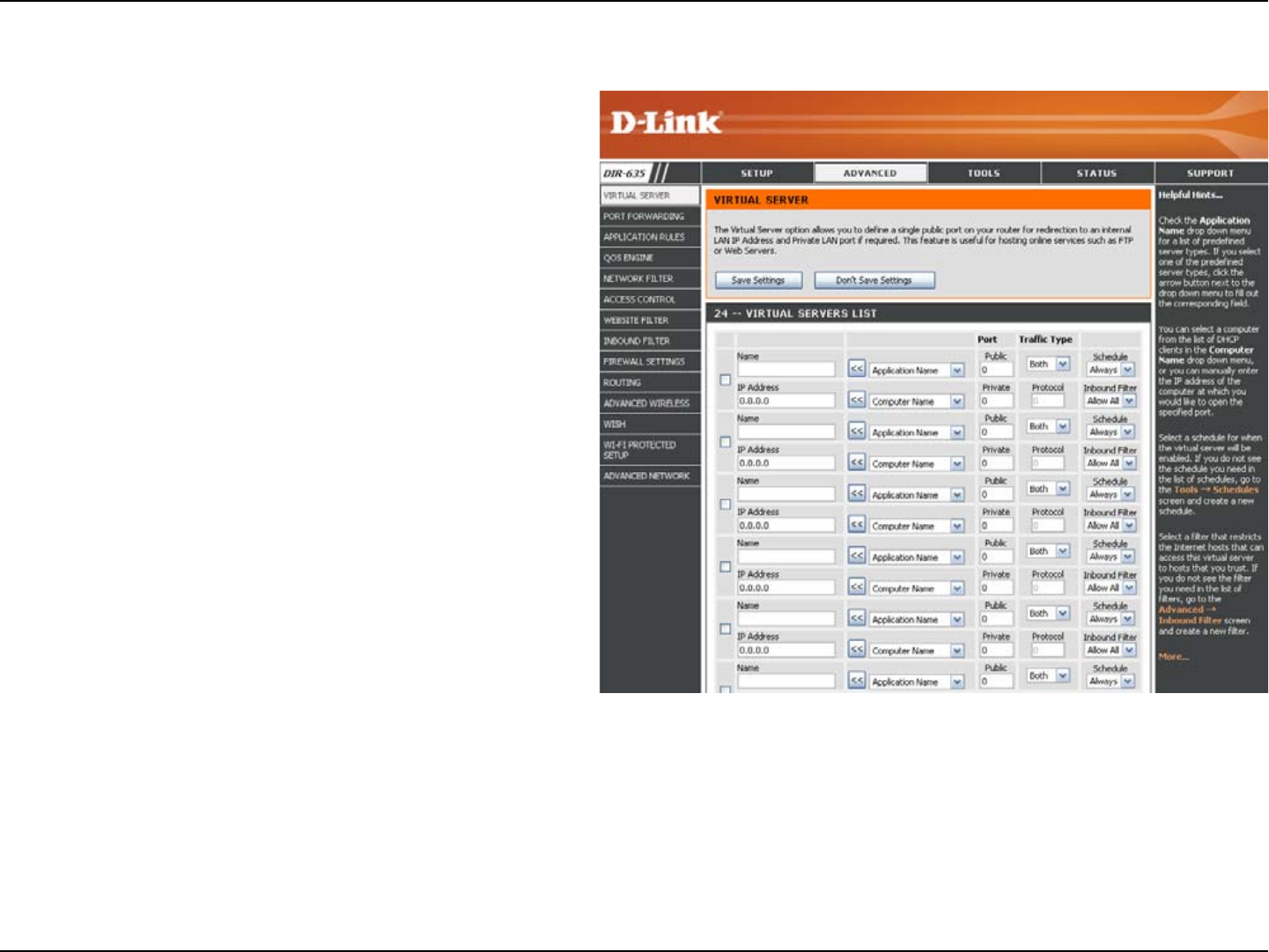
31D-Link DIR-635 User Manual
Section 3 - Configuration
This will allow you to open a single port. If you would like to open a range of ports, refer to page 32.
Enter a name for the rule or select an application
from the drop-down menu. Select an application
and click << to populate the elds.
Enter the IP address of the computer on your
local network that you want to allow the incoming
service to. If your computer is receiving an IP
address automatically from the router (DHCP),
you computer will be listed in the “Computer
Name” drop-down menu. Select your computer
and click <<.
Enter the port that you want to open next to Private
Port and Public Port. The private and public ports
are usually the same. The public port is the port
seen from the Internet side, and the private port
is the port being used by the application on the
computer within your local network.
Select TCP, UDP, or Both from the drop-down
menu.
Select Allow All (most common) or a created
Inbound lter. You may create your own inbound
lters in the Advanced > Inbound Filter page.
The schedule of time when the Virtual Server
Rule will be enabled. The schedule may be set
to Always, which will allow the particular service
to always be enabled. You can create your own
times in the Tools > Schedules section.
Name:
IP Address:
Private Port/
Public Port:
Protocol Type:
Inbound Filter:
Schedule:
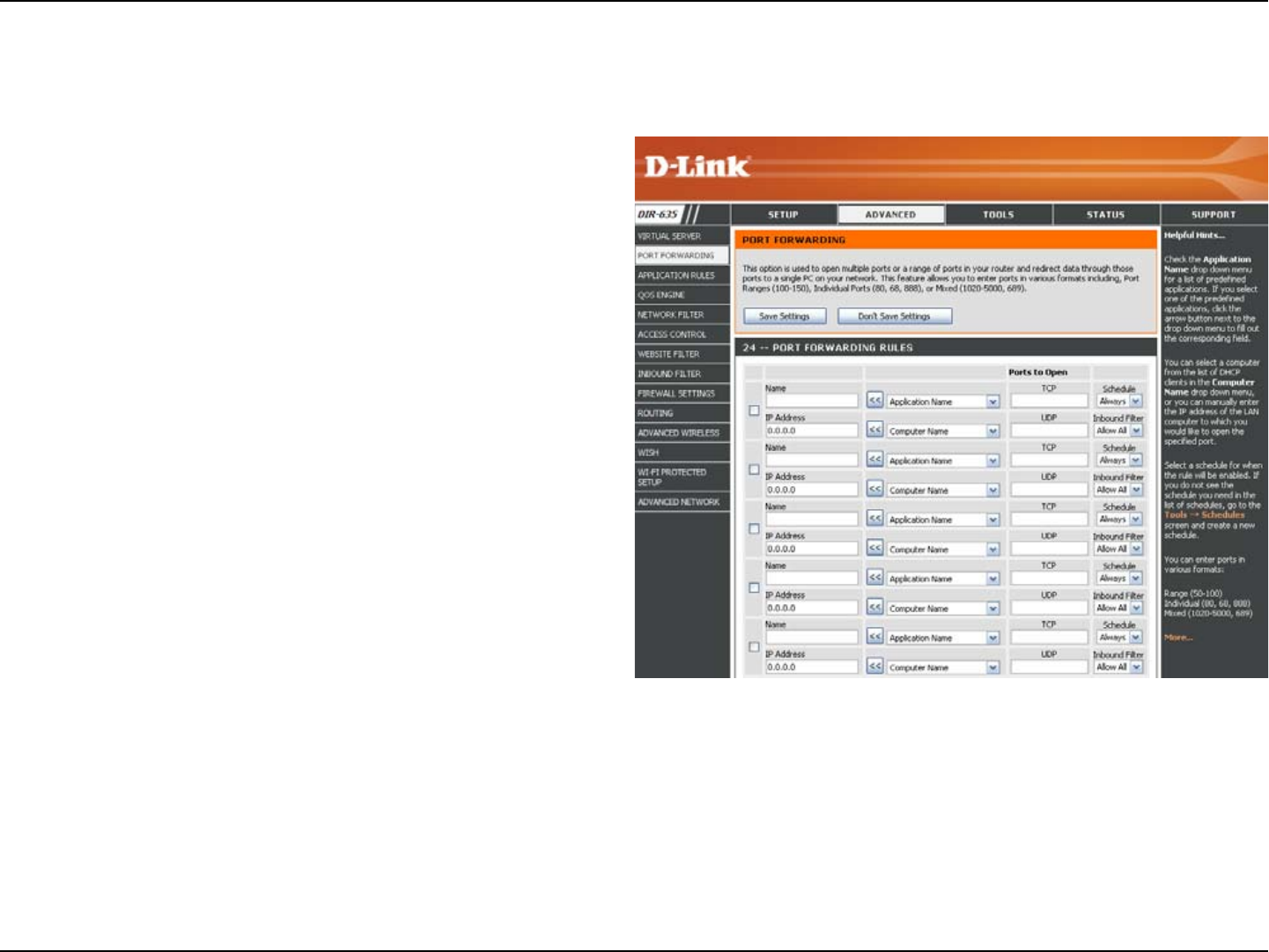
32D-Link DIR-635 User Manual
Section 3 - Configuration
This will allow you to open a single port or a range of ports.
Port Forwarding
Enter a name for the rule or select an application
from the drop-down menu. Select an application
and click << to populate the elds.
Enter the IP address of the computer on your local
network that you want to allow the incoming service
to. If your computer is receiving an IP address
automatically from the router (DHCP), you computer
will be listed in the “Computer Name” drop-down
menu. Select your computer and click <<.
Enter the TCP and/or UDP port or ports that you
want to open. You can enter a single port or a range
of ports. Seperate ports with a common.
Example: 24,1009,3000-4000
Select Allow All (most common) or a created
Inbound lter. You may create your own inbound
lters in the Advanced > Inbound Filter page.
The schedule of time when the Virtual Server Rule
will be enabled. The schedule may be set to Always,
which will allow the particular service to always
be enabled. You can create your own times in the
Tools > Schedules section.
Name:
IP Address:
TCP/UDP:
Inbound Filter:
Schedule:

33D-Link DIR-635 User Manual
Section 3 - Configuration
Enter a name for the rule. You may select a
pre-dened application from the drop-down
menu and click <<.
This is the port used to trigger the application. It
can be either a single port or a range of ports.
Select the protocol of the trigger port (TCP,
UDP, or Both).
This is the port number on the Internet side that
will be used to access the application. You may
dene a single port or a range of ports. You
can use a comma to add multiple ports or port
ranges.
Select the protocol of the rewall port (TCP,
UDP, or Both).
The schedule of time when the Application Rule
will be enabled. The schedule may be set to
Always, which will allow the particular service
to always be enabled. You can create your own
times in the Tools > Schedules section.
Name:
Trigger:
Traffic Type:
Firewall:
Traffic Type:
Schedule:
Application Rules
Some applications require multiple connections, such as Internet gaming, video conferencing, Internet telephony and
others. These applications have difculties working through NAT (Network Address Translation). Special Applications
makes some of these applications work with the DIR-635. If you need to run applications that require multiple connections,
specify the port normally associated with an application in the “Trigger Port” eld, select the protocol type as TCP or
UDP, then enter the rewall (public) ports associated with the trigger port to open them for inbound trafc.
The DIR-635 provides some predened applications in the table on the bottom of the web page. Select the application
you want to use and enable it.
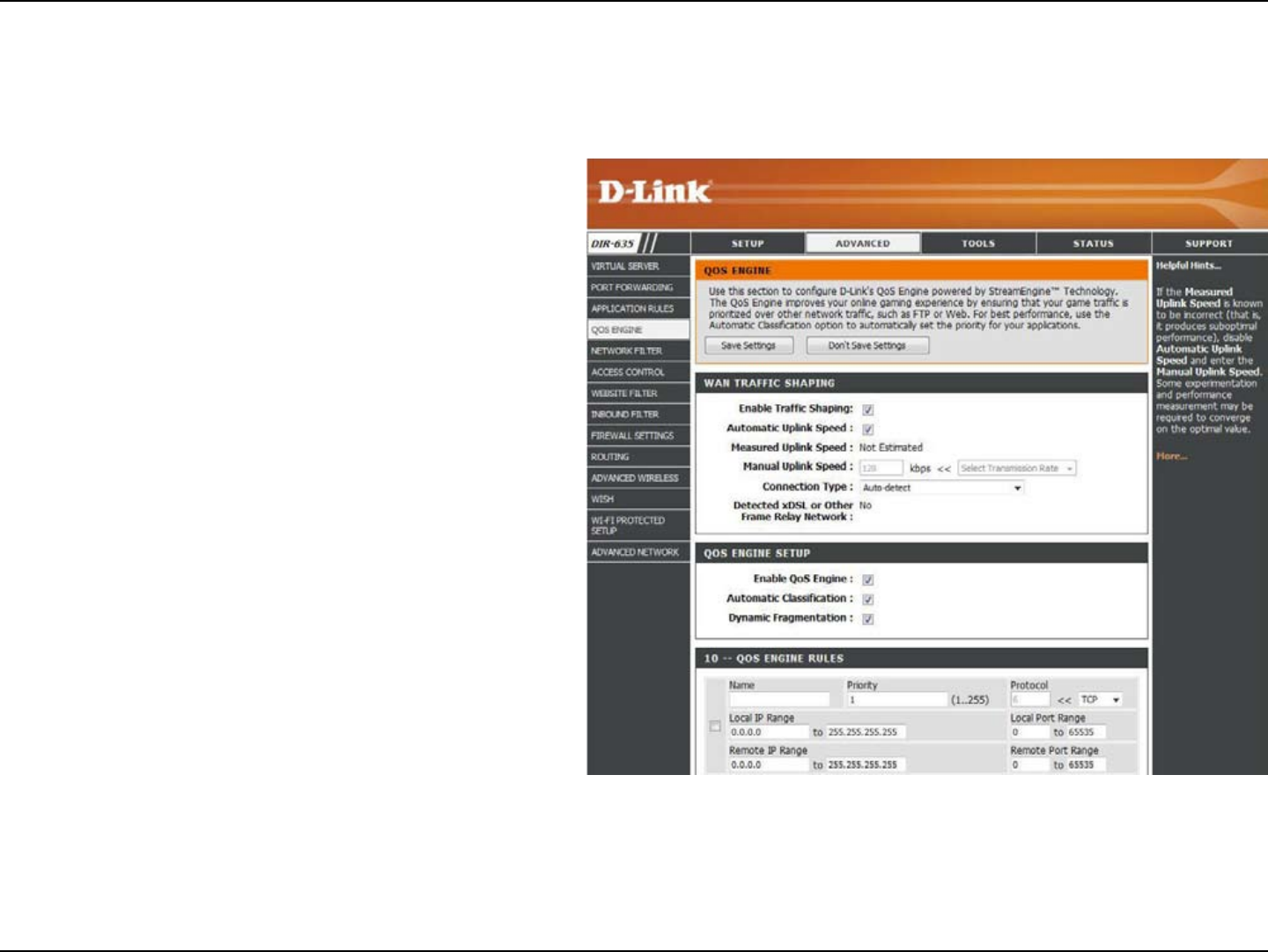
34D-Link DIR-635 User Manual
Section 3 - Configuration
QoS Engine
This option is disabled by default. Enable this
option for better performance and experience with
online games and other interactive applications,
such as VoIP.
This option should be enabled when you have a
slow Internet uplink. It helps to reduce the impact
that large low priority network packets can have
on more urgent ones.
This option is enabled by default when the QoS
Engine option is enabled. This option will allow
your router to automatically determine the uplink
speed of your Internet connection.
This displays the detected uplink speed.
The speed at which data can be transferred from
the router to your ISP. This is determined by your
ISP. ISP’s often speed as a download/upload
pair. For example, 1.5Mbits/284Kbits. Using this
example, you would enter 284. Alternatively you
can test your uplink speed with a service such
as www.dslreports.com.
By default, the router automatically determines whether the underlying connection is an xDSL/Frame-relay network or some
other connection type (such as cable modem or Ethernet), and it displays the result as Detected xDSL or Frame Relay Network.
Enable QOS:
Dynamic
Fragmentation:
Automatic Uplink
Speed:
Measured Uplink
Speed:
Manual Uplink
Speed:
Connection Type:
The QoS Engine option helps improve your network gaming performance by prioritizing applications. By default the
QoS Engine settings are disabled and application priority is not classied automatically.

35D-Link DIR-635 User Manual
Section 3 - Configuration
If you have an unusual network connection in which you are actually connected via xDSL but for which you congure either
“Static” or “DHCP” in the Internet settings, setting this option to xDSL or Other Frame Relay Network ensures that the router
will recognize that it needs to shape trafc slightly differently in order to give the best performance. Choosing xDSL or Other
Frame Relay Network causes the measured uplink speed to be reported slightly lower than before on such connections,
but gives much better results.
When Connection Type is set to automatic, the automatically detected connection type is displayed here.
Detected xDSL:

36D-Link DIR-635 User Manual
Section 3 - Configuration
Network Filters
Select Turn MAC Filtering Off, allow MAC
addresses listed below, or deny MAC addresses
listed below from the drop-down menu.
Enter the MAC address you would like to
lter.
To nd the MAC address on a computer, please
refer to the Networking Basics section in this
manual.
Select a DHCP client from the drop-down menu
and click << to copy that MAC Address.
Configure MAC
Filtering:
MAC Address:
DHCP Client:
Use MAC (Media Access Control) Filters to allow or deny LAN (Local Area Network) computers by their MAC addresses
from accessing the Network. You can either manually add a MAC address or select the MAC address from the list of
clients that are currently connected to the Broadband Router.
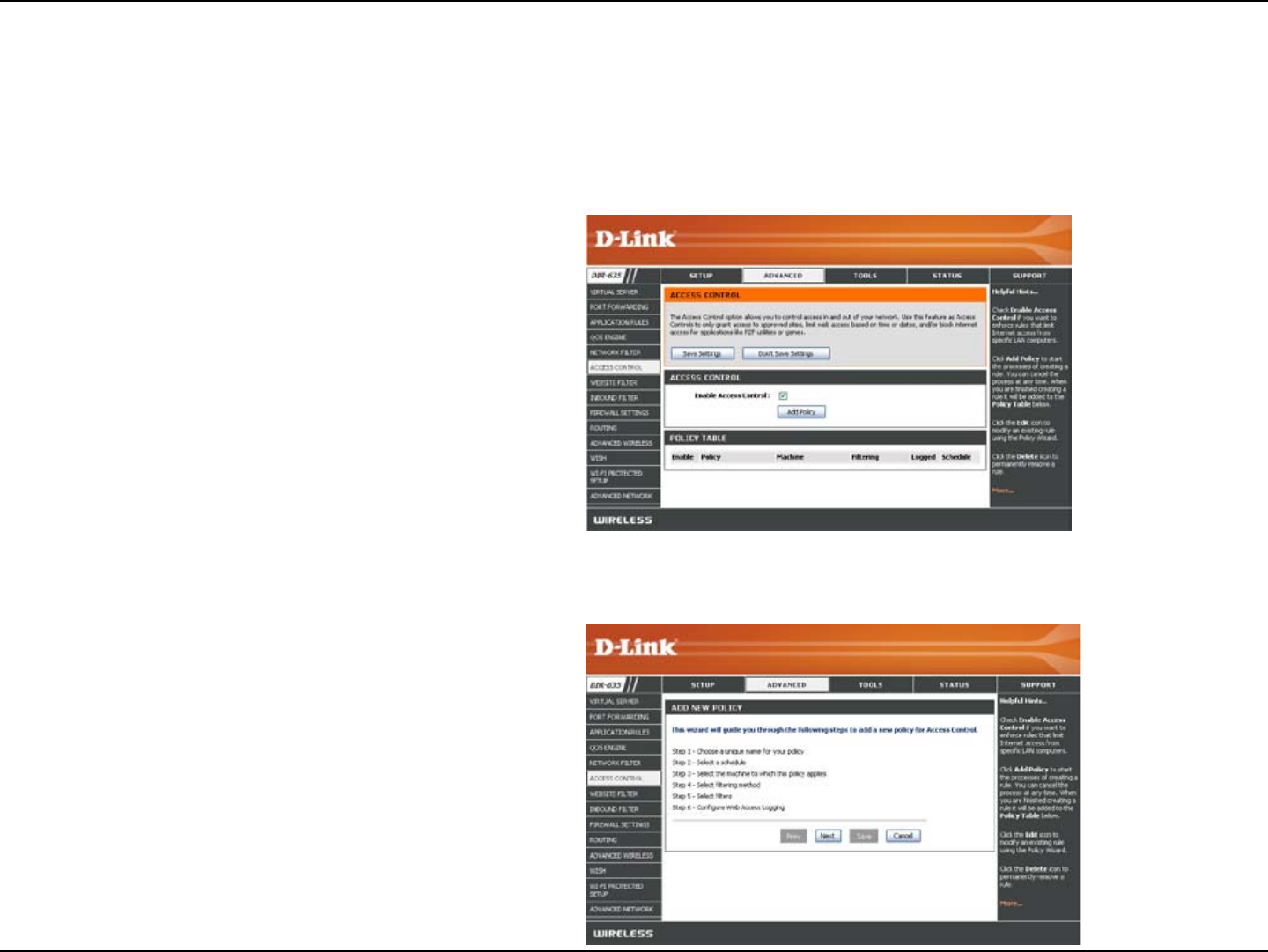
37D-Link DIR-635 User Manual
Section 3 - Configuration
Access Control
Click the Add Policy button to start the Access
Control Wizard.
Add Policy:
The Access Control section allows you to control access in and out of your network. Use this feature as Parental
Controls to only grant access to approved sites, limit web access based on time or dates, and/or block access from
applications like P2P utilities or games.
Click Next to continue with the wizard.
Access Control Wizard

38D-Link DIR-635 User Manual
Section 3 - Configuration
Enter a name for the policy and then click Next to continue.
Access Control Wizard (continued)
Select a schedule (I.E. Always) from the drop-down menu
and then click Next to continue.
Enter the following information and then click Next to
continue.
• Address Type - Select IP address, MAC address, or
Other Machines.
• IP Address - Enter the IP address of the computer
you want to apply the rule to.

39D-Link DIR-635 User Manual
Section 3 - Configuration
Select the ltering method and then click Next to continue.
Access Control Wizard (continued)
Enter the rule:
Enable - Check to enable the rule.
Name - Enter a name for your rule.
Dest IP Start - Enter the starting IP address.
Dest IP End - Enter the ending IP address.
Protocol - Select the protocol.
Dest Port Start - Enter the starting port number.
Dest Port End - Enter the ending port number.
To enable web logging, click Enable.
Click Save to save the access control rule.
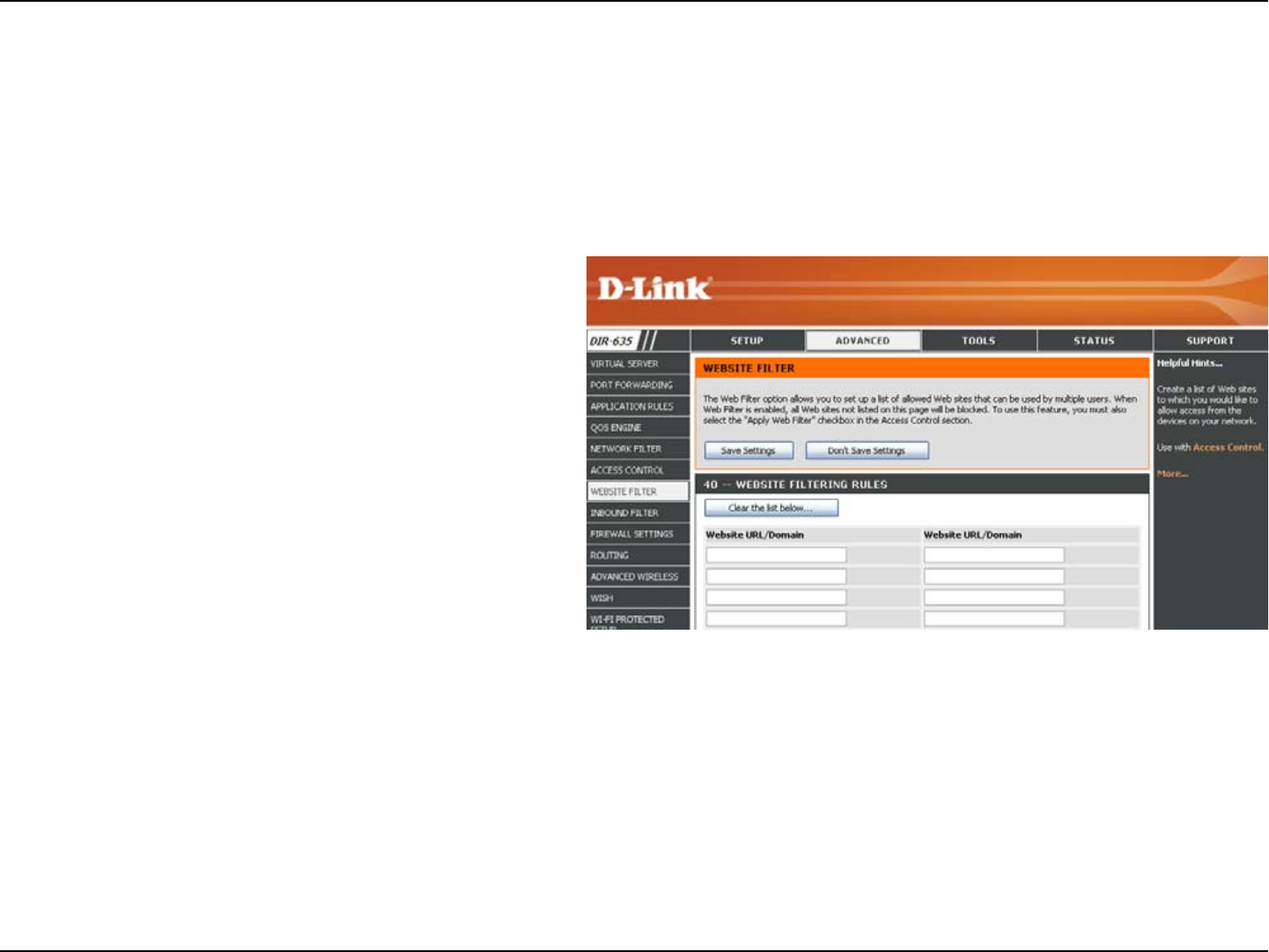
40D-Link DIR-635 User Manual
Section 3 - Configuration
Enter the keywords or URLs that you want to
allow. Any unlisted URL with the keyword will
be blocked.
Website URL/
Domain:
Website Filters
Website Filters are used to allow you to set up a list of allowed Web sites that can be used by multiple users through
the network. When Web Filter is enabled, all Web sites not listed on this page will be blocked. To use this feature enter
the text string of allowed websites and click Save Settings. You must also select Apply Web Filter under the Access
Control section. To delete the text, click Clear the list Below.

41D-Link DIR-635 User Manual
Section 3 - Configuration
Enter a name for the inbound lter rule.
Select Allow or Deny.
Check to enable rule.
Enter the starting IP address. Enter 0.0.0.0 if
you do not want to specify an IP range.
Enter the ending IP address. Enter
255.255.255.255 if you do not want to specify
and IP range.
Click the Save button to apply your settings.
You must click Save Settings at the top to
save the settings.
This section will list any rules that are created.
You may click the Edit icon to change the
settings or enable/disable the rule, or click the
Delete icon to remove the rule.
Name:
Action:
Enable:
Source IP Start:
Source IP End:
Save:
Inbound Filter
Rules List:
The Inbound Filter option is an advanced method of controlling data received from the Internet. With this feature you
can congure inbound data ltering rules that control data based on an IP address range. Inbound Filters can be used
with Virtual Server, Port Forwarding, or Remote Administration features.
Inbound Filters

42D-Link DIR-635 User Manual
Section 3 - Configuration
SPI (Stateful Packet Inspection, also known as dynamic packet
ltering) helps to prevent cyber attacks by tracking more state per
session. It validates that the trafc passing through the session
conforms to the protocol.
Select one of the following for TCP and UDP ports:
Endpoint Independent - Any incoming trafc sent to an open port
will be forwarded to the application that opened the port. The port
will close if idle for 5 minutes.
Address Restricted - Incoming trafc must match the IP address
of the outgoing connection.
Address and Port Restriction - Incoming trafc must match the
IP address and port of the outgoing connection.
Enable this feature to protect your network from certain kinds of
“spoong” attacks.
If an application has trouble working from behind the router, you
can expose one computer to the Internet and run the application on
that computer. Note: Placing a computer in the DMZ may expose
that computer to a variety of security risks. Use of this option is only
recommended as a last resort.
Specify the IP address of the computer on the LAN that you want to
have unrestricted Internet communication. If this computer obtains
it’s IP address automatically using DHCP, be sure to make a static
reservation on the Basic > DHCP page so that the IP address of
the DMZ machine does not change.
Enable this feature to allow the router’ NAT to track application that uses protocols other than UDP, TCP or ICMP.
Enable SPI:
NAT Endpoint
Filtering:
Anti-Spoof
Checking:
Enable DMZ Host:
IP Address:
Non-UDP/TCP/ICMP
LAN Sessions:
Firewall Settings
A rewall protects your network from the outside world. The D-Link DIR-635 offers a rewall type functionality.

43D-Link DIR-635 User Manual
Section 3 - Configuration
VPN Passthrough
RTSP
H.323
SIP (VoIP)
MMS
Application Level Gateway (ALG) Configuration
Here you can enable or disable ALG’s. Some protocols and applications require special handling of the IP payload to
make them work with network address translation (NAT). Each ALG provides special handling for a specic protocol
or application. A number of ALGs for common applications are enabled by default.
Allows multiple machines on the LAN to connect to their corporate network using PPTP protocol.
Allows multiple VPN clients to connect to their corporate network using IPSec. Some VPN clients support traversal of IPSec
through NAT. This ALG may interfere with the operation of such VPN clients. If you are having trouble connecting with your
corporate network, try turning this ALG off. Please check with the system adminstrator of your corporate network whether
your VPN client supports NAT traversal.
Allows applications that use Real Time Streaming Protocol to receive streaming media from the internet. QuickTime and
Real Player are some of the common applications using this protocol.
Allows all of the Windows/MSN Messenger functions to work properly through the router.
Allows FTP clients and servers to transfer data across NAT. Refer to the Advanced > Virtual Server page if you want to
host an FTP server.
Allows Microsoft NetMeeting clients to communicate across NAT. Note that if you want your buddies to call you, you should
also set up a virtual server for NetMeeting. Refer to the Advanced > Virtual Server page for information on how to set up
a virtual server.
Allows devices and applications using VoIP (Voice over IP) to communicate across NAT. Some VoIP applications and
devices have the ability to discover NAT devices and work around them. This ALG may interfere with the operation of such
devices. If you are having trouble making VoIP calls, try turning this ALG off.
Allows Ethernet network adapters with Wake-On-LAN (WOL) to function.
Allows Windows Media Player, using MMS protocol, to receive streaming media from the Internet.
PPTP:
IPSEC (VPN):
RTSP:
MSN Messenger:
FTP:
H.323
(Netmeeting):
SIP:
Wake-On-LAN:
MMS:
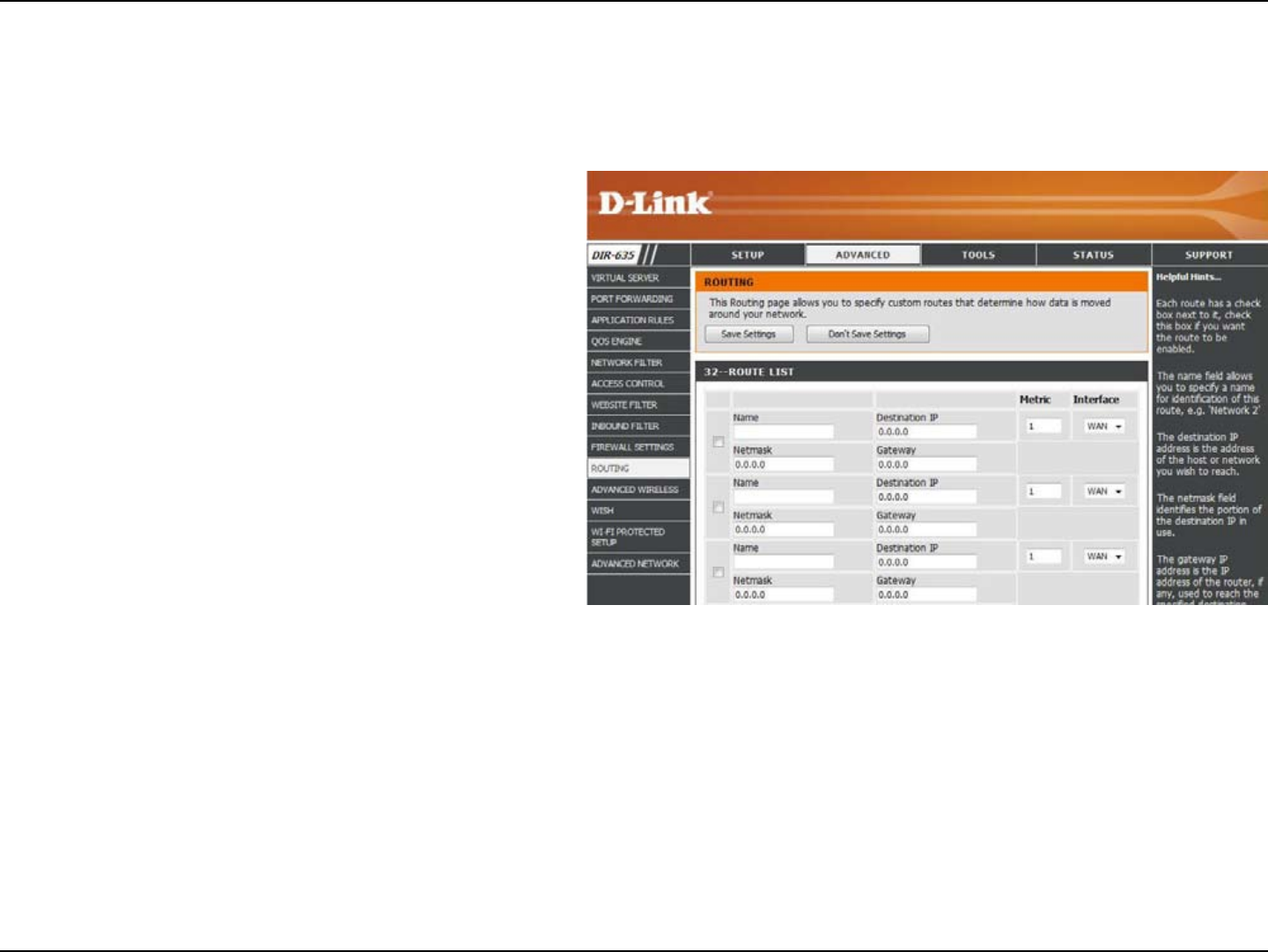
44D-Link DIR-635 User Manual
Section 3 - Configuration
Enter the IP address of packets that will take
this route.
Enter the netmask of the route, please note
that the octets must match your destination
IP address.
Enter your next hop gateway to be taken if this
route is used.
The route metric is a value from 1 to 16 that
indicates the cost of using this route. A value 1
is the lowest cost and 15 is the highest cost.
Select the interface that the IP packet must
use to transit out of the router when this route
is used.
Destination IP:
Netmask:
Gateway:
Metric:
Interface:
Router Settings
The Routing option is an advanced method of customizing specic routes of data through your network.
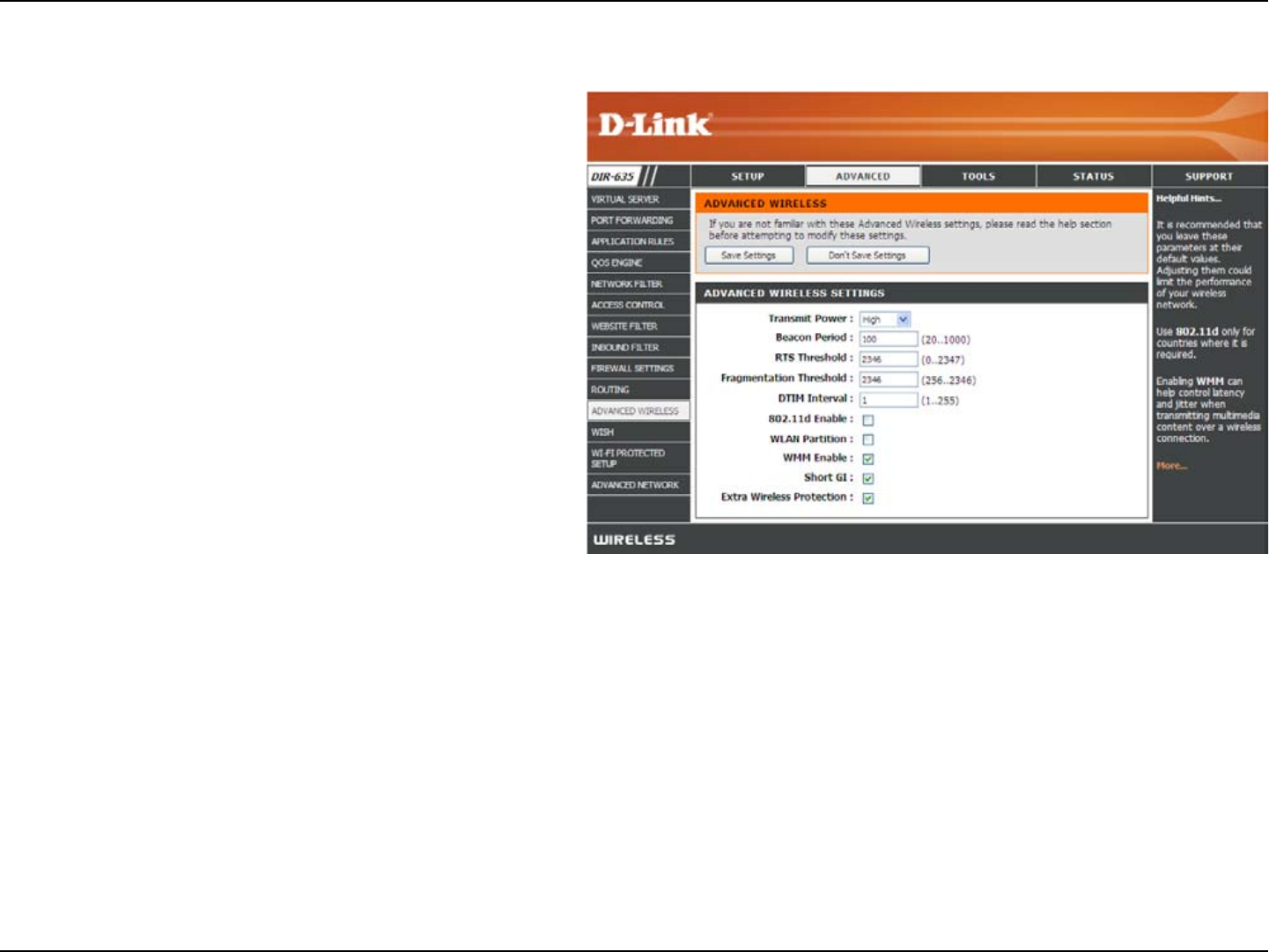
45D-Link DIR-635 User Manual
Section 3 - Configuration
Set the transmit power of the antennas.
Beacons are packets sent by an Access Point to
synchronize a wireless network. Specify a value.
100 is the default setting and is recommended.
This value should remain at its default setting of
2346. If inconsistent data ow is a problem, only
a minor modication should be made.
The fragmentation threshold, which is specied
in bytes, determines whether packets will be
fragmented. Packets exceeding the 2346 byte
setting will be fragmented before transmission.
2346 is the default setting.
(Delivery Trafc Indication Message) 3 is the
default setting. A DTIM is a countdown informing
clients of the next window for listening to
broadcast and multicast messages.
This enables 802.11d opration. 802.11d is a wireless specication developed to allow implementation of wireless networks in
countries that cannot use the 802.11 standard. This feature should only be enabled if you are in a country that requires it.
WLAN Partition prevents associated wireless clients from communicating with each other.
WMM is QoS for your wireless network. This will improve the quality of video and voice applications for your wireless
clients.
Check this box to reduce the guard interval time therefore increasing the data capacity. However, it’s less reliable and may
create higher data loss.
Extra protection for neighboring 11b wireless networks. Turn this option off to reduce the adverse effect of legacy wireless
networks on 802.11ng performance. This option is available only when 802.11 Mode is set to 802.11ng only.
Transmit Power:
Beacon Period:
RTS Threshold:
Fragmentation
Threshold:
DTIM Interval:
802.11d:
WLAN Partition:
WMM Function:
Short GI:
Extra Wireless
Protection:
Advanced Wireless Settings
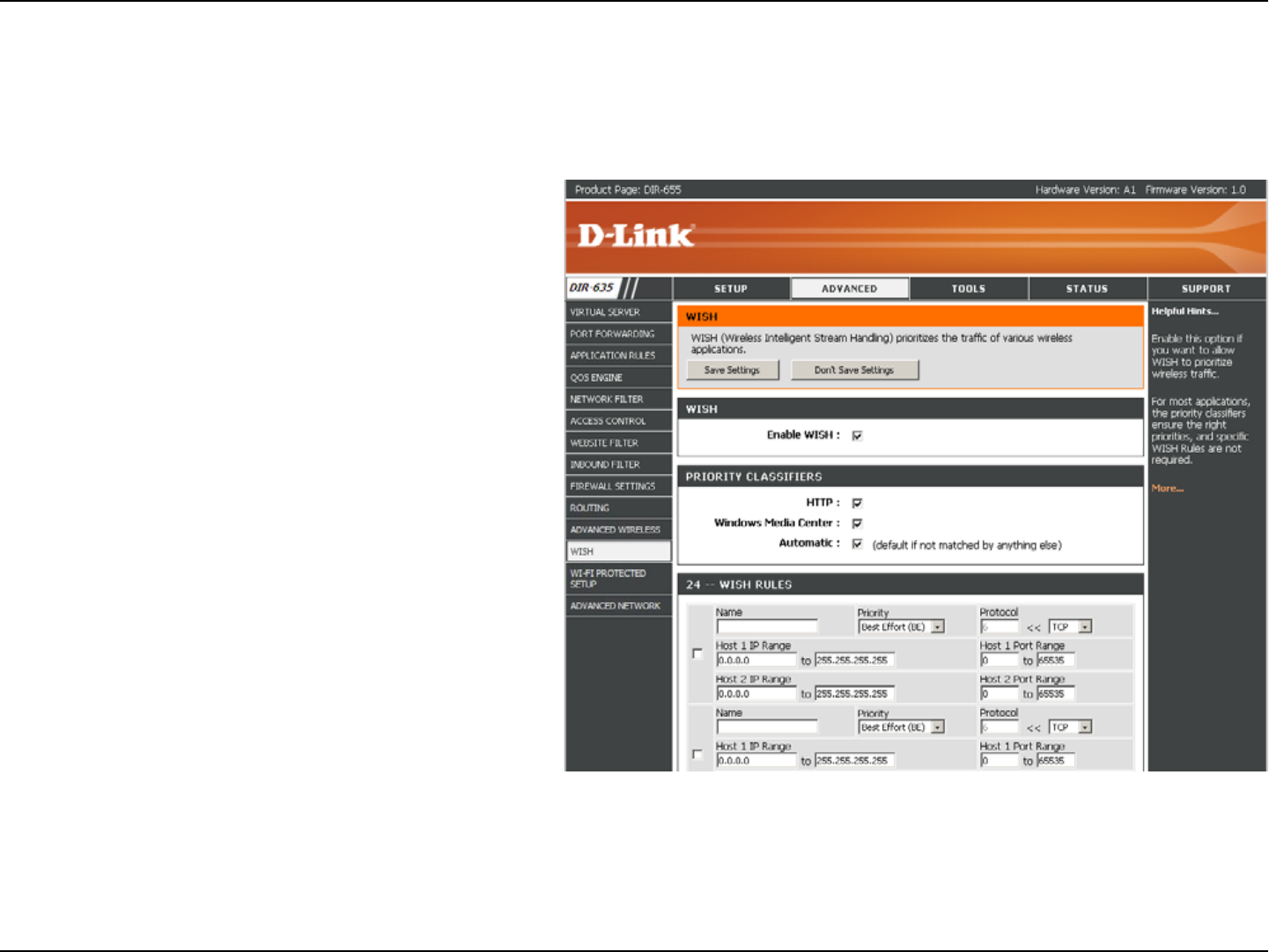
46D-Link DIR-635 User Manual
Section 3 - Configuration
WISH Settings
WISH is short for Wireless Intelligent Stream Handling, a technology developed to enhance your experience of using
a wireless network by prioritizing the trafc of different applications.
Enable this option if you want to allow WISH
to prioritize your trafc.
Enable WISH:
Allows the router to recognize HTTP transfers
for many common audio and video streams
and prioritize them above other trafc. Such
streams are frequently used by digital media
players.
HTTP:
Enables the router to recognize certain
audio and video streams generated by a
Windows Media Center PC and to prioritize
these above other trafc. Such streams are
used by systems known as Windows Media
Extenders, such as the Xbox 360.
Windows Media
Center:
When enabled, this option causes the router
to automatically attempt to prioritize trafc
streams that it doesn’t otherwise recognize,
based on the behaviour that the streams
exhibit. This acts to deprioritize streams that
exhibit bulk transfer characteristics, such as
le transfers, while leaving interactive trafc,
such as gaming or VoIP, running at a normal
priority.
Automatic:
WISH Rules: A WISH Rule identies a specic message ow and assigns a priority to that ow. For most applications, the priority
classiers ensure the right priorities and specic WISH Rules are not required.
WISH supports overlaps between rules. If more than one rule matches for a specic message ow, the rule with the highest
priority will be used.

47D-Link DIR-635 User Manual
Section 3 - Configuration
Create a name for the rule that is meaningful
to you.
Name:
The priority of the message ow is entered
here. The four priorities are dened as:
BK: Background (least urgent)
BE: Best Effort.
VI: Video
VO: Voice (most urgent)
Priority:
The protocol used by the messages.
Protocol:
The rule applies to a ow of messages for which one computer’s IP address falls within the range set here.
Host IP Range:
The rule applies to a ow of messages for which host’s port number is within the range set here.
Host Port Range:
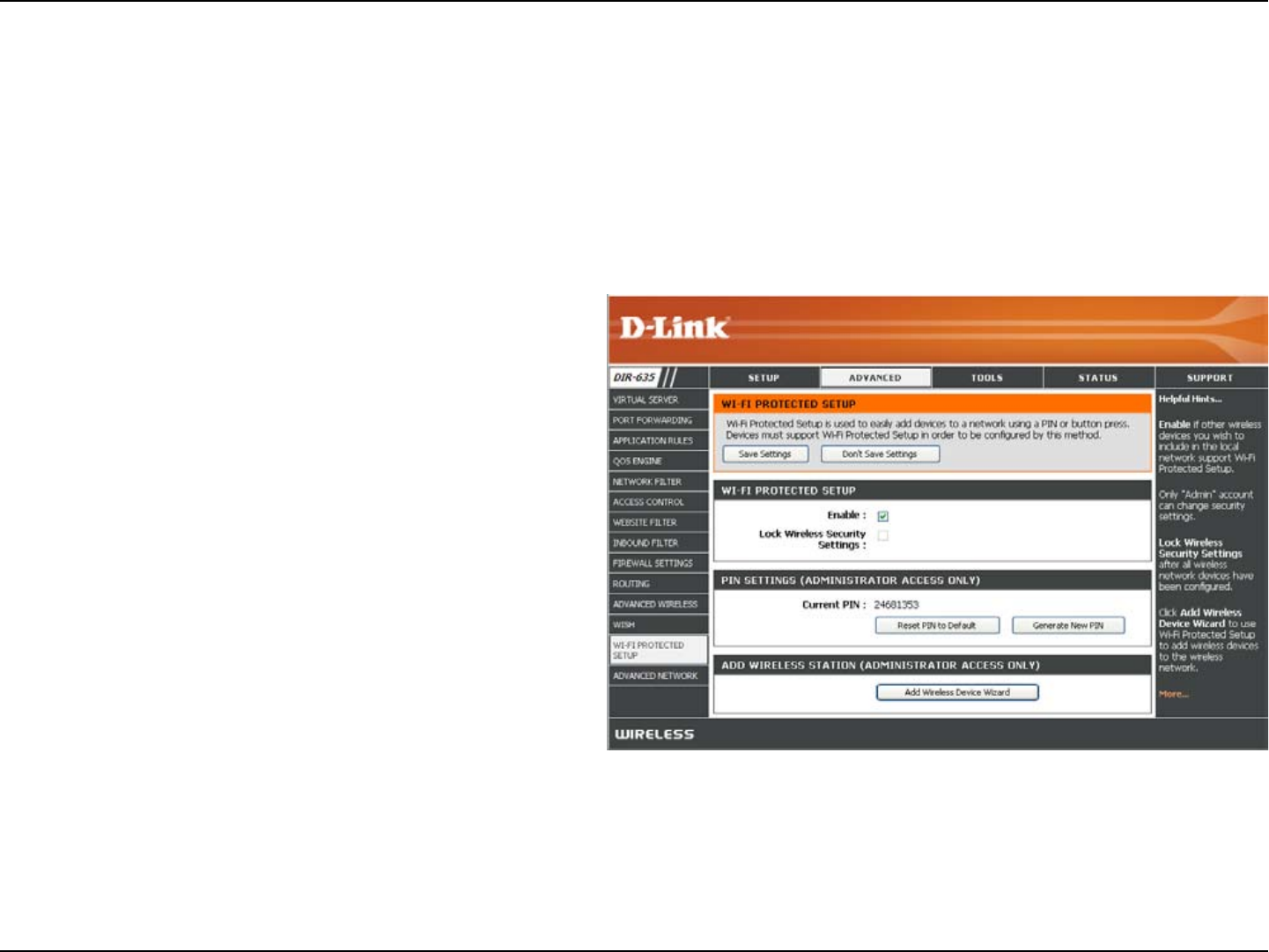
48D-Link DIR-635 User Manual
Section 3 - Configuration
Enable the Wi-Fi Protected Setup feature.
Locking the wireless security settings prevents the
settings from being changed by the Wi-Fi Protected
Setup feature of the router. Devices can still be
added to the network using Wi-Fi Protected Setup.
However, the settings of the network will not change
once this option is checked.
A PIN is a unique number that can be used to add
the router to an existing network or to create a
new network. The default PIN may be printed on
the bottom of the router. For extra security, a new
PIN can be generated. You can restore the default
PIN at any time. Only the Administrator (“admin”
account) can change or reset the PIN.
Shows the current value of the router’s PIN.
Restore the default PIN of the router.
Create a random number that is a valid PIN. This becomes the router’s PIN. You can then copy this PIN to the user interface
of the registrar.
Enable:
Lock Wireless
Security Settings:
PIN Settings:
Current PIN:
Reset PIN to
Default:
Generate New PIN:
Wi-Fi Protected Setup
Wi-Fi Protected Setup (WPS) System is a simplied method for securing your wireless network during the “Initial setup”
as well as the “Add New Device” processes. The Wi-Fi Alliance (WFA) has certied it across different products as well
as manufactures. The process is just as easy, as depressing a button for the Push-Button Method or correctly entering
the 8-digit code for the Pin-Code Method. The time reduction in setup and ease of use are quite benecial, while the
highest wireless Security setting of WPA2 is automatically used.

49D-Link DIR-635 User Manual
Section 3 - Configuration
This Wizard helps you add wireless devices to the wireless network.
The wizard will either display the wireless network settings to guide you through manual conguration, prompt you to enter the
PIN for the device, or ask you to press the conguration button on the device. If the device supports Wi-Fi Protected Setup
and has a conguration button, you can add it to the network by pressing the conguration button on the device and then
the on the router within 60 seconds. The status LED on the router will ash three times if the device has been successfully
added to the network.
There are several ways to add a wireless device to your network. A “registrar” controls access to the wireless network. A
registrar only allows devices onto the wireless network if you have entered the PIN, or pressed a special Wi-Fi Protected
Setup button on the device. The router acts as a registrar for the network, although other devices may act as a registrar as
well.
Start the wizard.
Add Wireless
Station:
Add Wireless
Device Wizard:

50D-Link DIR-635 User Manual
Section 3 - Configuration
UPnP
Internet Ping Block
Internet Port Speed
Multicast Streams
To use the Universal Plug and Play (UPnP™)
feature click on Enabled. UPNP provides
compatibility with networking equipment, software
and peripherals.
Unchecking the box will not allow the DIR-635 to
respond to pings. Blocking the Ping may provide
some extra security from hackers. Check the box
to allow the Internet port to be “pinged”.
You may set the port speed of the Internet port
to 10Mbps, 100Mbps, or auto. Some older cable
or DSL modems may require you to set the port
speed to 10Mbps.
Check the box to allow multicast trafc to pass
through the router from the Internet.
UPnP Settings:
Internet Ping:
Internet Port
Speed:
Multicast
streams:
Advanced Network Settings
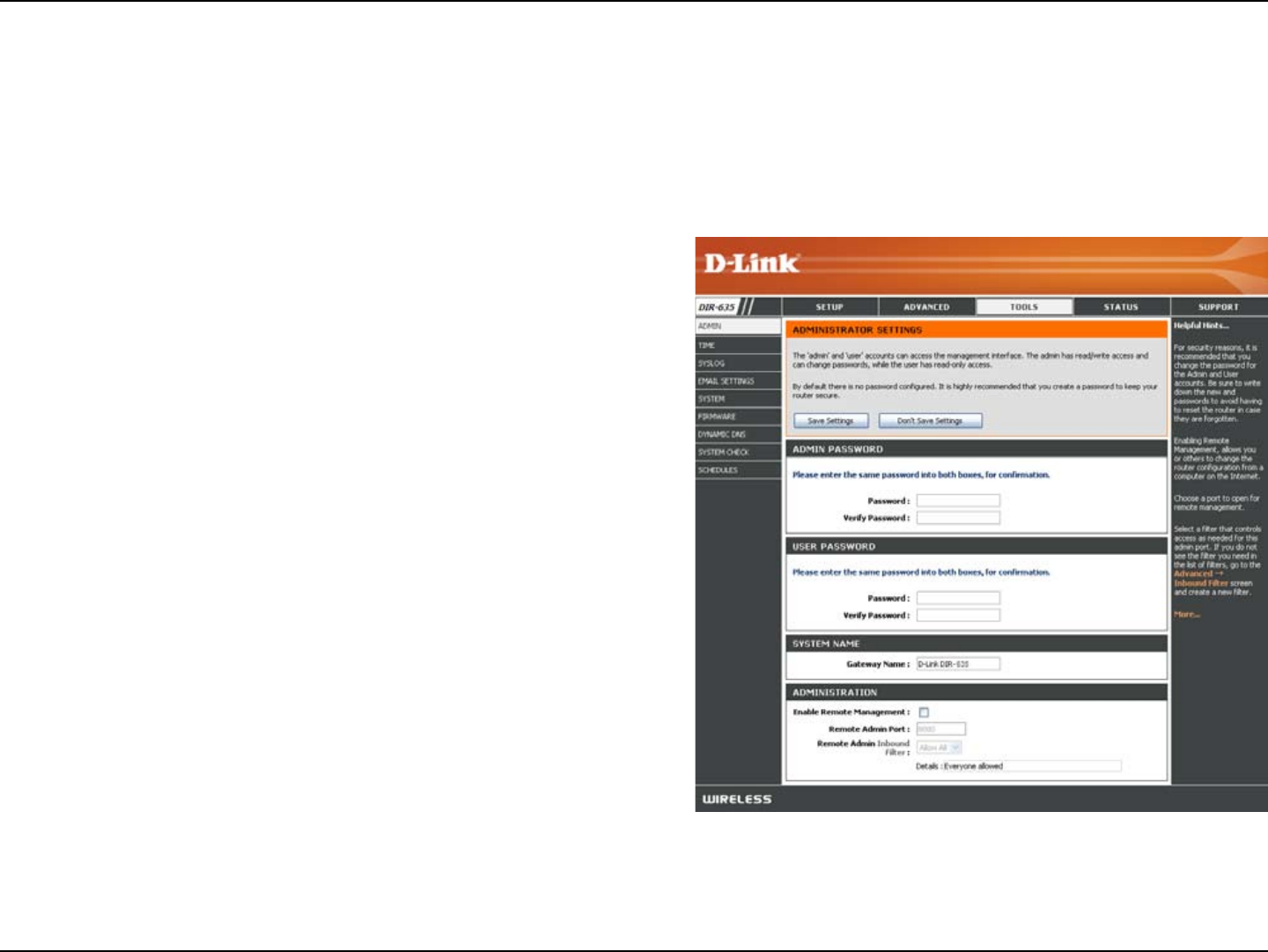
51D-Link DIR-635 User Manual
Section 3 - Configuration
Change Password
Remote Management
Enter a new password for the Administrator Login Name.
The administrator can make changes to the settings.
Enter the new password for the User login. If you login as
the User, you can only see the settings, but cannot change
them.
Enter a name for the DIR-635 router.
Remote management allows the DIR-635 to be congured
from the Internet by a web browser. A username and
password is still required to access the Web-Management
interface. In general, only a member of your network can
browse the built-in web pages to perform Administrator tasks.
This feature enables you to perform Administrator tasks from
the remote (Internet) host.
The port number used to access the DIR-635.
Example: http://x.x.x.x:8080 whereas x.x.x.x is the Internet
IP address of the DIR-635 and 8080 is the port used for the
Web Management interface.
This section will list any rules that are created. You may click
the Edit icon to change the settings or enable/disable the
rule, or click the Delete icon to remove the rule.
Admin Password:
User Password:
Gateway Name:
Remote
Management:
Remote Admin
Port:
Inbound Filter:
Administrator Settings
This page will allow you to change the Administrator and User passwords. You can also enable Remote Management.
There are two accounts that can access the management interface through the web browser. The accounts are admin
and user. Admin has read/write access while user has read-only access. User can only view the settings but cannot
make any changes. Only the admin account has the ability to change both admin and user account passwords.
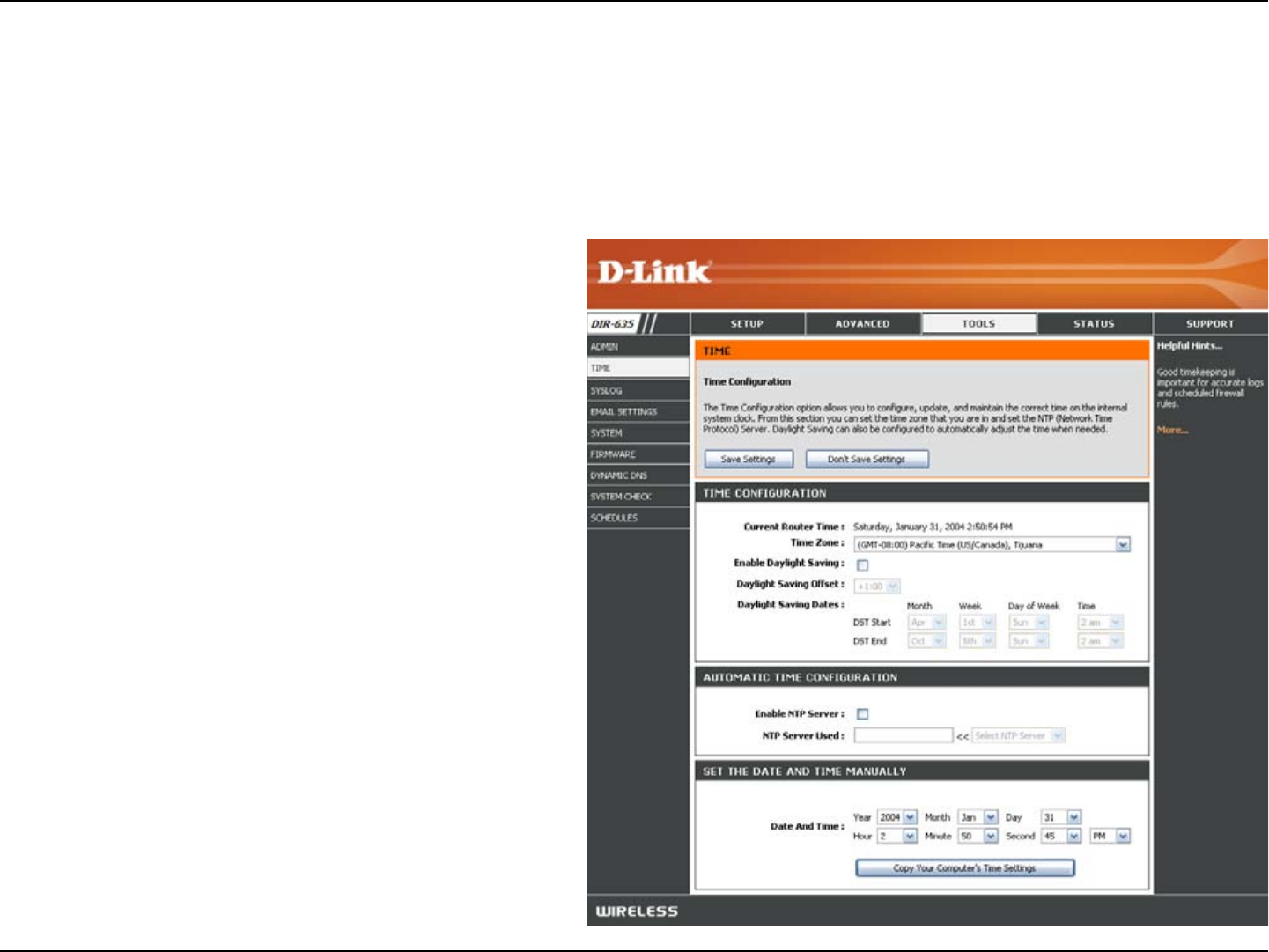
52D-Link DIR-635 User Manual
Section 3 - Configuration
Time Settings
Select the Time Zone from the drop-down
menu.
To select Daylight Saving time manually, select
enabled or disabled, and enter a start date and
an end date for daylight saving time.
NTP is short for Network Time Protocol. NTP
synchronizes computer clock times in a network
of computers. Check this box to use a NTP
server. This will only connect to a server on the
Internet, not a local server.
Enter the NTP server or select one from the
drop-down menu.
To manually input the time, enter the values
in these elds for the Year, Month, Day, Hour,
Minute, and Second and then click Set Time.
You can also click Copy Your Computer’s
Time Settings.
Time Zone:
Daylight Saving:
Enable NTP
Server:
NTP Server Used:
Manual:
The Time Conguration option allows you to congure, update, and maintain the correct time on the internal system
clock. From this section you can set the time zone that you are in and set the Time Server. Daylight Saving can also
be congured to automatically adjust the time when needed.
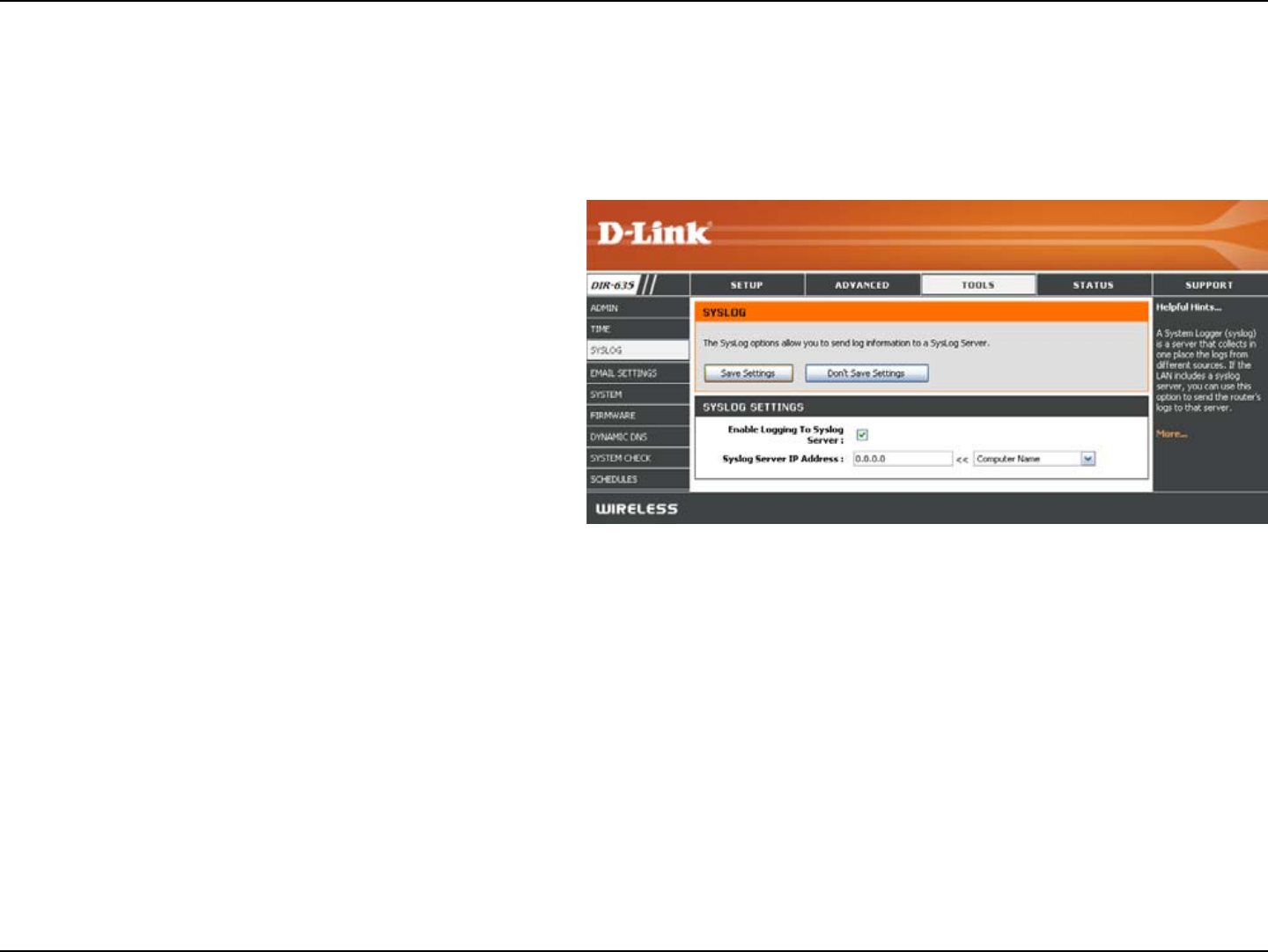
53D-Link DIR-635 User Manual
Section 3 - Configuration
SysLog
The Broadband Router keeps a running log of events and activities occurring on the Router. You may send these logs
to a SysLog server on your network.
Enable Logging to
SysLog Server:
SysLog Server IP
Address:
Check this box to send the router logs to a
SysLog Server.
The address of the SysLog server that will be
used to send the logs. You may also select
your computer from the drop-down menu (only
if receiving an IP address from the router via
DHCP).

54D-Link DIR-635 User Manual
Section 3 - Configuration
Email Settings
The Email feature can be used to send the system log les, router alert messages, and rmware update notication
to your email address.
Enable Email
Notification:
From Email
Address:
To Email Address:
SMTP Server
Address:
Enable
Authentication:
Account Name:
Password:
On Log Full:
On Schedule:
Schedule:
When this option is enabled, router activity logs
are e-mailed to a designated email address.
This email address will appear as the sender
when you receive a log le or rmware upgrade
notication via email.
Enter the email address where you want the
email sent.
Enter the SMTP server address for sending email.
If your SMTP server requires authentication,
select this option.
Check this box if your SMTP server requires
authentication.
Enter your account for sending email.
Enter the password associated with the account.
Re-type the password associated with the
account.
When this option is selected, logs will be sent
via email when the log is full.
Selecting this option will send the logs via email
according to schedule.
This option is enabled when On Schedule is selected. You can select a schedule from the list of dened schedules. To create
a schedule, go to Tools > Schedules.

55D-Link DIR-635 User Manual
Section 3 - Configuration
Use this option to save the current router
conguration settings to a le on the hard disk
of the computer you are using. First, click the
Save button. You will then see a le dialog,
where you can select a location and le name
for the settings.
Use this option to load previously saved
router configuration settings. First, use the
Browse control to nd a previously save le
of conguration settings. Then, click the Load
button to transfer those settings to the router.
This option will restore all conguration settings
back to the settings that were in effect at the
time the router was shipped from the factory.
Any settings that have not been saved will be
lost, including any rules that you have created. If
you want to save the current router conguration
settings, use the Save button above.
Click to reboot the router.
Save Settings to
Local Hard Drive:
Load Settings
from Local Hard
Drive:
Restore to Factory
Default Settings:
Reboot Device:
System Settings
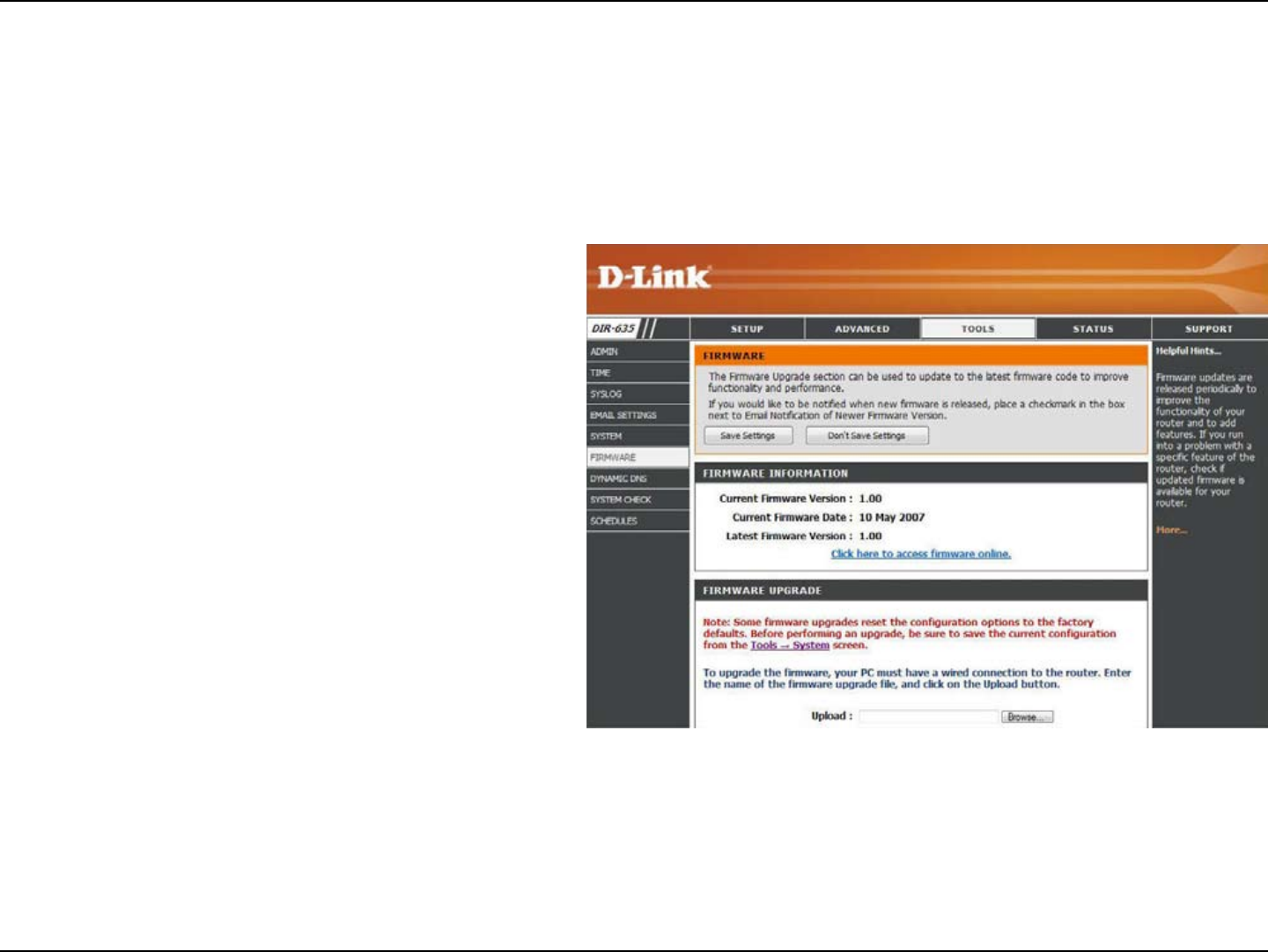
56D-Link DIR-635 User Manual
Section 3 - Configuration
Click on Check Online Now for Latest Firmware
Version to nd out if there is an updated rmware;
if so, download the new rmware to your hard
drive.
After you have downloaded the new rmware,
click Browse to locate the rmware update on
your hard drive. Click Upload to complete the
rmware upgrade.
Check Automatically Check Online for Latest
Firmware Version to have the router check
automatically to see if there is a new rmware
upgrade.
Check Email Notication of Newer Firmware
Version to have the router send an email when
there is a new rmware available.
Firmware
Upgrade:
Browse:
Notifications
Options:
Update Firmware
You can upgrade the rmware of the Router here. Make sure the rmware you want to use is on the local hard drive of
the computer. Click on Browse to locate the rmware le to be used for the update. Please check the D-Link support
site for rmware updates at http://support.dlink.com. You can download rmware upgrades to your hard drive from the
D-Link support site.

57D-Link DIR-635 User Manual
Section 3 - Configuration
Dynamic Domain Name System is a method of
keeping a domain name linked to a changing IP
Address. Check the box to enable DDNS.
Choose your DDNS provider from the drop
down menu.
Enter the Host Name that you registered with
your DDNS service provider.
Enter the Username for your DDNS account.
Enter the Password for your DDNS account.
Enter a time (in hours).
DDNS:
Server Address:
Host Name:
Username or Key:
Password or Key:
Timeout:
DDNS
The DDNS feature allows you to host a server (Web, FTP, Game Server, etc…) using a domain name that you have
purchased (www.whateveryournameis.com) with your dynamically assigned IP address. Most broadband Internet
Service Providers assign dynamic (changing) IP addresses. Using a DDNS service provider, your friends can enter in
your domain name to connect to your server no matter what your IP address is.

58D-Link DIR-635 User Manual
Section 3 - Configuration
The Ping Test is used to send Ping packets to test if a
computer is on the Internet. Enter the IP Address that you
wish to Ping, and click Ping.
The results of your ping attempts will be displayed here.
System Check
Ping Test:
Ping Results:

59D-Link DIR-635 User Manual
Section 3 - Configuration
Enter a name for your new schedule.
Select a day, a range of days, or All Week to
include every day.
Check All Day - 24hrs or enter a start and end
time for your schedule.
Click Save to save your schedule. You must click
Save Settings at the top for your schedules to go
into effect.
The list of schedules will be listed here. Click the
Edit icon to make changes or click the Delete
icon to remove the schedule.
Name:
Days:
Time:
Save:
Schedule Rules
List:
Schedules
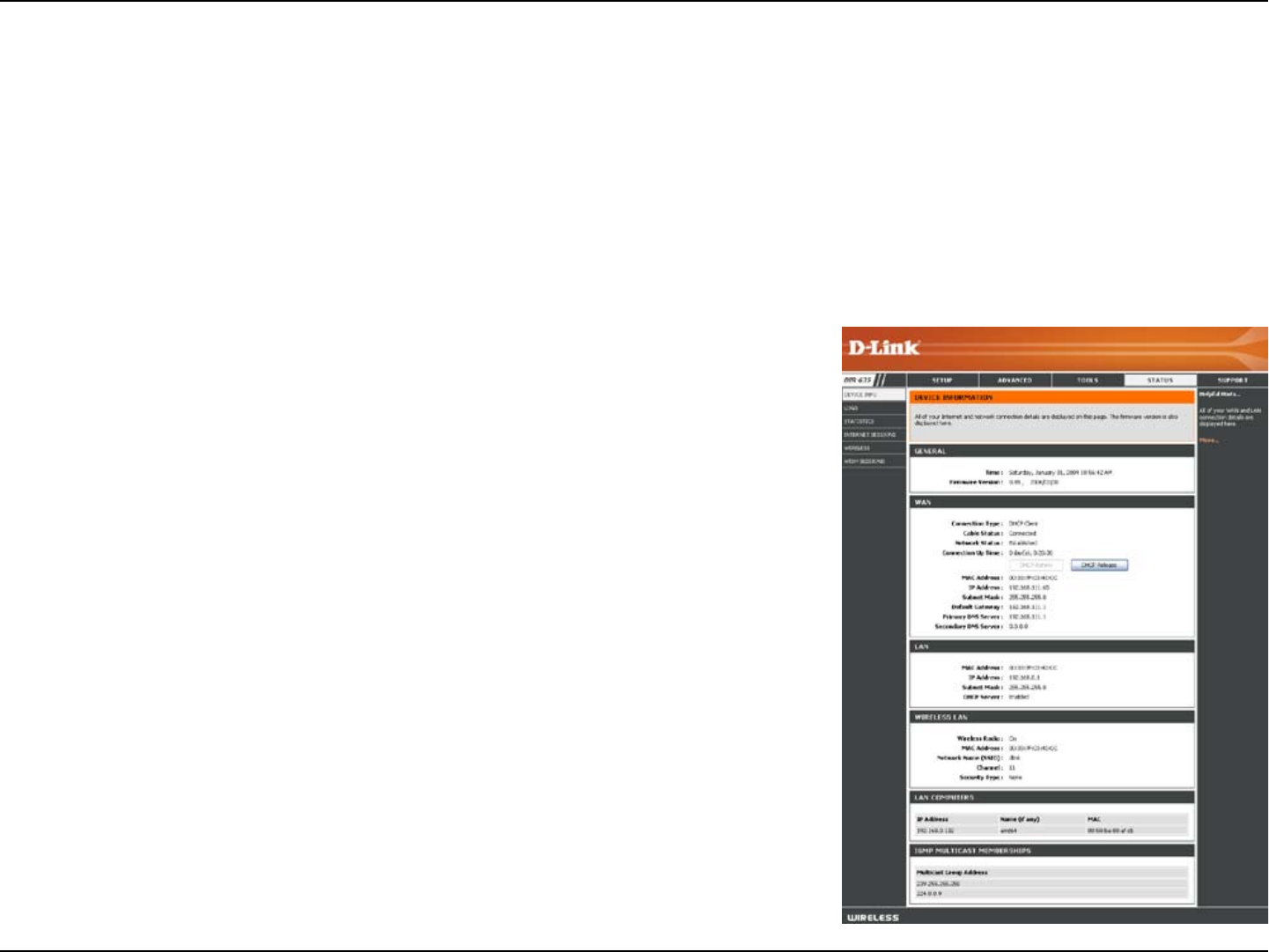
60D-Link DIR-635 User Manual
Section 3 - Configuration
This page displays the current information for the DIR-635. It will display the LAN, WAN (Internet), and Wireless
information.
If your Internet connection is set up for a Dynamic IP address then a Release button and a Renew button will be
displayed. Use Release to disconnect from your ISP and use Renew to connect to your ISP.
If your Internet connection is set up for PPPoE, a Connect button and a Disconnect button will be displayed. Use
Disconnect to drop the PPPoE connection and use Connect to establish the PPPoE connection.
Displays the router’s time and rmware version.
Displays the MAC address and the public IP settings for the router.
Displays the MAC address and the private (local) IP settings for the
router.
Displays the wireless MAC address and your wireless settings such as
SSID and Channel.
Displays computers and devices that are connected to the router via
Ethernet and that are receiving an IP address assigned by the router
(DHCP).
Displays the Multicast Group IP Address.
General:
WAN:
LAN:
Wireless LAN:
LAN Computers:
IGMP Multicast
Memberships:
Device Information

61D-Link DIR-635 User Manual
Section 3 - Configuration
Logs
What to View:
View Levels:
Apply Log
Settings:
Refresh:
Clear:
Email Now:
Save Log:
You can select the types of messages that you want
to display from the log. Firewall & Security, System,
and Router Status messages can be selected.
There are three levels of message importance:
Informational, Warning, and Critical. Select the levels
that you want displayed in the log.
Will lter the log results so that only the selected
options appear.
Updates the log details on the screen so it displays
any recent activity.
Clears all of the log contents.
This option will send a copy of the router log to
the email address congured in the Tools > Email
screen.
This option will save the router to a log le on your
computer.
The router automatically logs (records) events of possible interest in it’s internal memory. If there isn’t enough internal
memory for all events, logs of older events are deleted but logs of the latest events are retained. The Logs option allows
you to view the router logs. You can dene what types of events you want to view and the level of the events to view.
This router also has external Syslog Server support so you can send the log les to a computer on your network that
is running a Syslog utility.

62D-Link DIR-635 User Manual
Section 3 - Configuration
Statistics
The screen below displays the Trafc Statistics. Here you can view the amount of packets that pass through the DIR-635
on both the Internet and the LAN ports. The trafc counter will reset if the device is rebooted.
Internet Sessions

63D-Link DIR-635 User Manual
Section 3 - Configuration
The wireless client table displays a list of current connected wireless clients. This table also displays the connection
time and MAC address of the connected wireless clients.
Wireless
The WISH Sessions page displays full details of wireless clients that are connected when WISH is enabled.
WISH Sessions
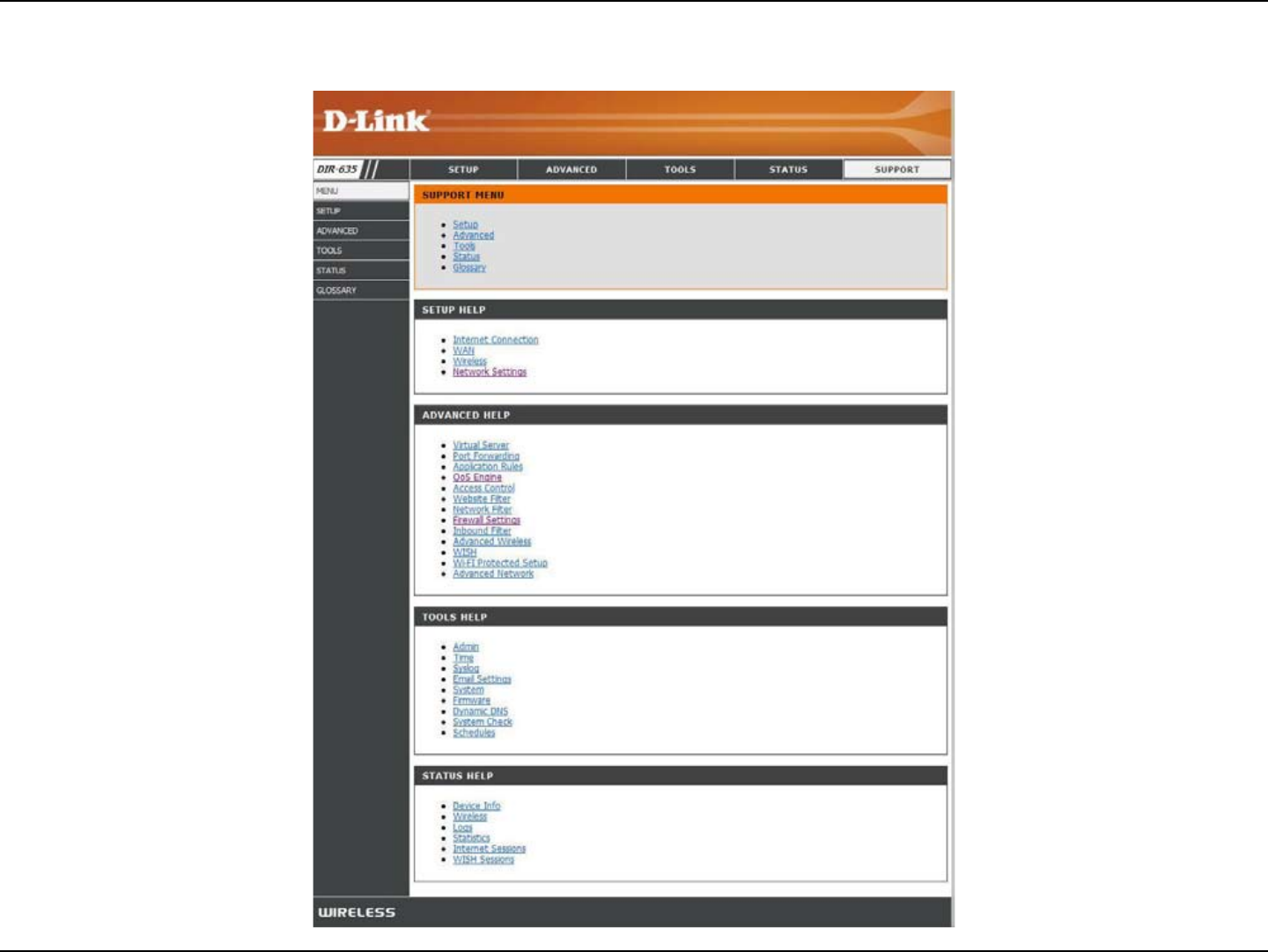
64D-Link DIR-635 User Manual
Section 3 - Configuration
Support

65D-Link DIR-635 User Manual
Section 4 - Security
Wireless Security
This section will show you the different levels of security you can use to protect your data from intruders. The
DIR-635 offers the following types of security:
• WPA2 (Wi-Fi Protected Access 2) • WPA2-PSK (Pre-Shared Key)
• WPA (Wi-Fi Protected Access) • WPA-PSK (Pre-Shared Key)
• WEP (Wired Equivalent Privacy)
What is WEP?
WEP stands for Wired Equivalent Privacy. It is based on the IEEE 802.11 standard and uses the RC4 encryption
algorithm. WEP provides security by encrypting data over your wireless network so that it is protected as it is transmitted
from one wireless device to another.
To gain access to a WEP network, you must know the key. The key is a string of characters that you create. When
using WEP, you must determine the level of encryption. The type of encryption determines the key length. 128-bit
encryption requires a longer key than 64-bit encryption. Keys are dened by entering in a string in HEX (hexadecimal
- using characters 0-9, A-F) or ASCII (American Standard Code for Information Interchange – alphanumeric characters)
format. ASCII format is provided so you can enter a string that is easier to remember. The ASCII string is converted to
HEX for use over the network. Four keys can be dened so that you can change keys easily.

66D-Link DIR-635 User Manual
Section 4 - Security
What is WPA?
WPA, or Wi-Fi Protected Access, is a Wi-Fi standard that was designed to improve the security features of WEP (Wired
Equivalent Privacy).
The 2 major improvements over WEP:
• Improved data encryption through the Temporal Key Integrity Protocol (TKIP). TKIP scrambles the keys
using a hashing algorithm and, by adding an integrity-checking feature, ensures that the keys haven’t
been tampered with. WPA2 is based on 802.11i and uses Advanced Encryption Standard (AES) instead
of TKIP.
• User authentication, which is generally missing in WEP, through the extensible authentication protocol
(EAP). WEP regulates access to a wireless network based on a computer’s hardware-specic MAC
address, which is relatively simple to be sniffed out and stolen. EAP is built on a more secure public-key
encryption system to ensure that only authorized network users can access the network.
WPA-PSK/WPA2-PSK uses a passphrase or key to authenticate your wireless connection. The key is an alpha-numeric
password between 8 and 63 characters long. The password can include symbols (!?*&_) and spaces. This key must
be the exact same key entered on your wireless router or access point.
WPA/WPA2 incorporates user authentication through the Extensible Authentication Protocol (EAP). EAP is built on a
more secure public key encryption system to ensure that only authorized network users can access the network.

67D-Link DIR-635 User Manual
Section 4 - Security
Wireless Security Setup Wizard
To run the security wizard, click on Setup at the top and then
click Launch Wireless Security Setup Wizard.
Select how you would like to congure your wireless security
settings:
Auto - Allows the router to auto-generate Wireless Network
Name (SSID) and WPA-Personal Passphrase. Click Save to
apply the auto-generated settings.
Manual - Allows you to go through the Wireless Security Setup
Wizard and enter your settings manually.
Click Next to continue.
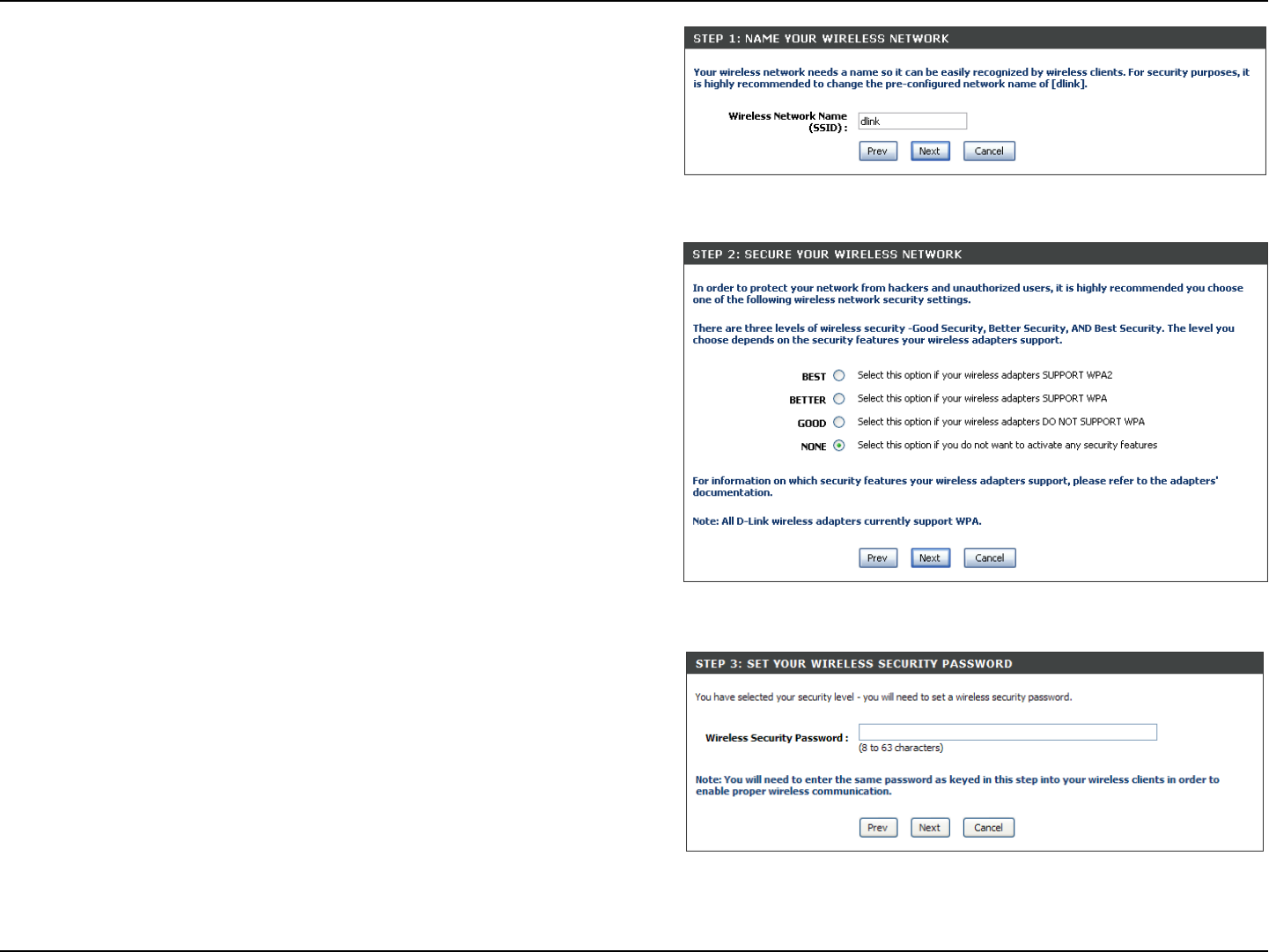
68D-Link DIR-635 User Manual
Section 4 - Security
Enter the SSID (Service Set Identier). The SSID is the
name of your wireless network. Create a name using up to
32 characters. The SSID is case-sensitive.
Select the level of security for your wireless network:
• Best - WPA2 Authentication
• Better - WPA Authentication
• Good - WEP Encryption
• None - No security
Click Next to continue.
If you selected Best or Better, enter a password between
8-63 characters.
If you selected Good, enter 13 characters or 26 Hex digits.
Click Next to continue.

69D-Link DIR-635 User Manual
Section 4 - Security
If you selected Good, the following screen will show you your
WEP key to enter on your wireless clients.
Click Save to nish the Security Wizard.
If you selected Better, the following screen will show you your
Pre-Shared Key to enter on your wireless clients.
Click Save to nish the Security Wizard.
If you selected Best, the following screen will show you your
Pre-Shared Key to enter on your wireless clients.
Click Save to nish the Security Wizard.
If you selected WPA-Enterprise, the RADIUS information will be displayed. Click Save to nish the Security Wizard.
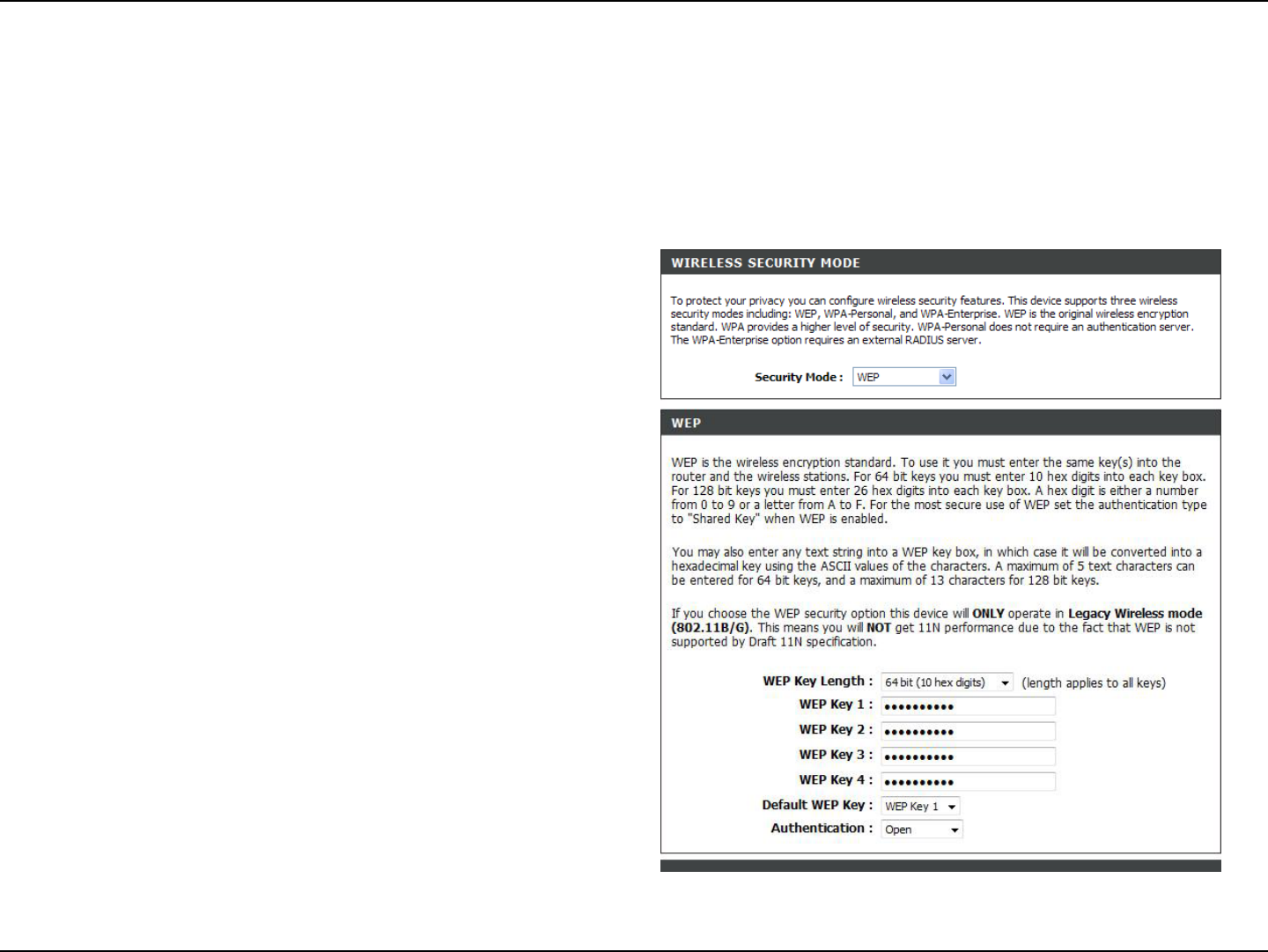
70D-Link DIR-635 User Manual
Section 4 - Security
Configure WEP
It is recommended to enable encryption on your wireless router before your wireless network adapters. Please establish
wireless connectivity before enabling encryption. Your wireless signal may degrade when enabling encryption due to
the added overhead.
1. Log into the web-based configuration by opening a
web browser and entering the IP address of the router
(192.168.0.1). Click on Setup and then click Wireless
Settings on the left side.
2. Next to Security Mode, select WEP.
3. Next to WEP Key Length, select the level of ecryption (64
or 128-bit).
Hex - (recommended) Letters A-F and numbers 0-9
are valid.
4. Next to WEP Key 1, enter a WEP key that you create.
Make sure you enter this key exactly on all your wireless
devices. You may enter up to 4 different keys.
5. Next to Authentication, select Shared Key.
6. Click Save Settings to save your settings. If you are
conguring the router with a wireless adapter, you will lose
connectivity until you enable WEP on your adapter and
enter the same WEP key as you did on the router.
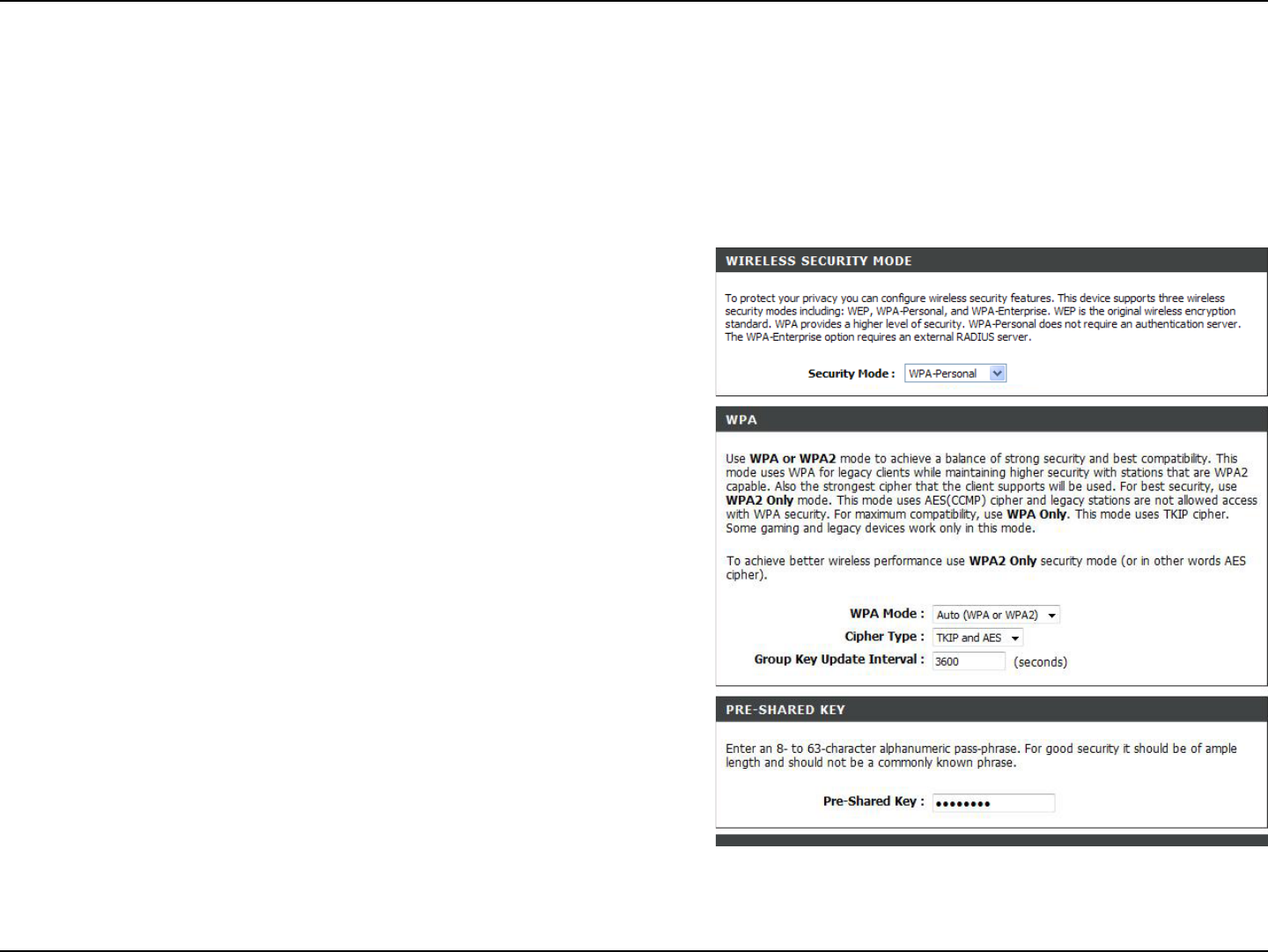
71D-Link DIR-635 User Manual
Section 4 - Security
Configure WPA-Personal (PSK)
It is recommended to enable encryption on your wireless router before your wireless network adapters. Please establish
wireless connectivity before enabling encryption. Your wireless signal may degrade when enabling encryption due to
the added overhead.
1. Log into the web-based conguration by opening a web browser
and entering the IP address of the router (192.168.0.1). Click
on Setup and then click Wireless Settings on the left side.
2. Next to Security Mode, select WPA-Personal.
3. Next to WPA Mode, select Auto, WPA2 Only, or WPA Only. Use
Auto if you have wireless clients using both WPA and WPA2.
4. Next to Cypher Type, select TKIP and AES, TKIP, or AES.
5. Next to Group Key Update Interval, enter the amount of time
before the group key used for broadcast and multicast data is
changed (3600 is default).
6. Next to Pre-Shared Key, enter a key (passphrase). The key is
entered as a pass-phrase in ASCII format at both ends of the
wireless connection. The pass-phrase must be between 8-63
characters.
7. Click Save Settings to save your settings. If you are conguring
the router with a wireless adapter, you will lose connectivity until you enable WPA-PSK on your adapter and enter
the same passphrase as you did on the router.

72D-Link DIR-635 User Manual
Section 4 - Security
It is recommended to enable encryption on your wireless router before your wireless network adapters. Please establish
wireless connectivity before enabling encryption. Your wireless signal may degrade when enabling encryption due to
the added overhead.
1. Log into the web-based conguration by opening a web browser
and entering the IP address of the router (192.168.0.1). Click
on Setup and then click Wireless Settings on the left side.
2. Next to Security Mode, select WPA-Enterprise.
3. Next to WPA Mode, select Auto, WPA2 Only, or WPA Only. Use
Auto if you have wireless clients using both WPA and WPA2.
4. Next to Cypher Type, select TKIP and AES, TKIP, or AES.
5. Next to Group Key Update Interval, enter the amount of time
before the group key used for broadcast and multicast data is
changed (3600 is default).
6. Next to Authentication Timeout, enter the amount of time before
a client is required to re-authenticate (60 minutes is default).
7. Next to RADIUS Server IP Address enter the IP Address of your
RADIUS server.
8. Next to RADIUS Server Port, enter the port you are using with
your RADIUS server. 1812 is the default port.
Configure WPA-Enterprise (RADIUS)
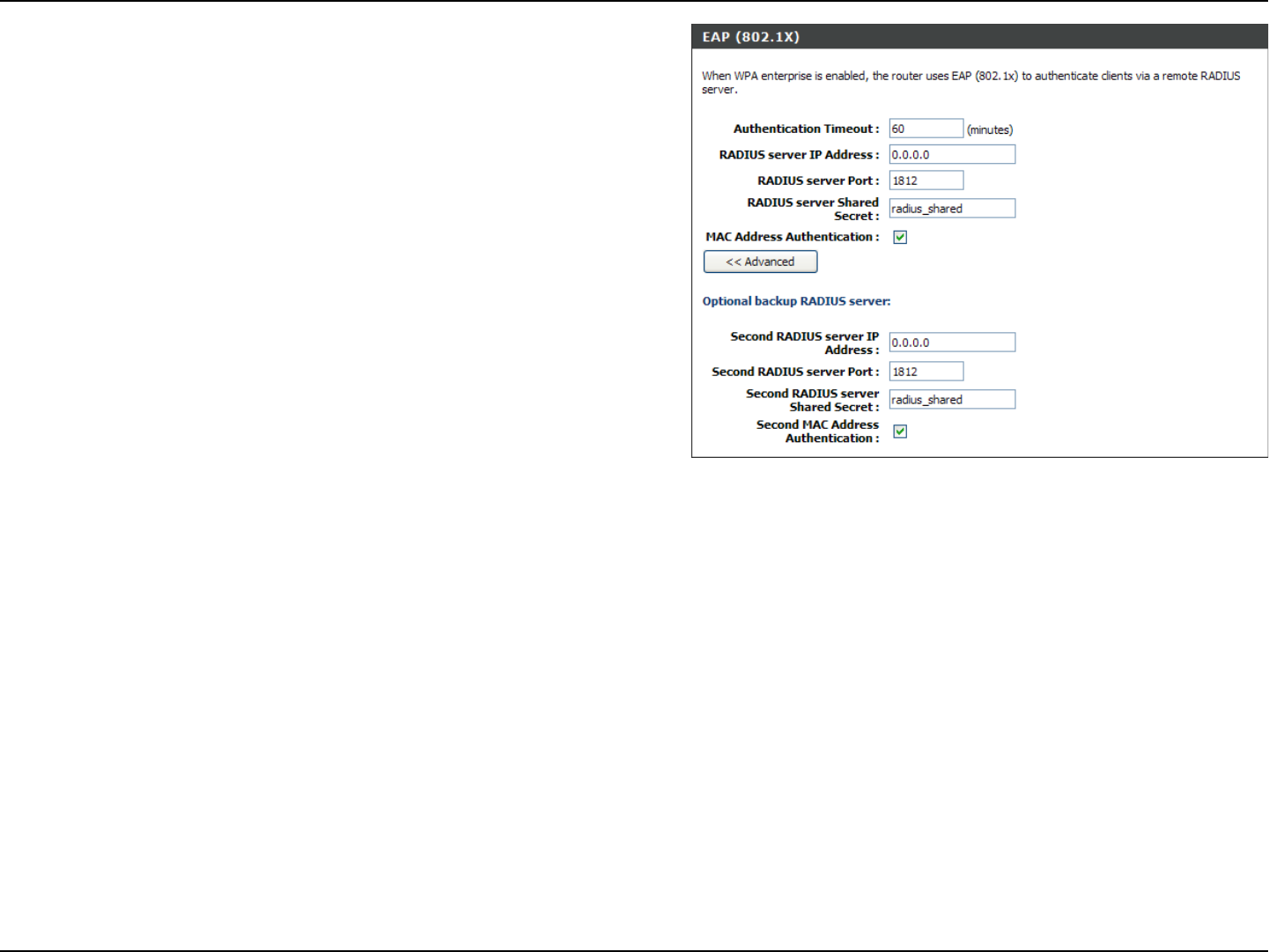
73D-Link DIR-635 User Manual
Section 4 - Security
9. Next to RADIUS Server Shared Secret, enter the security
key.
10. If the MAC Address Authentication box is selected then the
user will need to connect from the same computer whenever
logging into the wireless network.
11. Click Advanced to enter settings for a secondary RADIUS
Server.
12. Click Apply Settings to save your settings.
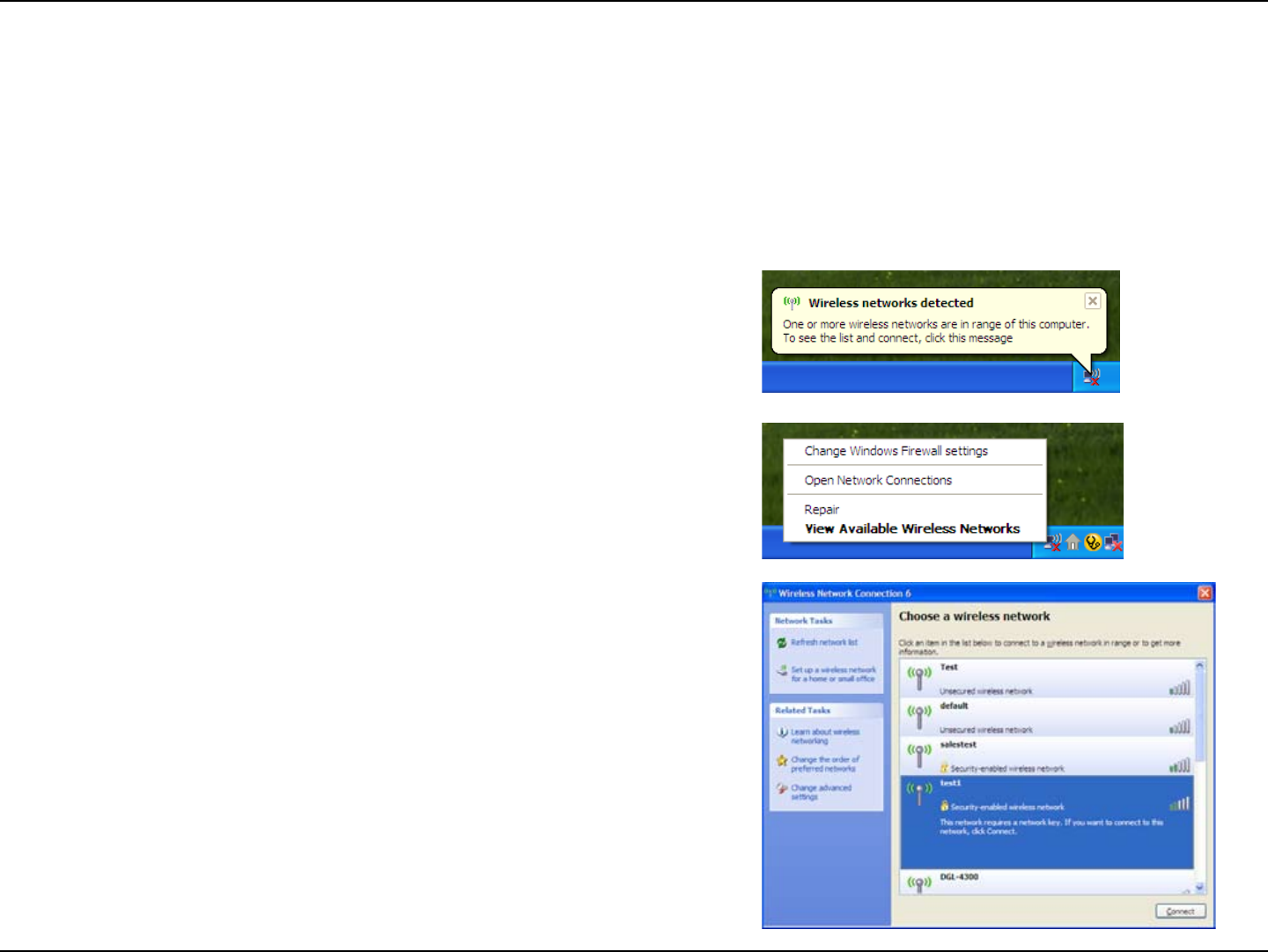
74D-Link DIR-635 User Manual
Section 5 - Connecting to a Wireless Network
Connect to a Wireless Network
Using Windows® XP
Windows® XP users may use the built-in wireless utility (Zero Conguration Utility). The following instructions are for
Service Pack 2 users. If you are using another company’s utility or Windows® 2000, please refer to the user manual
of your wireless adapter for help with connecting to a wireless network. Most utilities will have a “site survey” option
similar to the Windows® XP utility as seen below.
Right-click on the wireless computer icon in your system tray
(lower-right corner next to the time). Select View Available
Wireless Networks.
If you receive the Wireless Networks Detected bubble, click
on the center of the bubble to access the utility.
or
The utility will display any available wireless networks in your
area. Click on a network (displayed using the SSID) and click
the Connect button.
If you get a good signal but cannot access the Internet,
check you TCP/IP settings for your wireless adapter. Refer
to the Networking Basics section in this manual for more
information.
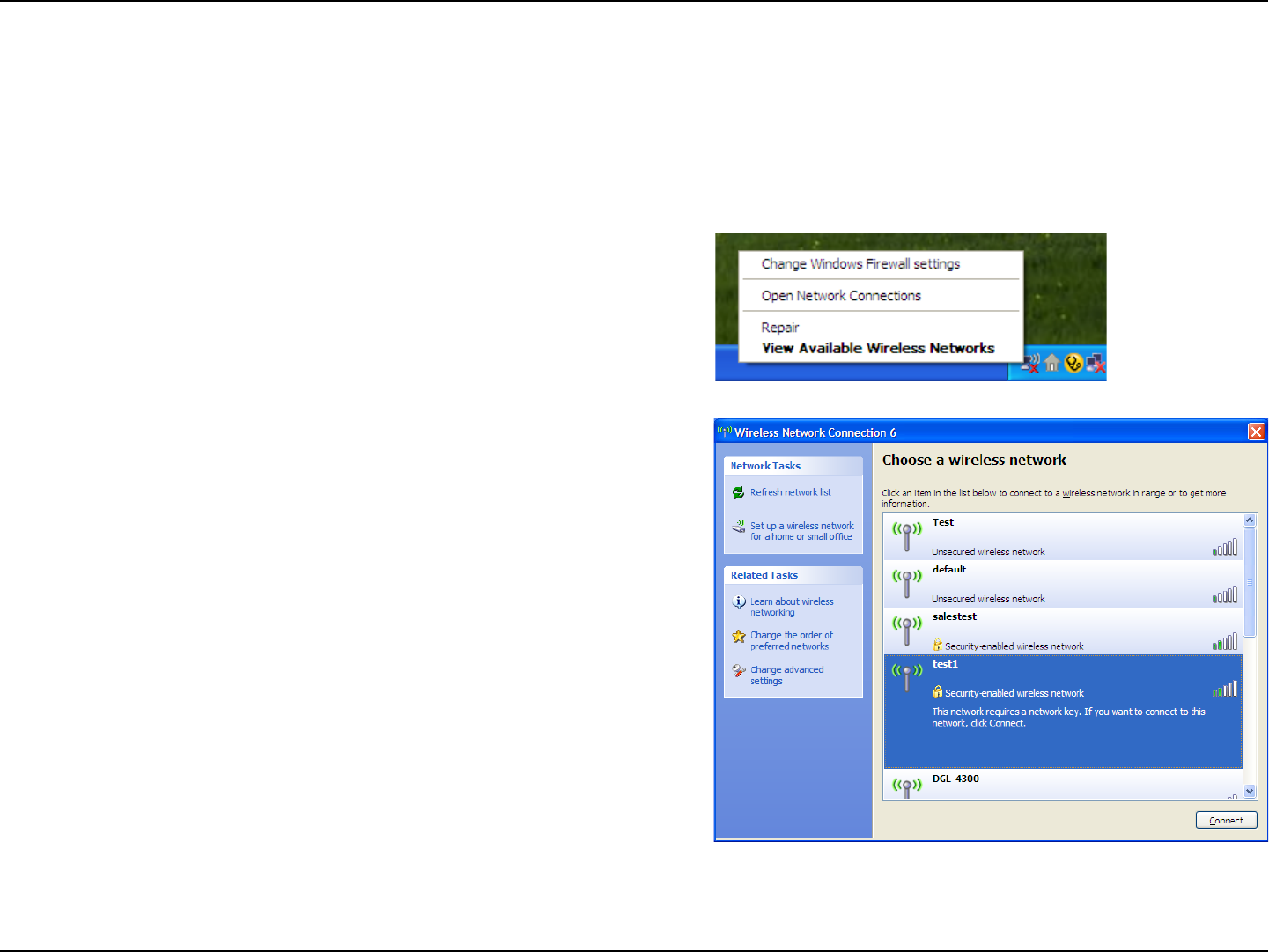
75D-Link DIR-635 User Manual
Section 5 - Connecting to a Wireless Network
Configure WEP
It is recommended to enable WEP on your wireless router or access point before conguring your wireless adapter. If
you are joining an existing network, you will need to know the WEP key being used.
2. Highlight the wireless network (SSID) you would like to
connect to and click Connect.
1. Open the Windows® XP Wireless Utility by right-clicking
on the wireless computer icon in your system tray
(lower-right corner of screen). Select View Available
Wireless Networks.

76D-Link DIR-635 User Manual
Section 5 - Connecting to a Wireless Network
3. The Wireless Network Connection box will appear. Enter the
same WEP key that is on your router and click Connect.
It may take 20-30 seconds to connect to the wireless network. If the
connection fails, please verify that the WEP settings are correct. The
WEP key must be exactly the same as on the wireless router.

77D-Link DIR-635 User Manual
Section 5 - Connecting to a Wireless Network
Configure WPA-PSK
It is recommended to enable WEP on your wireless router or access point before conguring your wireless adapter. If
you are joining an existing network, you will need to know the WEP key being used.
2. Highlight the wireless network (SSID) you would like to
connect to and click Connect.
1. Open the Windows® XP Wireless Utility by right-clicking
on the wireless computer icon in your system tray
(lower-right corner of screen). Select View Available
Wireless Networks.
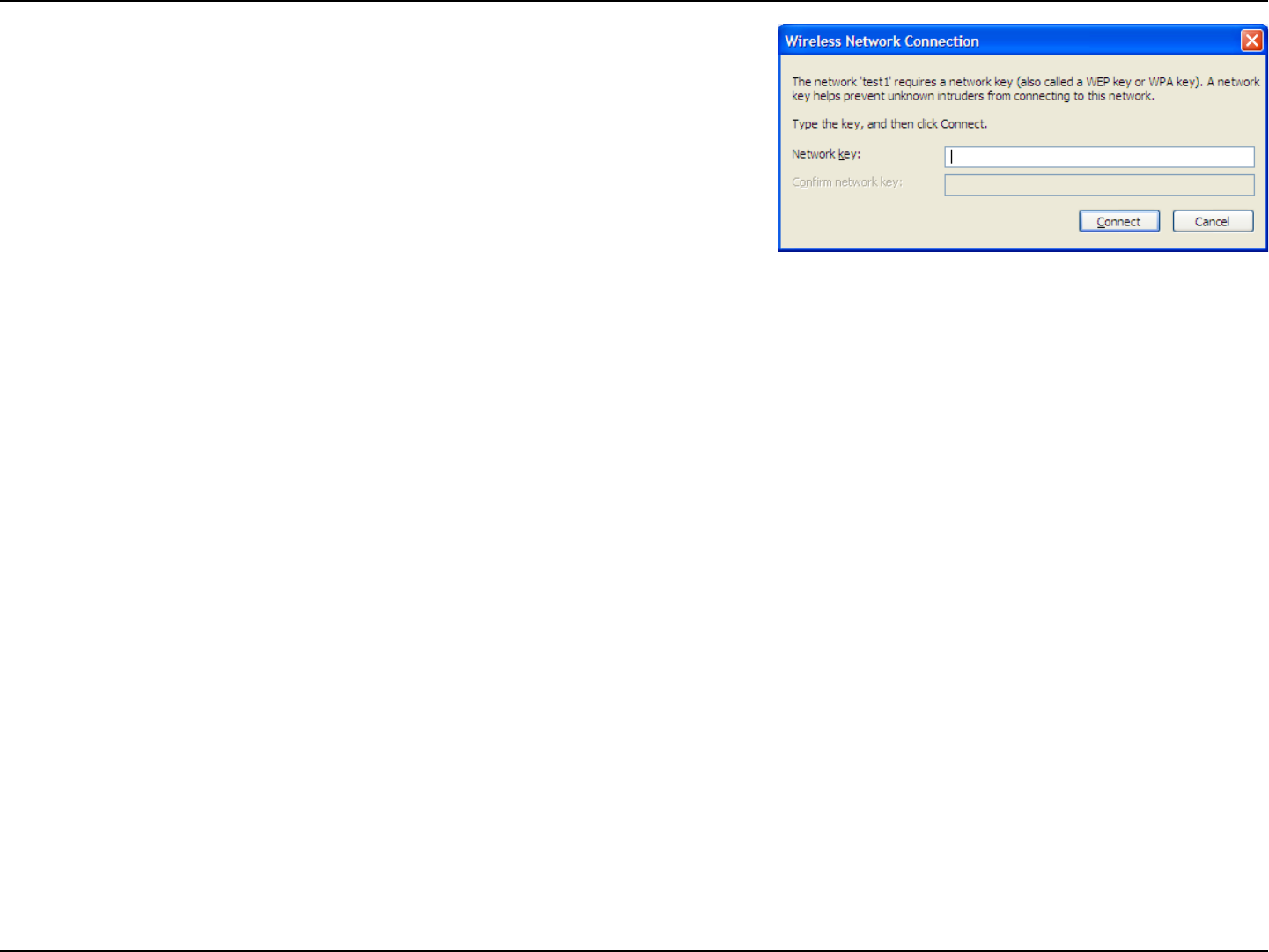
78D-Link DIR-635 User Manual
Section 5 - Connecting to a Wireless Network
3. The Wireless Network Connection box will appear. Enter the
WPA-PSK passphrase and click Connect.
It may take 20-30 seconds to connect to the wireless network. If the
connection fails, please verify that the WPA-PSK settings are correct.
The WPA-PSK passphrase must be exactly the same as on the
wireless router.

79D-Link DIR-635 User Manual
Section 6 - Troubleshooting
Troubleshooting
This chapter provides solutions to problems that can occur during the installation and operation of the DIR-635. Read
the following descriptions if you are having problems. (The examples below are illustrated in Windows® XP. If you
have a different operating system, the screenshots on your computer will look similar to the following examples.)
1. Why can’t I access the web-based conguration utility?
When entering the IP address of the D-Link router (192.168.0.1 for example), you are not connecting to a website on
the Internet or have to be connected to the Internet. The device has the utility built-in to a ROM chip in the device itself.
Your computer must be on the same IP subnet to connect to the web-based utility.
• Make sure you have an updated Java-enabled web browser. We recommend the following:
• Internet Explorer 6.0 or higher
• Netscape 8 or higher
• Mozilla 1.7.12 (5.0) or higher
• Opera 8.5 or higher
• Safari 1.2 or higher (with Java 1.3.1 or higher)
• Camino 0.8.4 or higher
• Firefox 1.5 or higher
• Verify physical connectivity by checking for solid link lights on the device. If you do not get a solid link light, try using
a different cable or connect to a different port on the device if possible. If the computer is turned off, the link light may
not be on.
• Disable any internet security software running on the computer. Software rewalls such as Zone Alarm, Black Ice,
Sygate, Norton Personal Firewall, and Windows® XP rewall may block access to the conguration pages. Check the
help les included with your rewall software for more information on disabling or conguring it.

80D-Link DIR-635 User Manual
Section 6 - Troubleshooting
• Congure your Internet settings:
• Go to Start > Settings > Control Panel. Double-click the Internet Options Icon. From the Security tab,
click the button to restore the settings to their defaults.
• Click the Connection tab and set the dial-up option to Never Dial a Connection. Click the LAN Settings
button. Make sure nothing is checked. Click OK.
• Go to the Advanced tab and click the button to restore these settings to their defaults. Click OK three
times.
• Close your web browser (if open) and open it.
• Access the web management. Open your web browser and enter the IP address of your D-Link router in the address
bar. This should open the login page for your the web management.
• If you still cannot access the conguration, unplug the power to the router for 10 seconds and plug back in. Wait
about 30 seconds and try accessing the conguration. If you have multiple computers, try connecting using a different
computer.
2. What can I do if I forgot my password?
If you forgot your password, you must reset your router. Unfortunately this process will change all your settings back
to the factory defaults.
To reset the router, locate the reset button (hole) on the rear panel of the unit. With the router powered on, use a
paperclip to hold the button down for 10 seconds. Release the button and the router will go through its reboot process.
Wait about 30 seconds to access the router. The default IP address is 192.168.0.1. When logging in, the username is
admin and leave the password box empty.
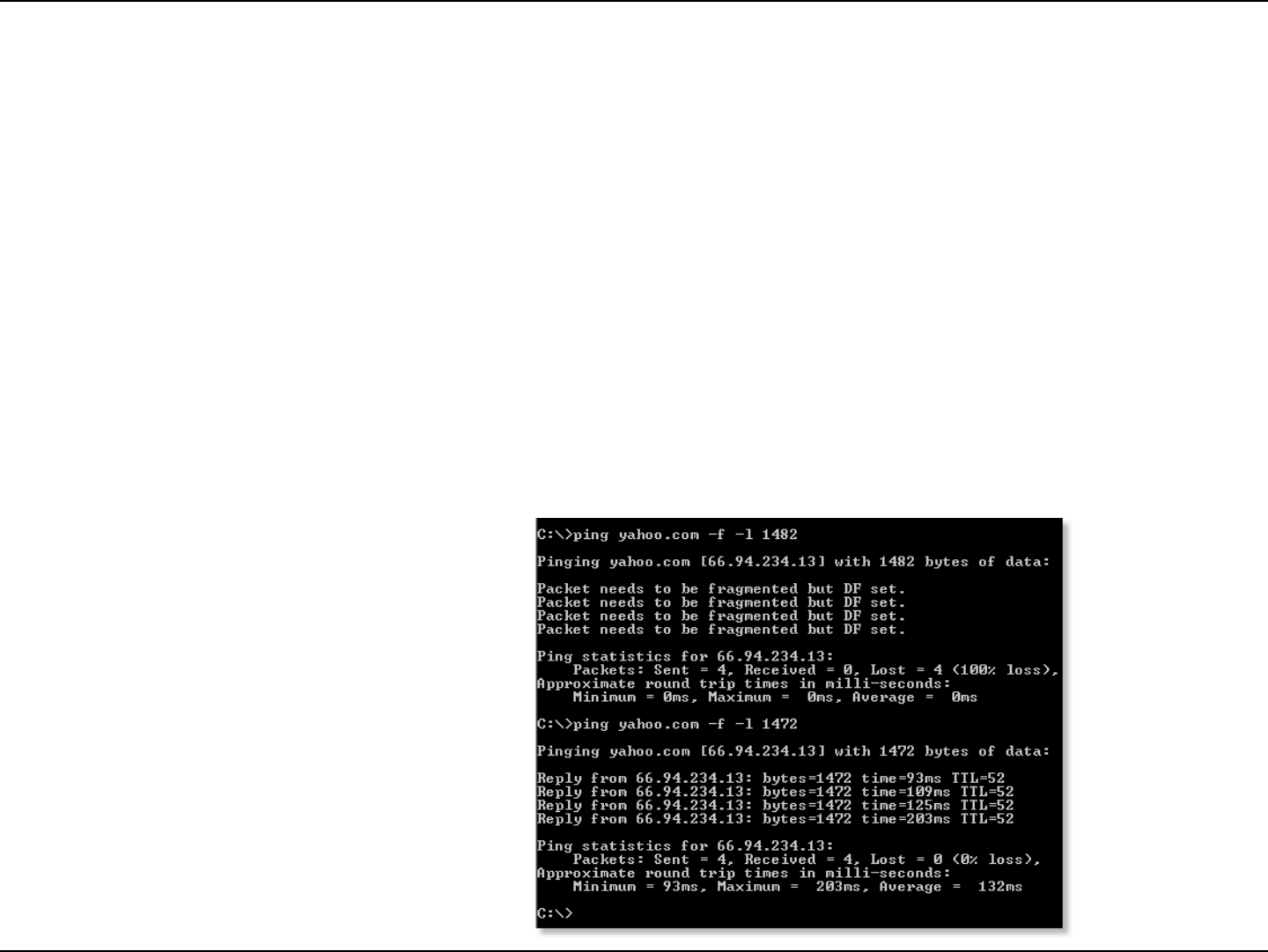
81D-Link DIR-635 User Manual
Section 6 - Troubleshooting
3. Why can’t I connect to certain sites or send and receive emails when connecting through my router?
If you are having a problem sending or receiving email, or connecting to secure sites such as eBay, banking sites, and
Hotmail, we suggest lowering the MTU in increments of ten (Ex. 1492, 1482, 1472, etc).
Note: AOL DSL+ users must use MTU of 1400.
To nd the proper MTU Size, you’ll have to do a special ping of the destination you’re trying to go to. A destination
could be another computer, or a URL.
• Click on Start and then click Run.
• Windows® 95, 98, and Me users type in command (Windows® NT, 2000, and XP users type in cmd) and
press Enter (or click OK).
• Once the window opens, you’ll need to do a special ping. Use the following syntax:
ping [url] [-f] [-l] [MTU value]
Example: ping yahoo.com -f -l 1472

82D-Link DIR-635 User Manual
Section 6 - Troubleshooting
You should start at 1472 and work your way down by 10 each time. Once you get a reply, go up by 2 until you get a
fragmented packet. Take that value and add 28 to the value to account for the various TCP/IP headers. For example,
lets say that 1452 was the proper value, the actual MTU size would be 1480, which is the optimum for the network
we’re working with (1452+28=1480).
Once you nd your MTU, you can now congure your router with the proper MTU size.
To change the MTU rate on your router follow the steps below:
• Open your browser, enter the IP address of your router (192.168.0.1) and click OK.
• Enter your username (admin) and password (blank by default). Click OK to enter the web conguration
page for the device.
• Click on Setup and then click Manual Congure.
• To change the MTU enter the number in the MTU eld and click Save Settings to save your settings.
• Test your email. If changing the MTU does not resolve the problem, continue changing the MTU in
increments of ten.

83D-Link DIR-635 User Manual
Appendix A - Wireless Basics
D-Link wireless products are based on industry standards to provide easy-to-use and compatible high-speed wireless
connectivity within your home, business or public access wireless networks. Strictly adhering to the IEEE standard,
the D-Link wireless family of products will allow you to securely access the data you want, when and where you want
it. You will be able to enjoy the freedom that wireless networking delivers.
A wireless local area network (WLAN) is a cellular computer network that transmits and receives data with radio signals
instead of wires. Wireless LANs are used increasingly in both home and ofce environments, and public areas such
as airports, coffee shops and universities. Innovative ways to utilize WLAN technology are helping people to work and
communicate more efciently. Increased mobility and the absence of cabling and other xed infrastructure have proven
to be benecial for many users.
Wireless users can use the same applications they use on a wired network. Wireless adapter cards used on laptop
and desktop systems support the same protocols as Ethernet adapter cards.
Under many circumstances, it may be desirable for mobile network devices to link to a conventional Ethernet LAN in
order to use servers, printers or an Internet connection supplied through the wired LAN. A Wireless Router is a device
used to provide this link.
Wireless Basics

84D-Link DIR-635 User Manual
Appendix A - Wireless Basics
What is Wireless?
Wireless or Wi-Fi technology is another way of connecting your computer to the network without using wires. Wi-Fi
uses radio frequency to connect wirelessly, so you have the freedom to connect computers anywhere in your home
or ofce network.
Why D-Link Wireless?
D-Link is the worldwide leader and award winning designer, developer, and manufacturer of networking products.
D-Link delivers the performance you need at a price you can afford. D-Link has all the products you need to build your
network.
How does wireless work?
Wireless works similar to how cordless phone work, through radio signals to transmit data from one point A to point
B. But wireless technology has restrictions as to how you can access the network. You must be within the wireless
network range area to be able to connect your computer. There are two different types of wireless networks Wireless
Local Area Network (WLAN), and Wireless Personal Area Network (WPAN).
Wireless Local Area Network (WLAN)
In a wireless local area network, a device called an Access Point (AP) connects computers to the network. The access
point has a small antenna attached to it, which allows it to transmit data back and forth over radio signals. With an
indoor access point as seen in the picture, the signal can travel up to 300 feet. With an outdoor access point the signal
can reach out up to 30 miles to serve places like manufacturing plants, industrial locations, college and high school
campuses, airports, golf courses, and many other outdoor venues.

85D-Link DIR-635 User Manual
Appendix A - Wireless Basics
Wireless Personal Area Network (WPAN)
Bluetooth is the industry standard wireless technology used for WPAN. Bluetooth devices in WPAN operate in a range
up to 30 feet away.
Compared to WLAN the speed and wireless operation range are both less than WLAN, but in return it doesn’t use
nearly as much power which makes it ideal for personal devices, such as mobile phones, PDAs, headphones, laptops,
speakers, and other devices that operate on batteries.
Who uses wireless?
Wireless technology as become so popular in recent years that almost everyone is using it, whether it’s for home,
ofce, business, D-Link has a wireless solution for it.
Home
• Gives everyone at home broadband access
• Surf the web, check email, instant message, and etc
• Gets rid of the cables around the house
• Simple and easy to use
Small Ofce and Home Ofce
• Stay on top of everything at home as you would at ofce
• Remotely access your ofce network from home
• Share Internet connection and printer with multiple computers
• No need to dedicate ofce space

86D-Link DIR-635 User Manual
Appendix A - Wireless Basics
Where is wireless used?
Wireless technology is expanding everywhere not just at home or ofce. People like the freedom of mobility and it’s
becoming so popular that more and more public facilities now provide wireless access to attract people. The wireless
connection in public places is usually called “hotspots”.
Using a D-Link Cardbus Adapter with your laptop, you can access the hotspot to connect to Internet from remote
locations like: Airports, Hotels, Coffee Shops, Libraries, Restaurants, and Convention Centers.
Wireless network is easy to setup, but if you’re installing it for the rst time it could be quite a task not knowing where to
start. That’s why we’ve put together a few setup steps and tips to help you through the process of setting up a wireless
network.
Tips
Here are a few things to keep in mind, when you install a wireless network.
Centralize your router or Access Point
Make sure you place the router/access point in a centralized location within your network for the best performance. Try
to place the router/access point as high as possible in the room, so the signal gets dispersed throughout your home.
If you have a two-story home, you may need a repeater to boost the signal to extend the range.
Eliminate Interference
Place home appliances such as cordless telephones, microwaves, and televisions as far away as possible from the
router/access point. This would signicantly reduce any interference that the appliances might cause since they operate
on same frequency.

87D-Link DIR-635 User Manual
Appendix A - Wireless Basics
Security
Don’t let you next-door neighbors or intruders connect to your wireless network. Secure your wireless network by turning
on the WPA or WEP security feature on the router. Refer to product manual for detail information on how to set it up.
There are basically two modes of networking:
• Infrastructure – All wireless clients will connect to an access point or wireless router.
• Ad-Hoc – Directly connecting to another computer, for peer-to-peer communication, using wireless network
adapters on each computer, such as two or more DIR-635 wireless network Cardbus adapters.
An Infrastructure network contains an Access Point or wireless router. All the wireless devices, or clients, will connect
to the wireless router or access point.
An Ad-Hoc network contains only clients, such as laptops with wireless cardbus adapters. All the adapters must be in
Ad-Hoc mode to communicate.
Wireless Modes
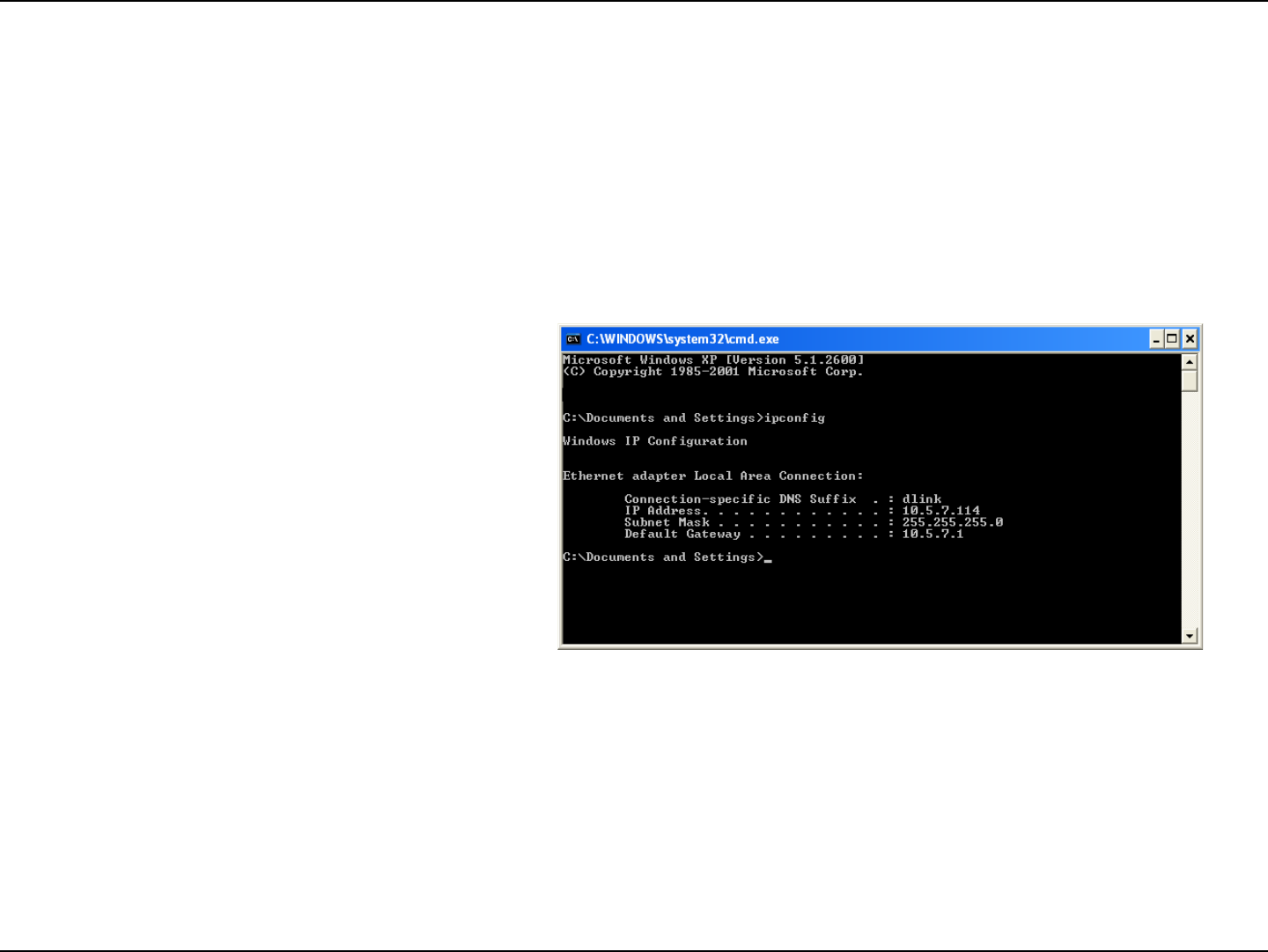
88D-Link DIR-635 User Manual
Appendix B - Networking Basics
Networking Basics
Check your IP address
After you install your new D-Link adapter, by default, the TCP/IP settings should be set to obtain an IP address from
a DHCP server (i.e. wireless router) automatically. To verify your IP address, please follow the steps below.
Click on Start > Run. In the run box type cmd and click OK. (Windows® Vista users type cmd in the Start Seach
box.)
At the prompt, type ipconfig and press Enter.
This will display the IP address, subnet mask, and
the default gateway of your adapter.
If the address is 0.0.0.0, check your adapter
installation, security settings, and the settings
on your router. Some rewall software programs
may block a DHCP request on newly installed
adapters.

89D-Link DIR-635 User Manual
Appendix B - Networking Basics
Statically Assign an IP address
If you are not using a DHCP capable gateway/router, or you need to assign a static IP address, please follow the steps
below:
Step 1
Windows® Vista - Click on Start > Control Panel > Network and Internet > Network and Sharing Center > Manage
Network Connections.
Windows® XP - Click on Start > Control Panel > Network Connections.
Windows® 2000 - From the desktop, right-click My Network Places > Properties.
Step 2
Right-click on the Local Area Connection which represents your network adapter and select Properties.
Step 3
Highlight Internet Protocol (TCP/IP) and click Properties.
Step 4
Click Use the following IP address and enter an IP address that is on the same
subnet as your network or the LAN IP address on your router.
Example: If the router´s LAN IP address is 192.168.0.1, make your IP address
192.168.0.X where X is a number between 2 and 99. Make sure that the number
you choose is not in use on the network. Set Default Gateway the same as the LAN
IP address of your router (192.168.0.1).
Set Primary DNS the same as the LAN IP address of your router (192.168.0.1). The
Secondary DNS is not needed or you may enter a DNS server from your ISP.
Step 5
Click OK twice to save your settings.

90D-Link DIR-635 User Manual
Appendix C - Technical Specifications
Technical Specifications
Standards
• IEEE 802.11n (draft)
• IEEE 802.11g
• IEEE 802.11b
• IEEE 802.3
• IEEE 802.3u
Security
• WPA-Personal
• WPA2-Personal
• WPA-Enterprise
• WPA2-Enterprise
• 64/128-bit WEP
Wireless Signal Rates*
• 108Mbps • 48Mbps
• 54Mbps • 24Mbps
• 36Mbps • 12Mbps
• 18Mbps • 9Mbps
• 11Mbps • 5.5Mbps
• 6Mbps • 1Mbps
• 2Mbps
MSC (0-15)
• 130Mbps (270) • 117Mbps (243)
• 104Mbps (216) • 78Mbps (162)
• 66Mbps (135) • 58.5Mbps (121.5)
• 52Mbps (108) • 39Mbps (81)
• 26Mbps (54) • 19.5Mbps (40.5)
• 12Mbps (27) • 6.5Mbps (13.5)
Frequency Range
2.4GHz to 2.483GHz
External Antenna Type
Three (3) detachable reverse SMA Antennas
LEDs
• Power • Internet • Status
• WLAN • LAN (10/100) • USB
Operating Temperature
32°F to 104°F ( 0°C to 40°C)
Humidity
95% maximum (non-condensing)
Safety & Emissions
• FCC
Dimensions
• L = 7.6 inches
• W = 4.6 inches
• H = 1.2inches
Warranty
1 Year
* Maximum wireless signal rate derived from IEEE Standard 802.11g and Draft 802.11n specications. Actual data throughput will vary. Network conditions and
environmental factors, including volume of network trafc, building materials and construction, and network overhead, lower actual data throughput rate. Environmental
factors will adversely affect wireless signal range.

D-Link DIR-635 User Manual
This equipment has been tested and found to comply with the limits for a Class B digital device, pursuant
to Part 15 of the FCC Rules. These limits are designed to provide reasonable protection against harmful
interference in a residential installation. This equipment generates, uses and can radiate radio frequency
energy and, if not installed and used in accordance with the instructions, may cause harmful interference
to radio communications. However, there is no guarantee that interference will not occur in a particular
installation. If this equipment does cause harmful interference to radio or television reception, which can
be determined by turning the equipment off and on, the user is encouraged to try to correct the
interference by one of the following measures:
Reorient or relocate the receiving antenna.
Increase the separation between the equipment and receiver.
Connect the equipment into an outlet on a circuit different from that to which the receiver is connected.
Consult the dealer or an experienced radio/TV technician for help.
FCC Caution: Any changes or modifications not expressly approved by the party responsible for compliance
could void the user's authority to operate this equipment.
This device complies with Part 15 of the FCC Rules. Operation is subject to the following two conditions:
(1) This device may not cause harmful interference, and (2) this device must accept any interference
received, including interference that may cause undesired operation.
IMPORTANT NOTE:
FCC Radiation Exposure Statement:
This equipment complies with FCC radiation exposure limits set forth for an uncontrolled environment. This
equipment should be installed and operated with minimum distance 20cm between the radiator & your body.
This transmitter must not be co-located or operating in conjunction with any other antenna or transmitter.
The availability of some specific channels and/or operational frequency bands are country dependent and
are firmware programmed at the factory to match the intended destination. The firmware setting is not
accessible by the end user.
•
•
•
•
Federal Communication Commission Interference Statement

D-Link DIR-635 User Manual
This device complies with the essential requirements of the R&TTE Directive 1999/5/EC. The following test
methods have been applied in order to prove presumption of conformity with the essential requirements of
the R&TTE Directive 1999/5/EC:
EN 60950-1: 2006
Safety of Information Technology Equipment
EN 50385: 2002
Product standard to demonstrate the compliance of radio base stations and fixed terminal stations for
wireless telecommunication systems with the basic restrictions or the reference levels related to human
exposure to radio frequency electromagnetic fields (110MHz - 40 GHz) - General public
EN 300 328 V1.7.1 (2006-10)
Electromagnetic compatibility and Radio spectrum Matters (ERM); Wideband transmission systems;
Data transmission equipment operating in the 2,4 GHz ISM band and using wide band modulation
techniques; Harmonized EN covering essential requirements under article 3.2 of the R&TTE Directive
EN 301 489-1 V1.6.1 (2005-09)
Electromagnetic compatibility and Radio Spectrum Matters (ERM); ElectroMagnetic Compatibility (EMC)
standard for radio equipment and services; Part 1: Common technical requirements
EN 301 489-17 V1.2.1 (2002-08)
Electromagnetic compatibility and Radio spectrum Matters (ERM); ElectroMagnetic Compatibility (EMC)
standard for radio equipment and services; Part 17: Specific conditions for 2,4 GHz wideband transmission
systems and 5 GHz high performance RLAN equipment
This device is a 2.4 GHz wideband transmission system (transceiver), intended for use in all EU member
states and EFTA countries, except in France and Italy where restrictive use applies.
Europe – EU Declaration of Conformity

D-Link DIR-635 User Manual
In Italy the end-user should apply for a license at the national spectrum authorities in order to obtain
authorization to use the device for setting up outdoor radio links and/or for supplying public access to
telecommunications and/or network services.
This device may not be used for setting up outdoor radio links in France and in some areas the RF output
power may be limited to 10 mW EIRP in the frequency range of 2454 – 2483.5 MHz. For detailed
information the end-user should contact the national spectrum authority in France.

D-Link DIR-635 User Manual
Česky [Czech] [Jméno výrobce] tímto prohlašuje, že tento [typ zařízení] je ve shodě se základními požadavky a dalšími příslušnými ustanoveními
směrnice 1999/5/ES.
Dansk [Danish] Undertegnede [fabrikantens navn] erklærer herved, at følgende udstyr [udstyrets typebetegnelse] overholder de væsentlige krav
og øvrige relevante krav i direktiv 1999/5/EF.
Deutsch [German] Hiermit erklärt [Name des Herstellers], dass sich das Gerät [Gerätetyp] in Übereinstimmung mit den grundlegenden
Anforderungen und den übrigen einschlägigen Bestimmungen der Richtlinie 1999/5/EG befindet.
Eesti [Estonian] Käesolevaga kinnitab [tootja nimi = name of manufacturer] seadme [seadme tüüp = type of equipment] vastavust direktiivi
1999/5/EÜ põhinõuetele ja nimetatud direktiivist tulenevatele teistele asjakohastele sätetele.
English Hereby, [name of manufacturer], declares that this [type of equipment] is in compliance with the essential requirements and other
relevant provisions of Directive 1999/5/EC.
Español [Spanish] Por medio de la presente [nombre del fabricante] declara que el [clase de equipo] cumple con los requisitos esenciales y
cualesquiera otras disposiciones aplicables o exigibles de la Directiva 1999/5/CE.
Ελληνική [Greek] ΜΕ ΤΗΝ ΠΑΡΟΥΣΑ [name of manufacturer] ΔΗΛΩΝΕΙ ΟΤΙ [type of equipment] ΣΥΜΜΟΡΦΩΝΕΤΑΙ ΠΡΟΣ ΤΙΣ ΟΥΣΙΩΔΕΙΣ
ΑΠΑΙΤΗΣΕΙΣ ΚΑΙ ΤΙΣ ΛΟΙΠΕΣ ΣΧΕΤΙΚΕΣ ΔΙΑΤΑΞΕΙΣ ΤΗΣ ΟΔΗΓΙΑΣ 1999/5/ΕΚ.
Français [French] Par la présente [nom du fabricant] déclare que l'appareil [type d'appareil] est conforme aux exigences essentielles et aux autres
dispositions pertinentes de la directive 1999/5/CE.
Italiano [Italian] Con la presente [nome del costruttore] dichiara che questo [tipo di apparecchio] è conforme ai requisiti essenziali ed alle altre
disposizioni pertinenti stabilite dalla direttiva 1999/5/CE.
Latviski [Latvian] Ar šo [name of manufacturer / izgatavotāja nosaukums] deklarē, ka [type of equipment / iekārtas tips] atbilst Direktīvas 1999/5/EK
būtiskajām prasībām un citiem ar to saistītajiem noteikumiem.
Lietuvių [Lithuanian] Šiuo [manufacturer name] deklaruoja, kad šis [equipment type] atitinka esminius reikalavimus ir kitas 1999/5/EB Direktyvos
nuostatas.
Nederlands [Dutch] Hierbij verklaart [naam van de fabrikant] dat het toestel [type van toestel] in overeenstemming is met de essentiële eisen en de
andere relevante bepalingen van richtlijn 1999/5/EG.
Malti [Maltese] Hawnhekk, [isem tal-manifattur], jiddikjara li dan [il-mudel tal-prodott] jikkonforma mal-ħtiġijiet essenzjali u ma provvedimenti oħrajn
relevanti li hemm fid-Dirrettiva 1999/5/EC.
Magyar [Hungarian] Alulírott, [gyártó neve] nyilatkozom, hogy a [... típus] megfelel a vonatkozó alapvetõ követelményeknek és az 1999/5/EC irányelv
egyéb elõírásainak.
Polski [Polish] Niniejszym [nazwa producenta] oświadcza, że [nazwa wyrobu] jest zgodny z zasadniczymi wymogami oraz pozostałymi
stosownymi postanowieniami Dyrektywy 1999/5/EC.
Português
[Portuguese] [Nome do fabricante] declara que este [tipo de equipamento] está conforme com os requisitos essenciais e outras disposições da
Directiva 1999/5/CE.
Slovensko [Slovenian] [Ime proizvajalca] izjavlja, da je ta [tip opreme] v skladu z bistvenimi zahtevami in ostalimi relevantnimi določili direktive 1999/5/ES.
Slovensky [Slovak] [Meno výrobcu] týmto vyhlasuje, že [typ zariadenia] spĺňa základné požiadavky a všetky príslušné ustanovenia Smernice
1999/5/ES.
Suomi [Finnish] [Valmistaja = manufacturer] vakuuttaa täten että [type of equipment = laitteen tyyppimerkintä] tyyppinen laite on direktiivin
1999/5/EY oleellisten vaatimusten ja sitä koskevien direktiivin muiden ehtojen mukainen.
Svenska [Swedish] Härmed intygar [företag] att denna [utrustningstyp] står I överensstämmelse med de väsentliga egenskapskrav och övriga
cs
da
de
et
en
es
el
fr
it
nl
mt
hu
sl
fi
sv
pl
pt